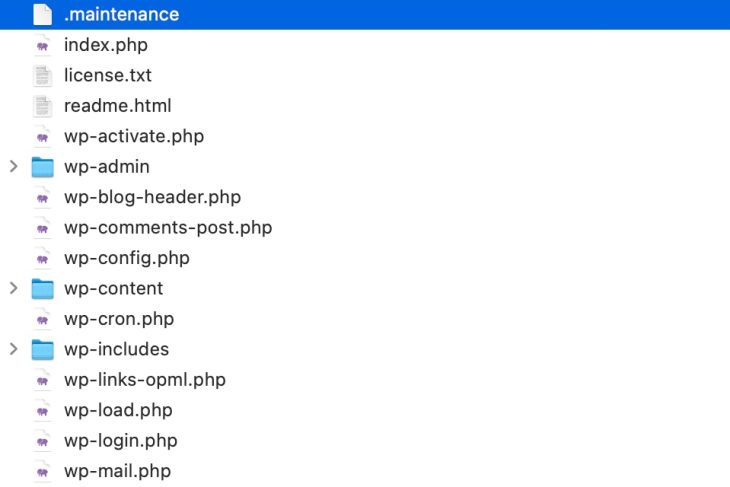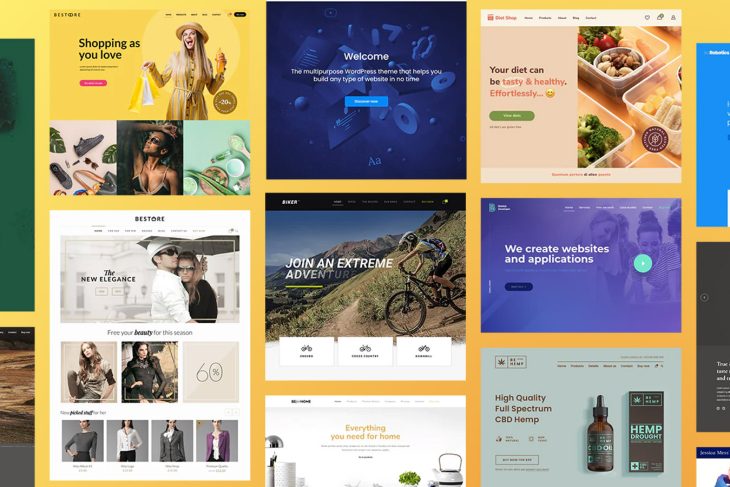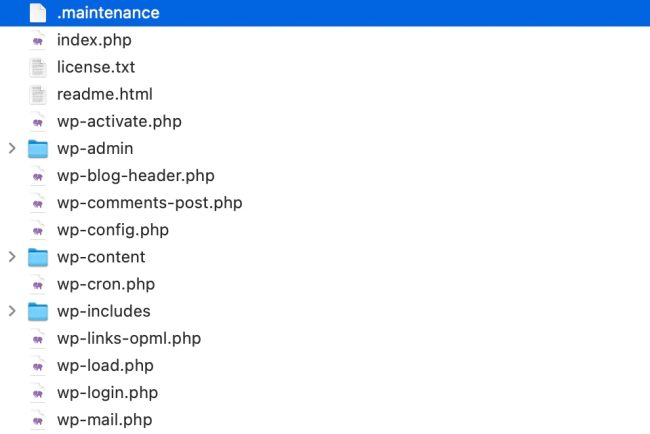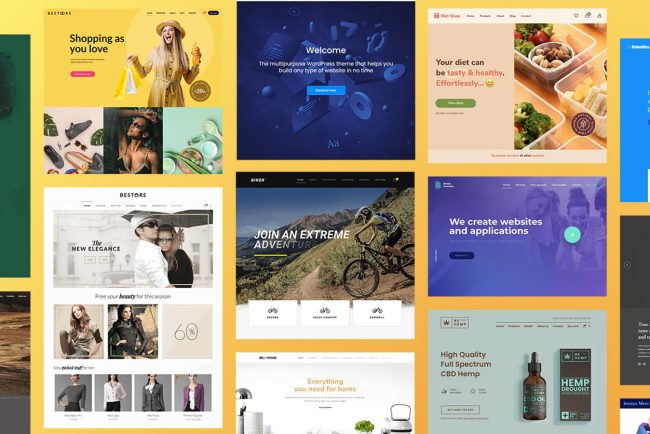
How to Render Templates in Flask
Flask is a lightweight web framework for Python that makes it easy to build web applications. In our previous article, we’ve seen how to set up a simple page. But, it’s just a simple text like “Hello Flask!”. In real applications, you’ll want to render […]
Coding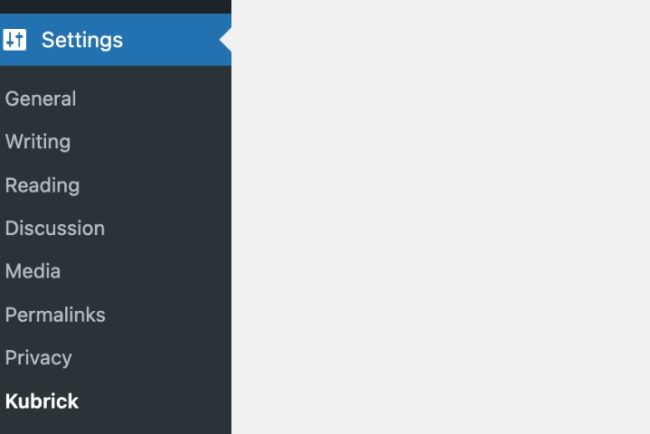
How to Create a WordPress Settings Page with React
While building some plugins, I figured creating dynamic applications in WordPress Admin is much easier with React components compared to using PHP and jQuery like back in the old days. However, integrating React components with WordPress Admin can be a bit challenging, especially when it […]
Wordpress
It’s Here! How To Measure UX & Design Impact, With Vitaly Friedman
It’s Here! How To Measure UX & Design Impact, With Vitaly Friedman It’s Here! How To Measure UX & Design Impact, With Vitaly Friedman Vitaly Friedman 2024-10-15T14:00:00+00:00 2025-03-04T21:34:45+00:00 Finally! After so many years, we’re very happy to launch “How To Measure UX and Design Impact”, […]
Ux
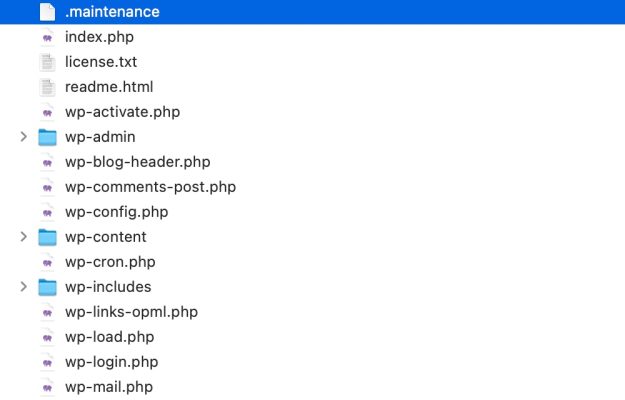



20 Best Parallax WordPress Themes for 2024
Parallax scrolling continues to charm users with its captivating, 3D-like experience in our digital world. As we continue to navigate through 2024 , this engaging design technique’s popularity shows no signs of fading away. In this blog post, we’ll look into the cream of the […]
WordpressParallax scrolling continues to charm users with its captivating, 3D-like experience in our digital world. As we continue to navigate through 2024 , this engaging design technique’s popularity shows no signs of fading away.
In this blog post, we’ll look into the cream of the crop when it comes to WordPress themes that feature parallax scrolling. No matter if you’re a blogger, business owner, or web designer, our list has a theme that will fit your needs and keep your audience engaged. So, sit tight and get ready to explore our hand-picked list of the 20 best Parallax WordPress themes for 2024.
Demeter

The Demeter WordPress theme is a one-page parallax option, ideal for businesses, creative agencies, and portfolios. It simplifies website creation and offers a range of customization options. Users can choose from 11 different style variants to suit their needs.
The theme integrates the Visual Composer Page Builder and over 20 web elements for easy customization. This allows for the creation of a personalized color scheme and an engaging user experience with the Revolution Slider.
Demeter is also translation-ready and supports multilingual content, making it a good choice for a global audience. It includes a filterable portfolio and a variety of project display options for effective work showcasing.
The theme boosts user interaction with on-scroll effects and parallax backgrounds. Its retina-ready graphics ensure that your site appears clear and vibrant on all screens.
Ananke
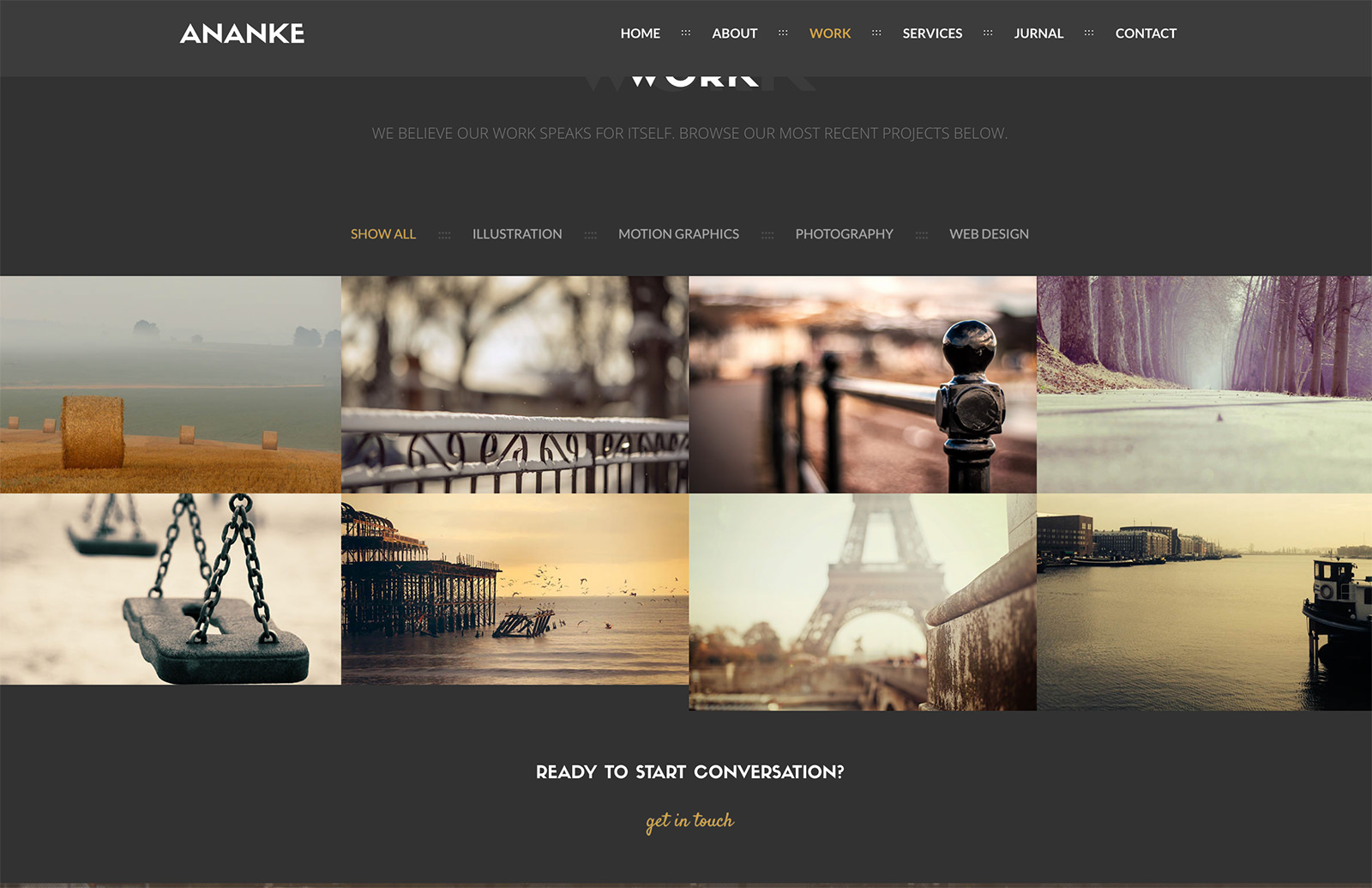
Ananke is a WordPress theme ideal for personal portfolios and creative agencies. It boasts a modern design with intricate animations for a professional appearance. This theme is responsive and customizable, ensuring cross-device compatibility and easy image and text replacement.
The theme offers eight home page variations and a one-click demo import for easy setup. It comes with a Visual Composer Page Builder and over 23 elements, making site creation a breeze. Ananke also supports unlimited color styles for personalization.
Key features of Ananke include a fully responsive layout, filterable portfolios, animated icons, and smooth scrolling. It’s SEO optimized and supports Google Fonts and Contact Form 7. The theme is built with HTML5 and CSS3. Ananke perfectly blends aesthetics and functionality, making it ideal for displaying creative work.
Heylone

Heylone is a one-page WordPress theme ideal for business, portfolio, and personal websites. It offers a modern, responsive design that enhances professional online presence. Known for its customizable layout and ease of use, users can manage page orders and portfolio items through a simple drag-and-drop interface. The theme is built on Twitter Bootstrap, ensuring its compatibility across various devices and screen sizes.
The theme provides three homepage variations and 12 color schemes, with unlimited color customization. It also includes a functional contact form and an expandable portfolio section for effective work showcase.
Focused on performance and user experience, Heylone features carousel effects and full-width video support. It is also SEO optimized. Other features include responsive pricing tables and Twitter feed integration. Its compatibility with Bootstrap and WPML makes it a versatile choice for diverse website projects.
Monolit
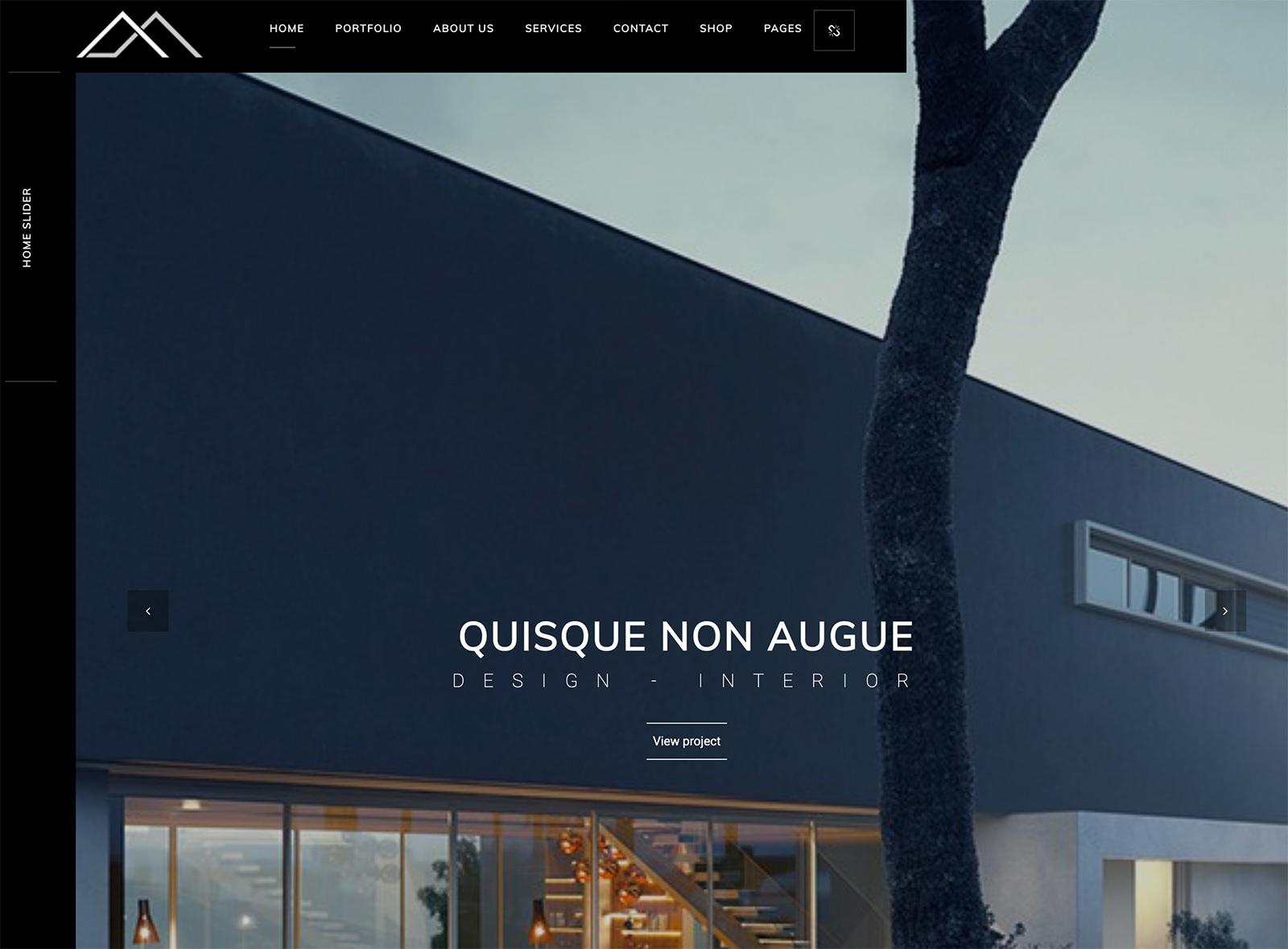
Monolit is a contemporary WordPress theme ideal for architects, furniture designers, and photographers. It’s designed to showcase architectural and design portfolios, as well as photography collections. The theme is compatible with WordPress 5 and boasts fast load speed for a seamless user experience.
The theme comes with the WPBakery Drop & Drag Page Builder, allowing for easy customization. It offers multiple home page styles and customizable portfolio pages.
Monolit also supports Contact Form 7 and provides parallax effects. In addition, it includes SEO optimization for better visibility on search engines. Built on the reliable Bootstrap Framework, Monolit ensures a robust and dependable website.
Linx
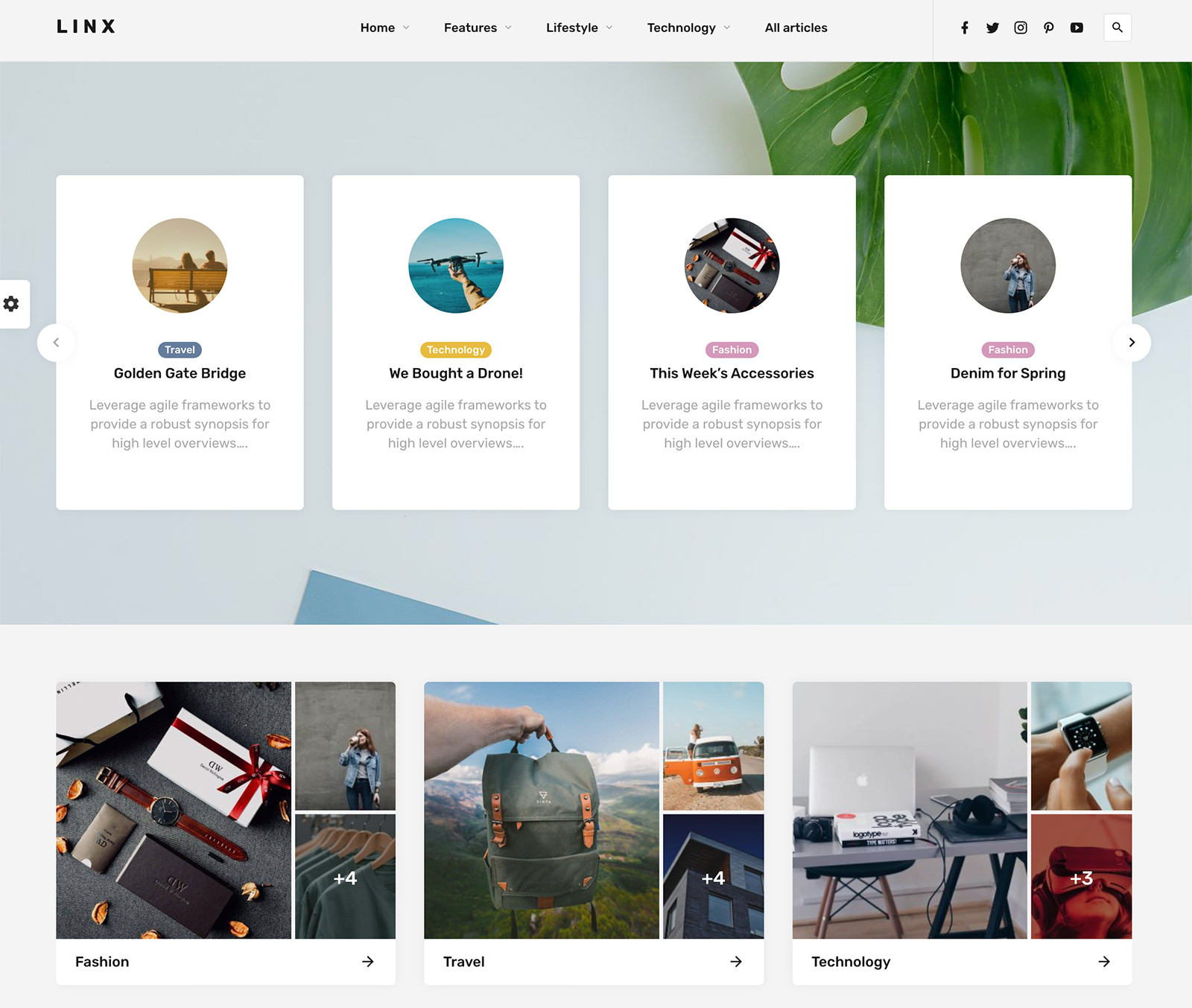
Linx is a sleek, user-friendly theme designed for bloggers and magazine sites. It supports a variety of blog styles such as fashion, food, and travel. Users can import demos, customize them, or start from scratch.
The theme offers multiple post layout options and color branding. It also includes features such as post views and likes, social sharing, and a ‘Read later’ option.
Linx is fully responsive and comes with custom widgets and an Instagram feed. It also features a comprehensive index page. This theme is suitable for both experienced bloggers and beginners.
AV Studio
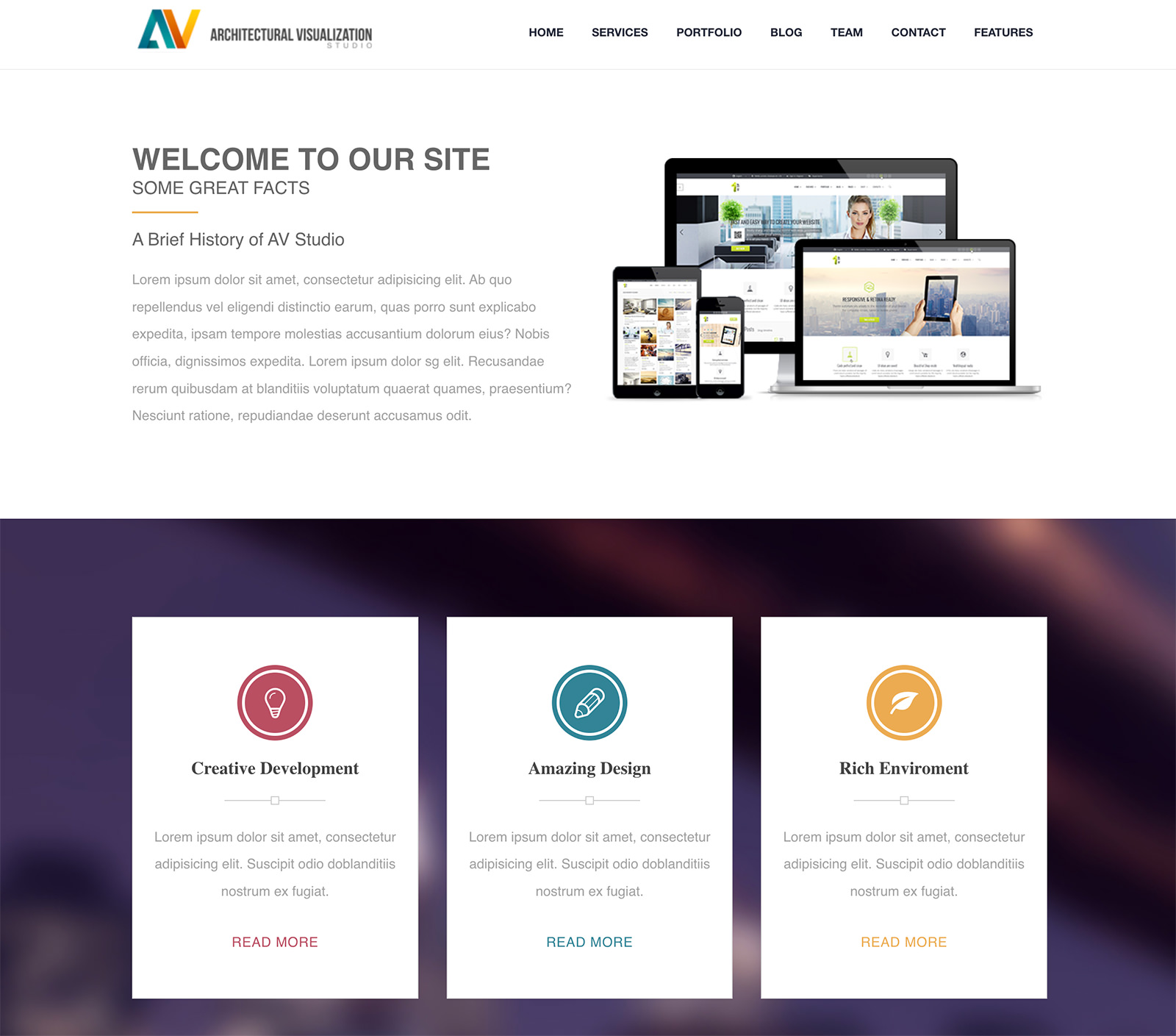
AV Studio is a responsive WordPress theme, perfect for displaying company profiles, portfolios, and creative work. It’s designed to function seamlessly on any device, providing a user-friendly experience.
The theme offers extensive customization options. These include unlimited layout and color variations, allowing you to tailor the design to your needs.
Built using HTML5 and CSS3, AV Studio boasts a modern aesthetic. It also features a dynamic parallax one-page template and retina-ready capabilities for high-quality images.
The theme is SEO optimized and supports Fontello icon fonts and Google Fonts. This ensures varied and attractive typography.
Files are well-organized and commented for easy customization. Plus, the theme is cross-browser compatible, ensuring it works flawlessly on any browser.
Archi

Archi offers an advanced platform to display your work with a selection of 24 Home Pages and 5 Landing Pages. It comes in both Dark and Light versions to suit your preference.
The theme features a user-friendly interface, complete with WPBakery Page Builder and over 50 custom web elements. This ensures a seamless website-building experience.
Archi supports WooCommerce integration, allowing for easy online selling. The design is responsive, ensuring a smooth appearance across all devices.
Additional features include an Isotope filterable gallery, 800+ Google Web Fonts, and 675 Font Awesome Icons. Archi is also translation-ready, supports RTL layouts, and is built with Bootstrap 3.X.
Oblo

Oblo is a modern, minimalist WordPress theme designed by the bslthemes Team. Tailored for creative professionals such as architects and artists, it is compatible with the latest WordPress version and features the Visual Drag & Drop Elementor Page builder for easy customization.
This theme offers unlimited Header & Footer Elementor Builder and includes over 5 pre-built demos, 35+ custom Elementor widgets, and 30+ pre-built pages. It is fully responsive and supports WooCommerce.
Oblo also includes a portfolio with various layouts. It is translation-ready, supports child themes, and comes with comprehensive documentation.
Oreades

Oreades is a minimalist, one-page WordPress theme designed for creative professionals and businesses. It boasts a clean, modern design that emphasizes your content. It also has customizable features such as project pages, a drag-and-drop page builder, and a unique color scheme creator.
The theme supports multilingual content and includes a filterable portfolio. It’s fully responsive, ensuring optimal viewing on all devices.
Additionally, Oreades is SEO optimized and integrates with Contact Form 7. It also offers over 400 icons. The theme is built with HTML5 and CSS3 and offers parallax one-page and background effects.
Hera

Hera is a versatile theme ideal for personal bloggers, creative agencies, and photographers. It boasts a customizable design that works flawlessly on any device, and includes ten distinct home page versions and adjustable headers. The theme also features a user-friendly drag-and-drop page builder.
Additionally, Hera offers unlimited color styles and a Revolution Slider for showcasing content. It is SEO optimized, supporting multilingual content and a filterable portfolio for displaying work.
Finally, Hera enhances user experience with an on-scroll effect layout, parallax one-page and background, and smooth scrolling. It’s a theme that combines functionality and aesthetics for an engaging digital experience.
Seppo
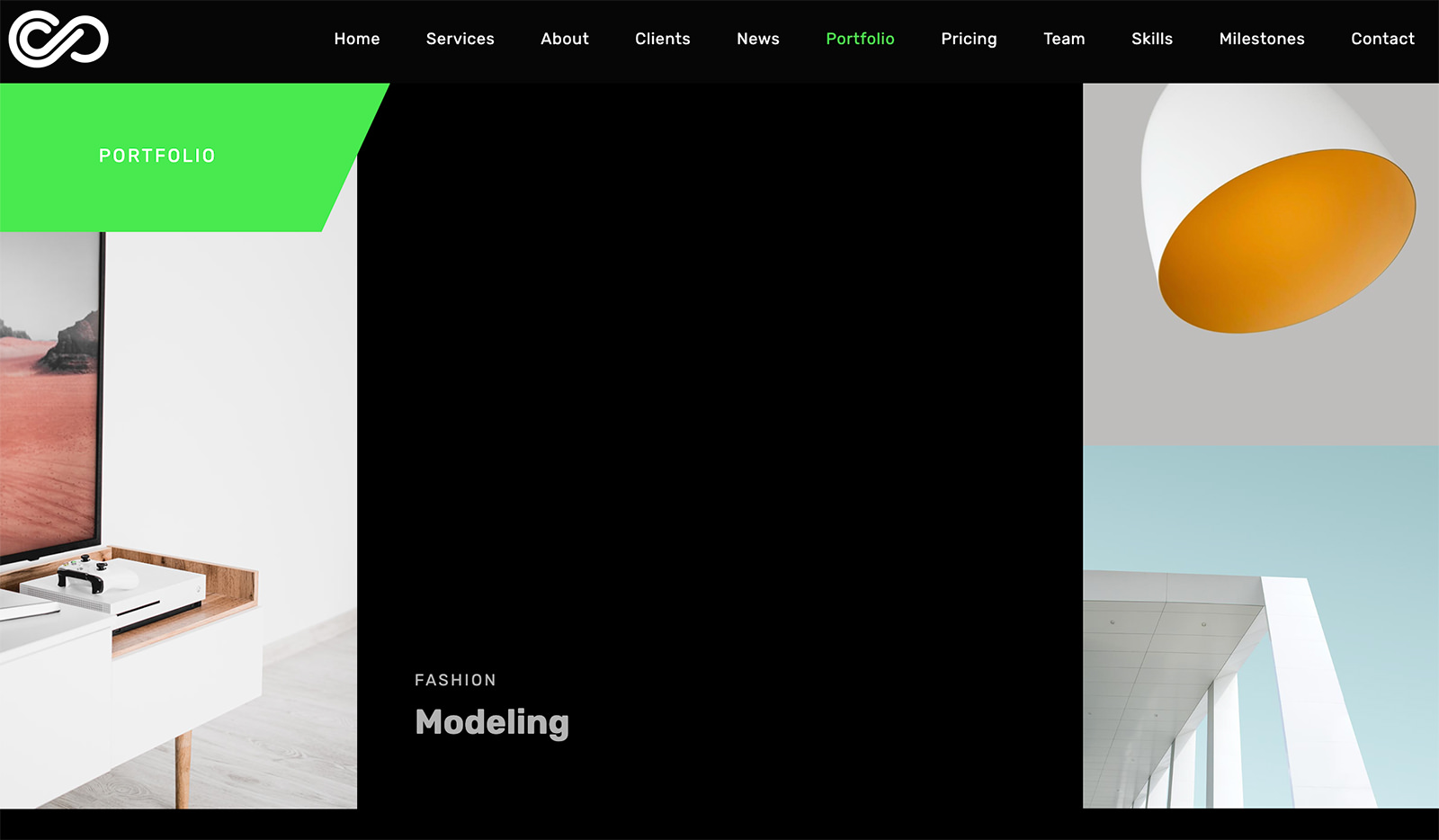
Seppo is a one-page WordPress theme ideal for corporate and professional usage. It seamlessly merges aesthetics with functionality, offering sections such as Home, Services, and About on a single scrollable page. The theme features a dynamic slider tool and offers customization options.
The layout is responsive, ensuring mobile compatibility. Seppo also utilizes Ajax for quicker content loading and includes a portfolio post type.
Additional features include smooth scrolling and multi-language support through WPML plugin compatibility. The theme is also compatible with Contact Form 7. Despite its sophisticated design, Seppo is user-friendly and versatile.
Rhye

Rhye is a visually striking WordPress theme that offers an elegant aesthetic and seamless browsing through AJAX-powered loading. It includes smooth motion effects, powered by WebGL and GSAP 3. The theme is also built with the Elementor page builder for easy layout creation.
Rhye also boasts performance features such as quick site navigation and responsive design. Customizable color schemes are also available for a personalized touch.
Additional features include a fullscreen overlay menu and compatibility with various plugins. The theme is also SEO optimized and translation-ready, making it a versatile choice for creatives seeking a professional online presence.
Lazer

Lazer is suitable for various applications such as business websites, creative agencies, portfolios, and blogs. It boasts a modern design and numerous features aimed at enhancing functionality. Its responsive design ensures it performs optimally on all devices.
Customizing your site’s appearance and layout is a breeze with Lazer. It features a theme options panel and a drag & drop page builder for easy customization. It also includes parallax and video backgrounds, over 600 Google Fonts, and unlimited sidebars.
Lazer is not only optimized for speed and SEO, but is also compatible with popular plugins like WPBakery Page Builder. Regularly updated, it is tested up to WordPress version 5.7.
Tattoo

The Tattoo WordPress theme is a responsive and user-friendly design specifically for tattoo and piercing shops. It’s compatible with WordPress 6.4 and includes the Beaver Builder Drag and Drop Builder for easy customization.
Key features include a Reservation Form, Shop, Reviews, Q&A, and Galleries. It also offers extensive setup guides, video tutorials, and articles for assistance.
The theme is SEO and mobile optimized, and comes with premium features like the Revolution Slider and WooCommerce integration. The Tattoo theme is not only visually attractive but also a practical tool for creating a compelling online presence.
Pistis
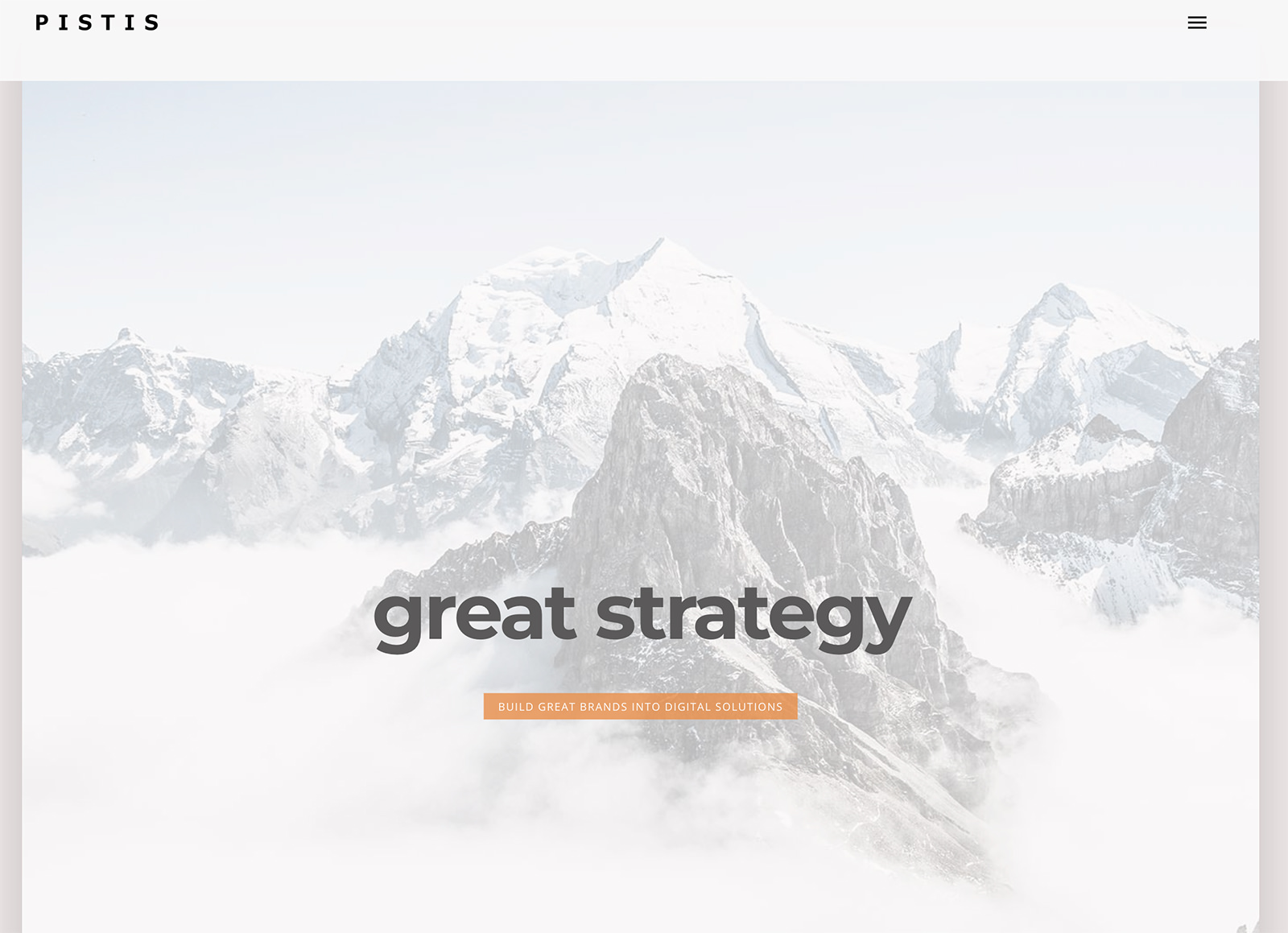
Pistis is a WordPress theme designed for portfolios and agencies, particularly for creative professionals. It provides a platform to showcase work and services. The theme includes unique hero sections, a variety of homepage options, and portfolio layouts.
In addition to its visual appeal, Pistis also features a full-screen menu and unlimited colors. It is retina ready for all devices, ensuring a high-quality display.
The theme supports Google Fonts and includes over 400 icons as well as CSS3 animations. It also comes with the Font Awesome icon set.
Pistis is cross-browser compatible, prioritizing performance and user-friendliness alongside its aesthetic qualities.
Tracem
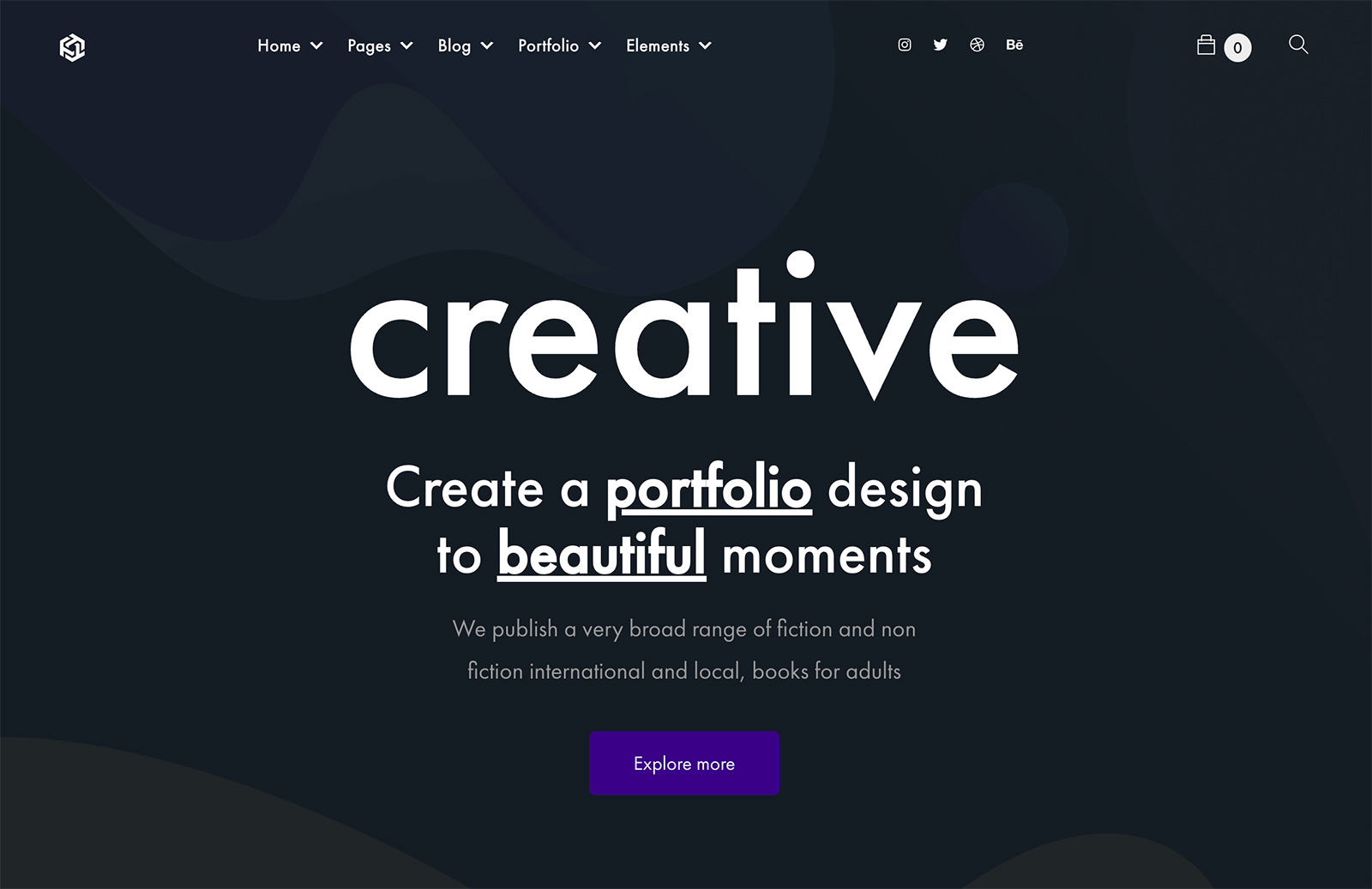
Tracem theme is designed for a range of uses, from corporate websites to personal portfolios. It incorporates the Elementor Page builder, simplifying the process of website creation. Additionally, it offers a one-click demo install for a swift setup. The theme is built on the responsive Bootstrap 4.x platform.
It also includes engaging parallax sections. Tracem provides a variety of portfolio styles and unlimited color options, along with handy elements for customization. It supports multiple plugins, including Elementor and WooCommerce, ensuring broad functionality.
Moreover, Tracem adheres to HTML5 and CSS3 standards. It also supports PO translation and is compatible with the Loco translate plugin, making it a user-friendly choice for diverse language needs.
Bomby

Bomby is a modern WordPress theme with a responsive design. It’s perfect for businesses, agencies, portfolios, or blogs. The theme includes multiple header layouts, a slider plugin, and a visual page builder. It also has a theme options panel for customization.
The theme boasts features such as video backgrounds, parallax effects, and portfolio cases. It supports over 600 Google Fonts and offers unlimited colors and layouts for aesthetic customization.
Bomby is optimized for SEO and is WooCommerce and WPML ready. It integrates with popular plugins like WPBakery Page Builder and WooCommerce for added functionality.
The advanced theme options panel allows users to control various site aspects, from fonts to animations.
Sasspark

Sasspark, with its modern and clean design, is ideal for startups, digital agencies, and SaaS businesses. It provides both one-page and multi-page options and includes the Elementor page builder for easy customization. The Codestar Framework is also integrated, allowing for control over site aesthetics.
The theme boasts features such as multiple homepage blocks, cross-browser compatibility, and a smart sticky header. It’s also retina-ready, ensuring sharp display on all devices. Support for FontAwesome, Icofont Icons, and Remix Icons is also included.
Despite its multitude of features, Sasspark remains lightweight and fast-loading, ensuring an optimal user experience.
Startos
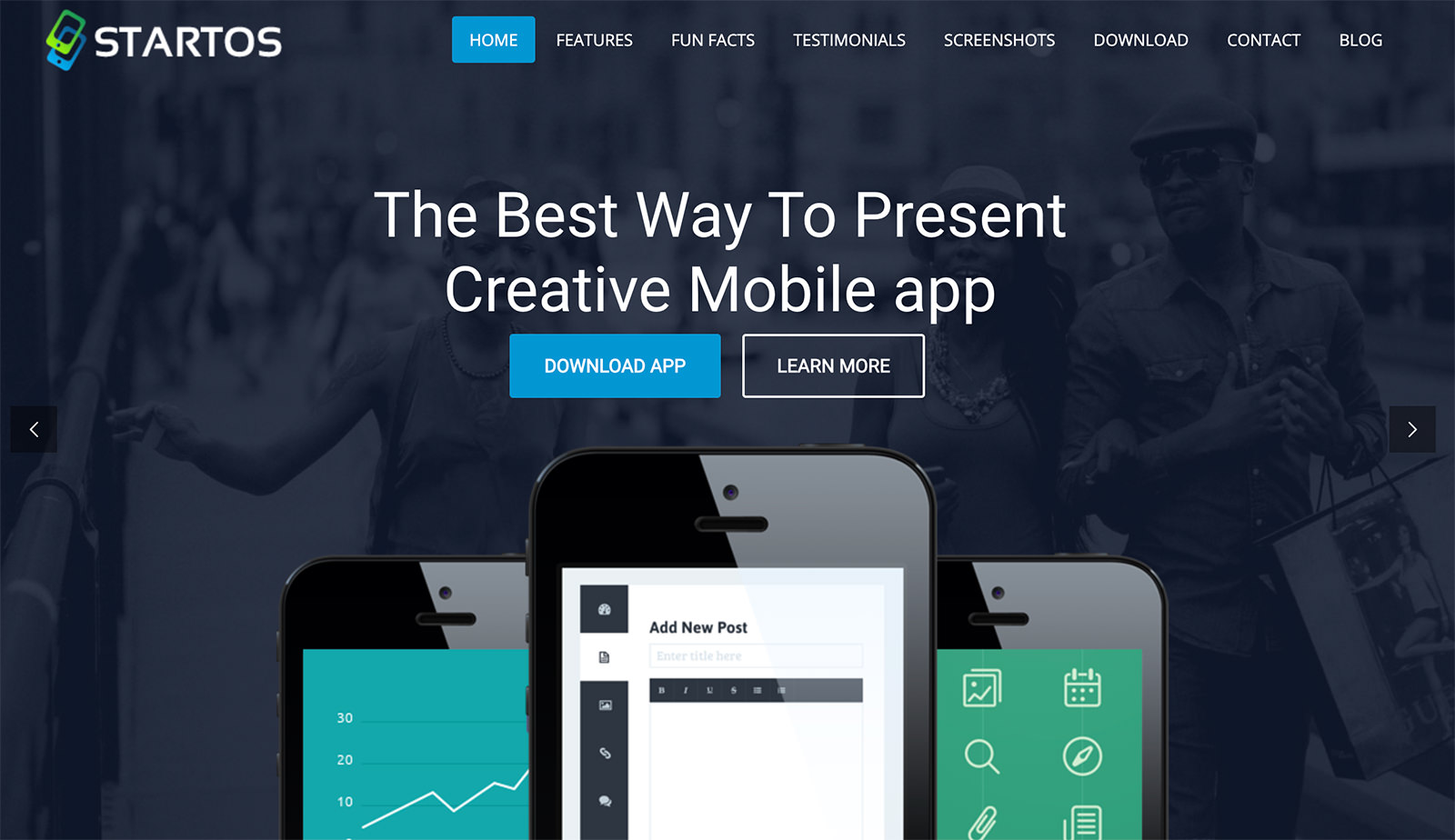
Startos is a mobile app design platform with a clean, customizable interface. It offers a variety of color and demo options, as well as key features like the Visual Composer Page Builder and Revolution Slider. Users have access to three different home page versions and can easily import demo content.
The platform is fully responsive, ensuring a seamless display on all devices. It also offers unlimited color schemes and Google Fonts for further customization. The robust admin panel and flexible shortcodes make it easy to manage and adapt.
Additional features include video backgrounds, smooth scrolling, and contact forms. Users can also access multiple icons and pricing tables. Startos is compatible with both Android and iOS apps.
Talos

Talos is suitable for various applications including personal portfolios and creative agencies. It boasts a responsive design for optimal use on mobile and tablet devices.
The theme offers over 20 home page versions and includes a Visual Composer Page Builder. It also features unlimited color styles and supports responsive video.
Talos is SEO optimized and built with HTML5 and CSS3. It provides over 600 Google Web Fonts and 400+ icons for customization.
With detailed documentation, Talos is easy to set up. It’s more than just a theme, it’s a tool for an efficient online presence.
The post 20 Best Parallax WordPress Themes for 2024 appeared first on Hongkiat.
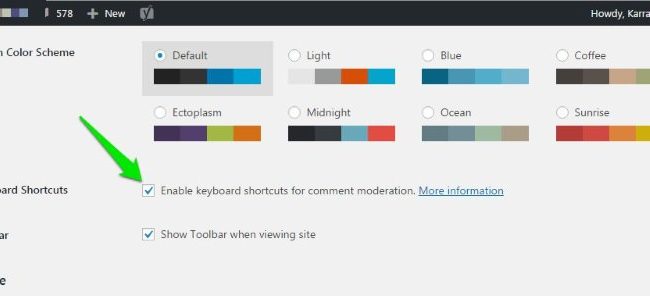
50+ Useful WordPress Keyboard Shortcuts for Windows and Mac
Understanding computer keyboard shortcuts can drastically elevate your productivity. In a similar vein, if you’re acquainted with specific WordPress keyboard shortcuts, your workflow can become notably smoother. This is particularly beneficial for individuals who prefer not to toggle between the keyboard and mouse. Hence, for […]
WordpressUnderstanding computer keyboard shortcuts can drastically elevate your productivity. In a similar vein, if you’re acquainted with specific WordPress keyboard shortcuts, your workflow can become notably smoother. This is particularly beneficial for individuals who prefer not to toggle between the keyboard and mouse. Hence, for such users, these shortcuts can be invaluable.
WordPress offers an abundance of shortcuts for tasks like editing content, performing specific actions, or even simple navigation. In this article, we’ll delve into a detailed list of nearly all the WordPress keyboard shortcuts to enhance your efficiency.
Basic Navigation
Navigation in WordPress is akin to browsing through any other website. The essential keys you need for this are Tab, Arrow, Enter, and Backspace. Below, we elaborate on each of these keys and their functions.
Tab
By pressing the Tab key, you can move to the subsequent clickable link or option on the page, starting from the top. By pressing it successively, you can navigate from one option to another. If you need to navigate backward, simply hold Shift and press Tab.
Arrow Keys
Utilizing the arrow keys – ←, →, ↑, and ↓ – will enable you to scroll through the content of the post.
Enter/Return
To confirm a dialog box or access a specific option, all you need to do is press the Enter key.
Backspace
The Backspace key lets you navigate back to the preceding page. For forward navigation, hold the Shift key and press Backspace.
Post Editing
Here’s where the excitement truly kicks in. Mastering the post editor shortcuts can significantly streamline the process of editing and formatting your content. Below is a comprehensive list of shortcuts for content management, editing, and formatting – all the tools you’ll require to craft content on WordPress efficiently.
Content Management
| Action | Windows Shortcut | Mac Shortcut |
|---|---|---|
| Highlight content per character | Shift + ← / → | Shift + ← / → |
| Highlight content per word | Ctrl + Shift + ← / → | Option + Shift + ← / → |
| Highlight above/below line | Shift + ↑ / ↓ | Shift + ↑ / ↓ |
| Select all content | Ctrl + A | Cmd + A |
| Paste content without formatting | Ctrl + Shift + V | Cmd + Shift + V |
Content Formatting
| Action | Windows | Mac |
|---|---|---|
| Strikethrough text | Shift + Alt + D | Shift + Option + D |
| Insert link | Ctrl + K | Command + K |
| Remove link | Shift + Alt + S | Shift + Option + S |
| Apply heading 1 | Shift + Alt + 1 | Shift + Option + 1 |
| Apply heading 2 | Shift + Alt + 2 | Shift + Option + 2 |
| Apply heading 3 | Shift + Alt + 3 | Shift + Option + 3 |
| Apply heading 4 | Shift + Alt + 4 | Shift + Option + 4 |
| Apply heading 5 | Shift + Alt + 5 | Shift + Option + 5 |
| Apply heading 6 | Shift + Alt + 6 | Shift + Option + 6 |
| Apply paragraph formatting | Shift + Alt + 7 | Shift + Option + 7 |
| Start bullet list | Shift + Alt + U | Shift + Option + U |
| Start numbered list | Shift + Alt + O | Shift + Option + O |
| Blockquote | Shift + Alt + Q | Shift + Option + Q |
| Apply code formatting | Shift + Alt + X | Shift + Option + X |
| Apply Address formatting | Shift + Alt + 9 | Shift + Option + 9 |
| Align center | Shift + Alt + C | Shift + Option + C |
| Align right | Shift + Alt + R | Shift + Option + R |
| Align left | Shift + Alt + L | Shift + Option + L |
| Justify | Shift + Alt + J | Shift + Option + J |
| Add media | Shift + Alt + M | Shift + Option + M |
| Toggle toolbar | Shift + Alt + Z | Shift + Option + Z |
| Insert Page Break tag | Shift + Alt + P | Shift + Option + P |
| Insert Read More tag | Shift + Alt + T | Shift + Option + T |
| Enable/disable Distraction free mode | Shift + Alt + W | Shift + Option + W |
| Open help | Shift + Alt + H | Shift + Option + H |
Comments
WordPress provides specialized shortcuts for the comment moderation section to facilitate easier comment management. However, it’s imperative to first enable these keyboard shortcuts for comment moderation prior to utilizing them. Let’s walk through the process:
Begin by navigating to your WordPress user profile. Once there, select the option titled “Enable keyboard shortcuts for comment moderation”. Activating this option will make all the shortcuts mentioned below functional. It’s essential to note that each user must individually enable these shortcuts for them to work.

Comment Navigation
The keys J and K are all you’ll require to seamlessly navigate through comments.
By pressing J, you can scroll downwards through the comments. If none are highlighted, it will select the topmost comment. Conversely, K allows you to move upwards.
Moreover, upon reaching the last comment, pressing J will take you to the next page of comments, whereas K brings you back to the previous page.
Comment Actions
The following shortcuts, which only require a single key press, become operational when a comment or multiple comments are highlighted:
| Action | Windows and Mac |
|---|---|
| Approve comment | A |
| Mark as spam | S |
| Move to trash | D |
| Undo recent action | Z |
| Unapprove comment | U |
| Reply to comment | R |
| Enable quick edit | Q |
| Open comment editing screen | E |
Apply Actions in Bulk
WordPress comes with a set of shortcuts designed specifically for executing bulk actions in the comments section. The following table provides a comprehensive list of these shortcuts:
| Action | Windows and Mac Shortcut |
|---|---|
| Select all comments | Shift + X |
| Approve all selected comments | Shift + A |
| Trash selected comments | Shift + T |
| Permanently delete selected comments | Shift + D |
| Mark selected comments as spam | Shift + S |
| Unapprove selected comments | Shift + U |
| Restore select comments | Shift + Z |
Ending Thoughts
Utilizing these keyboard shortcuts can significantly enhance your productivity when managing your WordPress website. Personally, I seldom resort to using the mouse during the editing process, and, despite a brief lag in highlighting content, I’ve encountered no issues.
If you’re acquainted with other handy WordPress keyboard shortcuts or WordPress tips and tricks, we’d love to hear from you in the comments.
Read Also:
How to Add Keyboard Shortcuts to Your Website
The post 50+ Useful WordPress Keyboard Shortcuts for Windows and Mac appeared first on Hongkiat.

10 Plugins to Manage Your Multi-Author WordPress Blog
High-quality content is the cornerstone of successful digital publishing. Inviting co-authors and guest contributors to your blog can substantially elevate both the quality and quantity of your content offerings. Yet, the task of managing a diverse team of writers, particularly those new to your platform’s […]
WordpressHigh-quality content is the cornerstone of successful digital publishing. Inviting co-authors and guest contributors to your blog can substantially elevate both the quality and quantity of your content offerings. Yet, the task of managing a diverse team of writers, particularly those new to your platform’s guidelines, can be complex and time-consuming.
Thankfully, WordPress offers a wide array of plugins specifically designed to facilitate the management of multiple authors. Below is a curated list of exceptional WordPress plugins that aim to make author management more efficient and straightforward.
Editorial Calendar Plugin

Managing your blog’s posting schedule can be challenging, especially when WordPress lacks a built-in solution for tracking upcoming posts. The Editorial Calendar Plugin effectively fills this gap.
This plugin provides a calendar-based overview of your entire blog’s content pipeline, allowing you to see at a glance when each post is scheduled for publication. This simplifies your content planning process.
The plugin also offers robust management features. You can easily rearrange the schedule by dragging and dropping posts within the calendar. Quick edits to your articles can be made directly from this interface.
Author Box for Authors Plugin

The Author Box for Authors Plugin, also known as Molongui Authorship, gives due credit to your content authors. It features a responsive and customizable author box that automatically appears on your WordPress posts.
This plugin supports multiple authors for a single post, allowing you to credit everyone involved. It also includes a feature for guest authors, enabling you to add contributors without creating a WordPress account for them.
The plugin also allows you to change the position of the author box, modify its design to match your site’s aesthetics, and even add additional profile fields. It supports microdata for SEO and offers various layout options.
Co-Authors Plus Plugin

The Co-Authors Plus Plugin enables you to assign multiple authors to a single post, page, or custom post type through an intuitive search-as-you-type input box.
Each co-author gains visibility through their own archive page and feed. They also have the ability to edit posts with which they are associated. For contributors, editing is restricted to unpublished posts, aligning with WordPress’ core functionality.
A standout feature is the ability to add guest authors without requiring a WordPress user account. You can simply create a guest profile and assign it as you would any other byline.
WP User Frontend Plugin
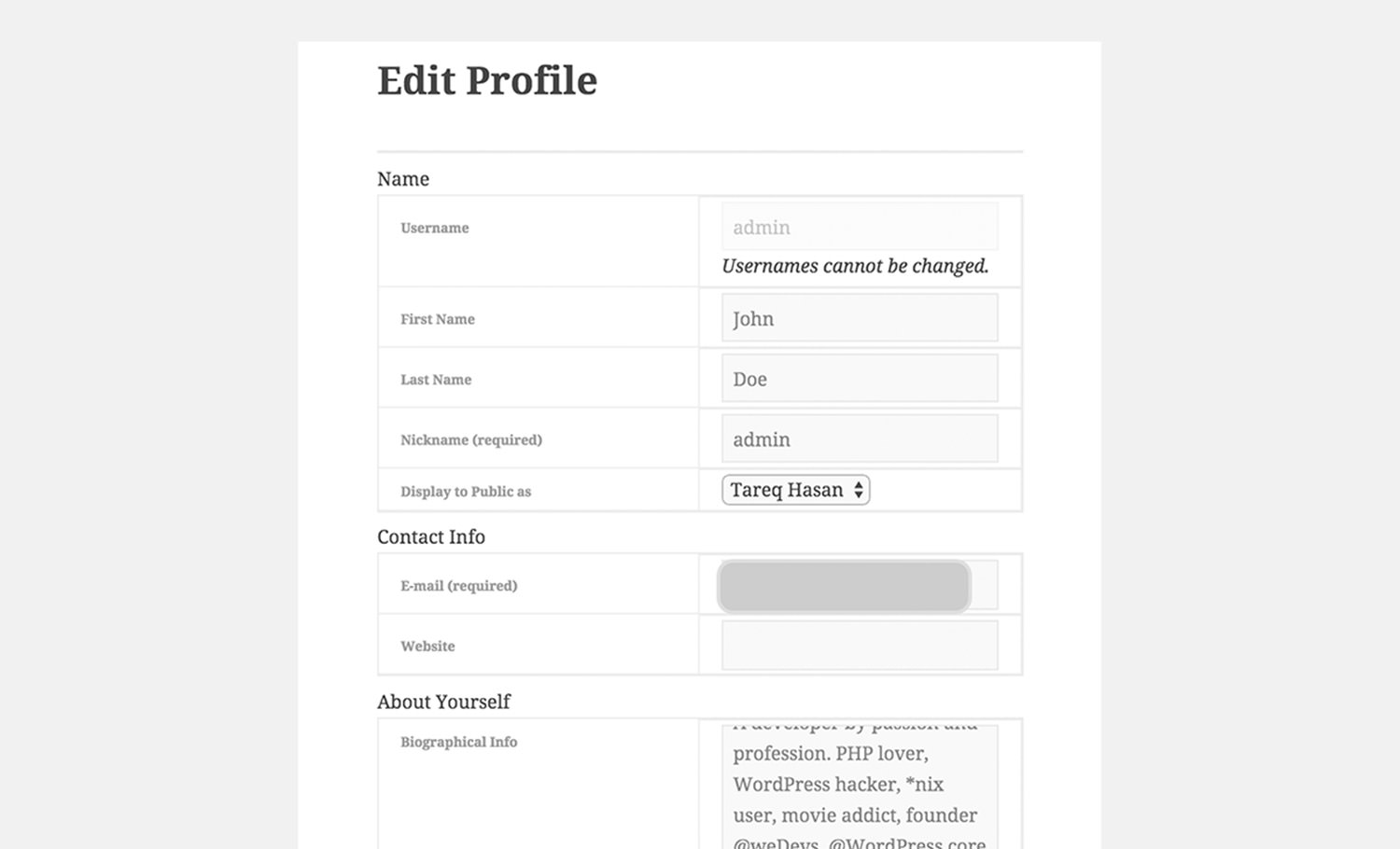
The WP User Frontend Plugin enhances the frontend experience on your WordPress site. It offers a frontend dashboard, editor, and uploader, making it easier for users to manage their profiles, post submissions, and memberships.
This plugin allows for unlimited post-type form creation, enabling users to create new posts and edit their profiles directly from the frontend. This eliminates the need for backend access, making the process more user-friendly.
Admins can manage users from the frontend and configure backend access permissions. Additionally, the plugin supports featured image and image uploads from the frontend.
Post Pay Counter Plugin

The Post Pay Counter Plugin streamlines the payment process for authors on multi-author blogs. It allows you to set up payment criteria and then automatically calculates payments based on those criteria. The plugin provides both a general view of all users and a specific view for each author.
This plugin is useful for implementing a revenue-sharing or paid-to-write model. It supports various payment methods, including pay-per-post, pay-per-word, pay-per-visit, pay-per-image, and pay-per-comment. Payments can be calculated using either an incremental or zonal system.
Additional features include a date picker for selecting specific time ranges and customizable permissions to restrict user access to stats and functions.
User Access Manager Plugin
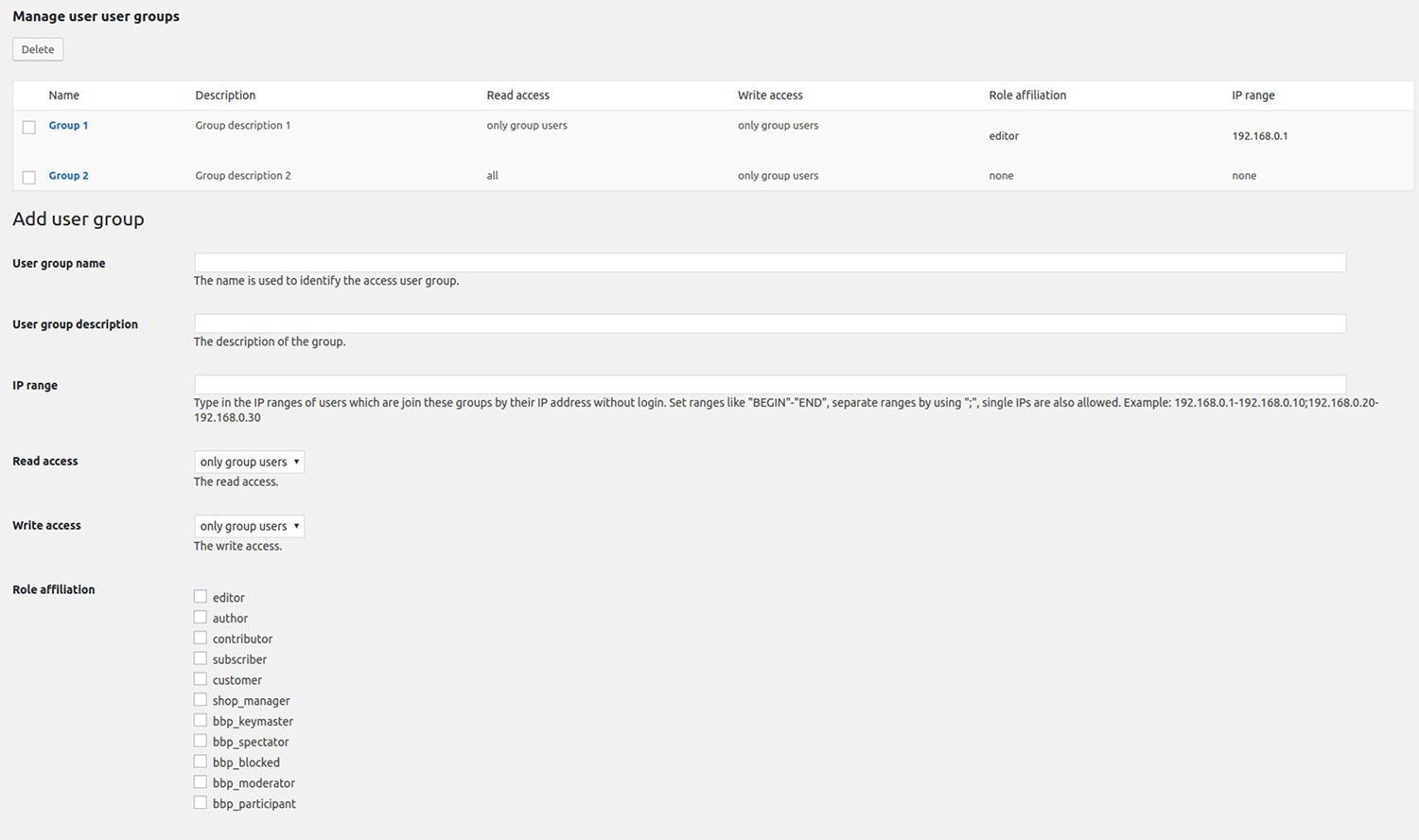
The User Access Manager Plugin aims to simplify the management of multiple authors in WordPress by allowing you, the admin, to customize the WordPress admin interface based on user roles.
This plugin enables you to selectively hide or display menu items, down to the sub-menu level. It also provides control over meta fields for both posts and pages.
You can tailor the admin interface for each user role, optimizing the backend header for more space and reorganizing the menu for logical navigation. This ensures a personalized and efficient admin experience for all users.
Adminimize Plugin
The Adminimize Plugin focuses on decluttering your WordPress dashboard. It allows you to hide specific menus and sub-menus, streamlining the interface for your authors.
The plugin also enables you to hide meta boxes and other elements in the post/page writing section, resulting in a cleaner, more focused writing environment.
This plugin is particularly useful for multi-author blogs where you aim to offer a simplified and efficient writing interface.
Simple Author Box Plugin

The Simple Author Box Plugin enhances your WordPress posts by adding a responsive author box at the end. This box displays the author’s name, gravatar, bio, and social media icons.
The plugin is highly customizable and supports over 30 social profile fields, which can be added to the WordPress user profile screen.
Additional features include the automatic insertion of the author box at the end of posts, as well as RTL, AMP support, and GDPR compatibility.
PublishPress Capabilities Plugin
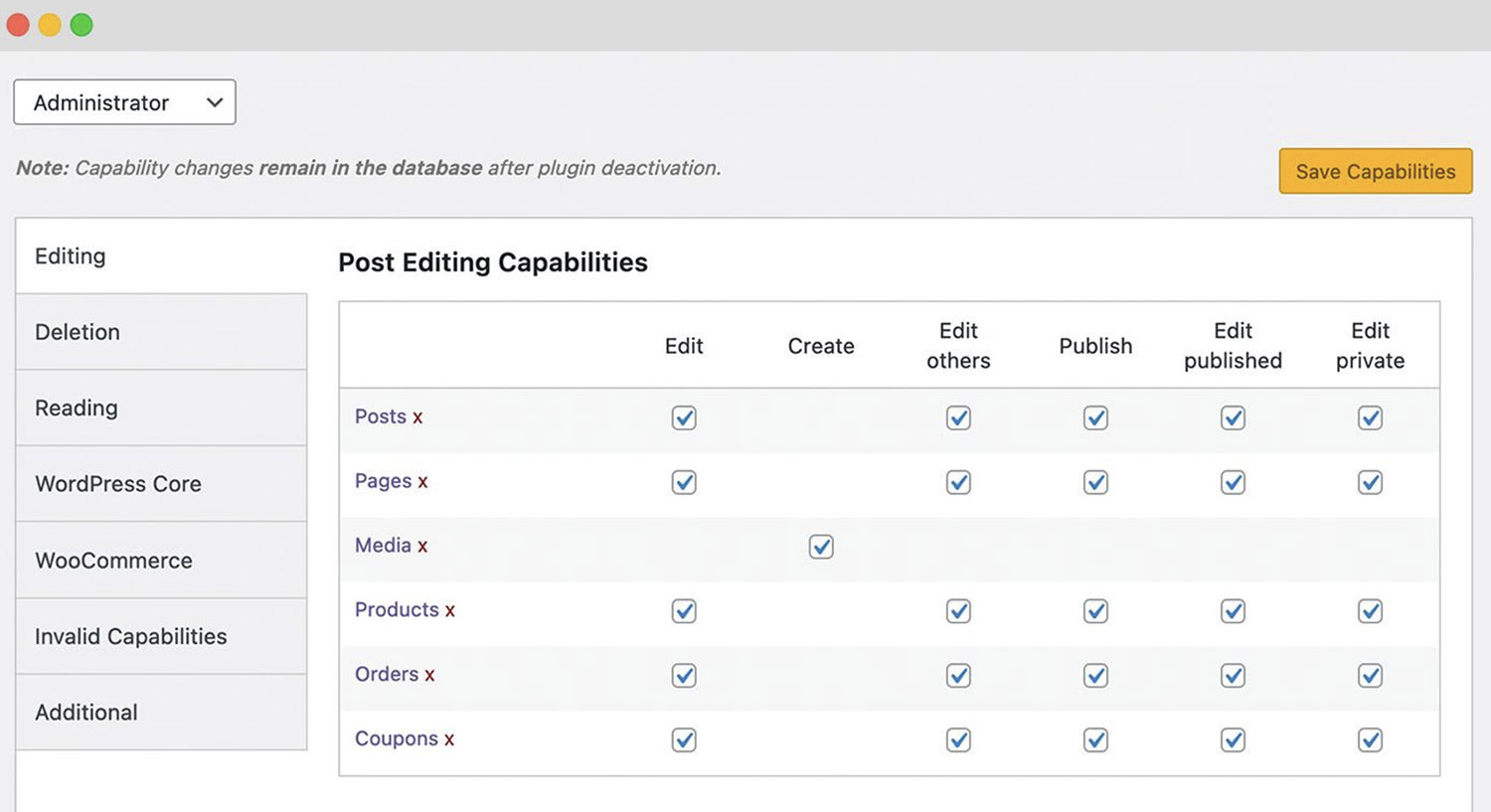
The PublishPress Capabilities Plugin provides a robust solution for managing user roles and permissions on your WordPress site. Designed for both ease of use and powerful functionality, this user role editor is highly versatile.
You can manage all WordPress user roles, including custom roles, to ensure that each has the exact capabilities needed for your site. The plugin also allows you to customize the post editing screen, admin area, and user profile screens based on user roles.
User Role Editor Plugin
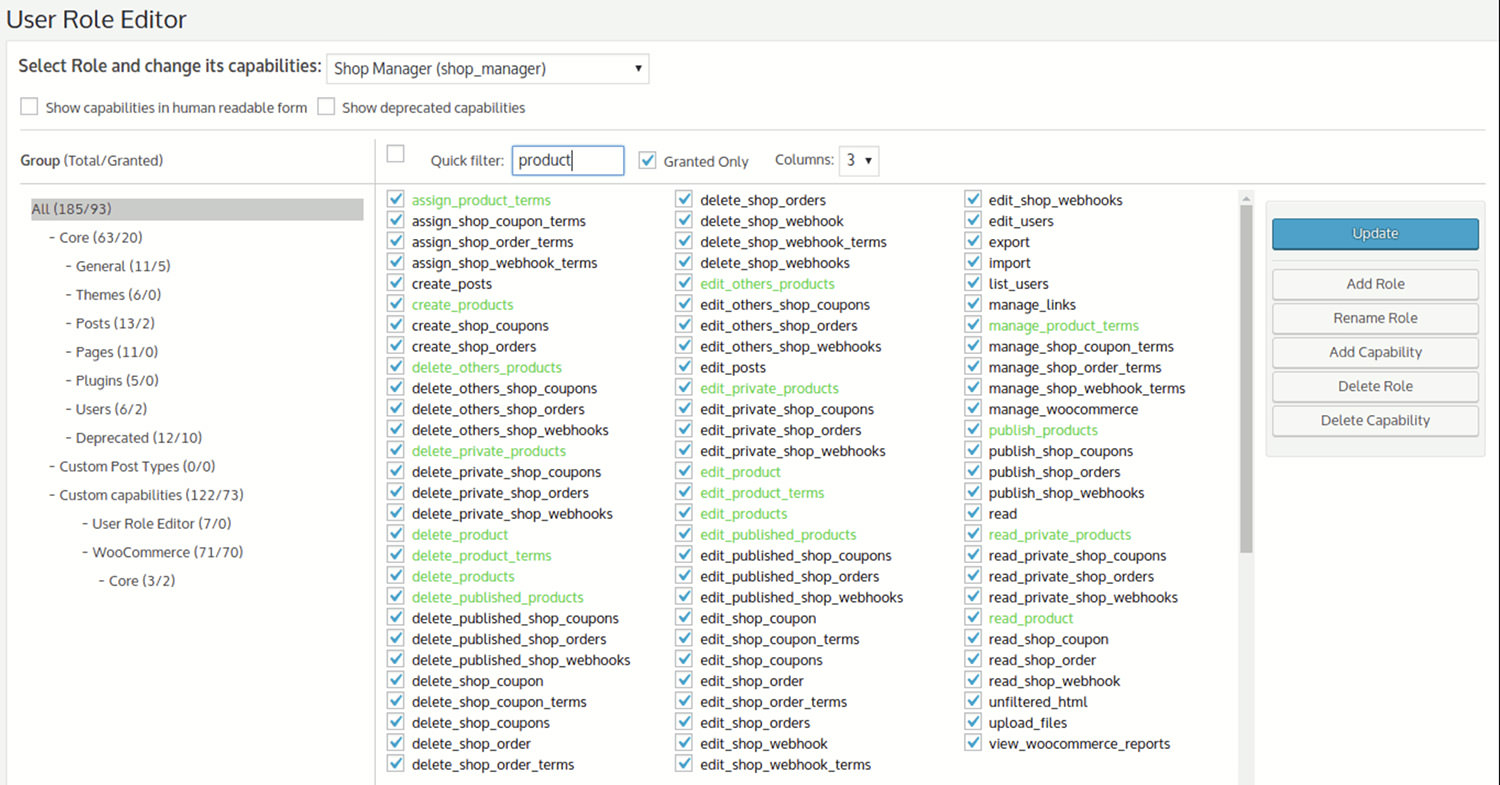
The User Role Editor Plugin for WordPress simplifies the management of user roles and capabilities. It allows admins to easily add or remove capabilities for any role by checking or unchecking boxes.
This plugin enables you to create new roles either from scratch or by copying existing ones. If a role becomes obsolete, you can delete it as long as no users are assigned to it. The plugin also allows you to change the default role assigned to new users.
It also has the ability to assign multiple roles to a single user. You can add new capabilities or remove ones that are no longer needed. The plugin offers multi-site support, making it a comprehensive solution for role management.
The post 10 Plugins to Manage Your Multi-Author WordPress Blog appeared first on Hongkiat.

20 Best WordPress Job Board Themes and Plugins for 2023
Are you in the process of exploring online platforms to either secure freelance opportunities or to recruit qualified professionals? Job board websites serve as a digital marketplace where employers can list job openings and prospective employees can submit applications. With the increasing prevalence of WordPress-based […]
WordpressAre you in the process of exploring online platforms to either secure freelance opportunities or to recruit qualified professionals? Job board websites serve as a digital marketplace where employers can list job openings and prospective employees can submit applications. With the increasing prevalence of WordPress-based job boards, a plethora of specialized WordPress themes and plugins have been meticulously crafted to cater to this niche.
If you are contemplating the development of a bespoke job board system utilizing WordPress, you have arrived at the appropriate article. We present a curated list of 20 premium and free WordPress job board themes and plugins to facilitate your endeavor.
.no-js #ref-block-post-6398 .ref-block__thumbnail { background-image: url(“https://assets.hongkiat.com/uploads/thumbs/250×160/50-freelance-job-sites-for-designers-programmers-best-of.jpg”); }
50 Job Sites for Freelancers and Independent Professionals
Being a freelancer can be extremely advantageous and is probably a dream for many designers and developers who… Read more
Overview:
| Job Board Themes | Job Board Plugins |
|---|---|
| Cariera | WP Job Manager |
| Civi | Recruitly Addons |
| Jobtex | Simple Job Board |
| Jobster | JobBoardWP |
| Careerfy | Job Board Manager |
| WorkScout | WP Job Openings |
| Jobhunt | easy.jobs |
| JobScout | |
| Job Portal | |
| JobRoller | |
| Careers | |
| JobEngine | |
| Comport |
WordPress Job Board Themes
Cariera

Designed for professionals, Cariera is a WordPress theme that is built on Automattic’s WP Job Manager. It serves as a comprehensive tool for both job seekers and employers.
The theme features a variety of job listing styles, in-depth analytics, a secure messaging system, and customizable dashboards tailored to different user roles. With a simple import, you can replicate the live demo site in just a few minutes.
Price: $79
Civi

If you aim to build a streamlined job board, a freelance marketplace, or both using WordPress, Civi is an excellent choice. This theme allows you to effortlessly establish a fully-responsive job portal, thereby simplifying tasks related to human resource management, recruitment processes, and job listing management.
Price: $59
Jobtex

Jobtex is a comprehensive WordPress theme designed to create job listing websites that are both functional and user-friendly. More than just a job board, it serves as a complete platform for HR management and recruitment.
The theme is fully responsive and provides a straightforward way to monetize your job portal. It is an ideal choice for those seeking an efficient job board solution.
Price: $59
Jobster
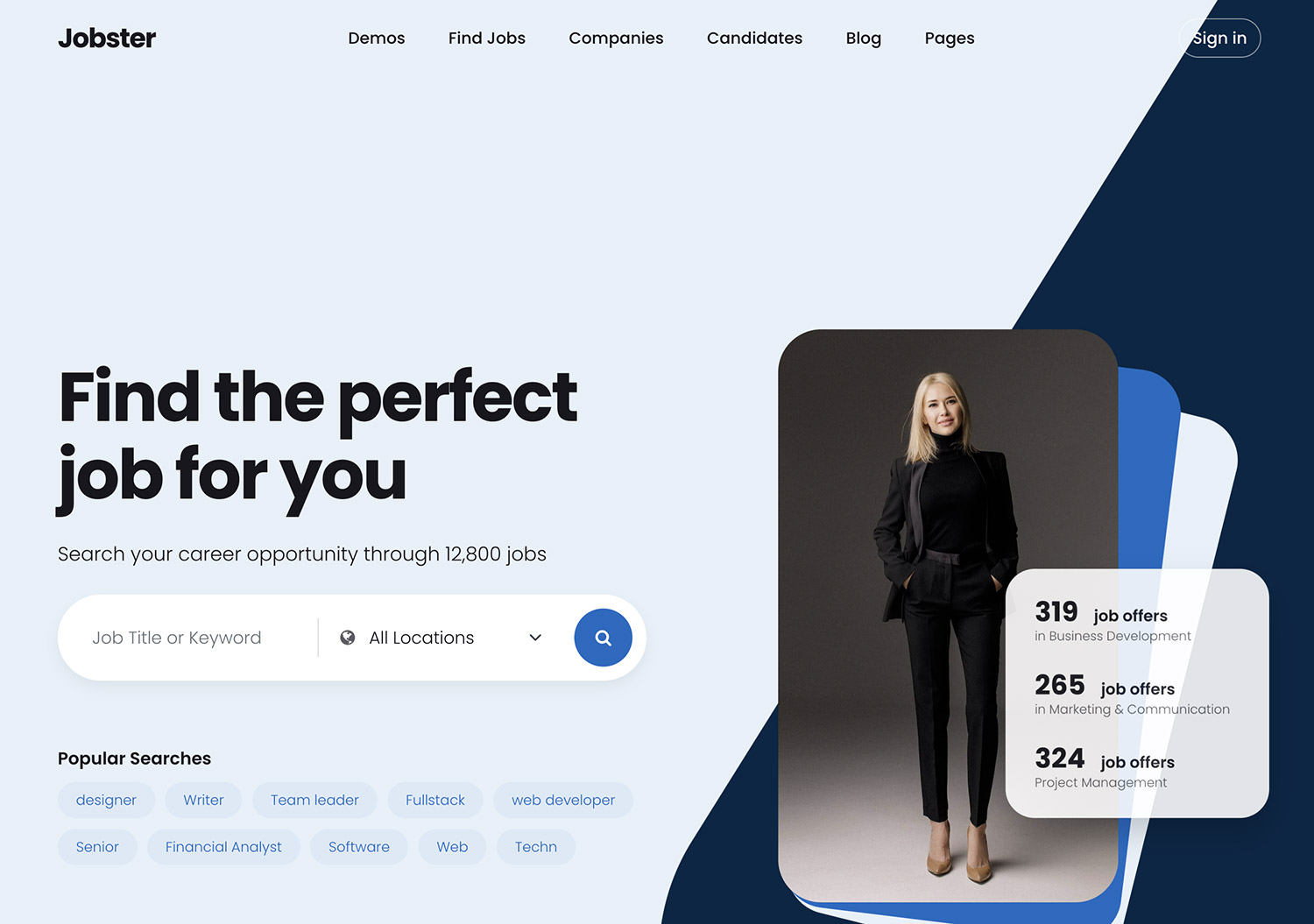
Jobster is a robust WordPress theme designed for creating job listing websites. With pre-designed demos at your disposal, launching your site becomes a breeze. The theme offers a rich set of features that are both powerful and user-friendly, providing you with limitless customization options.
It includes a variety of well-designed components, ranging from header sections to job displays and card layouts.
Price: $29
Careerfy
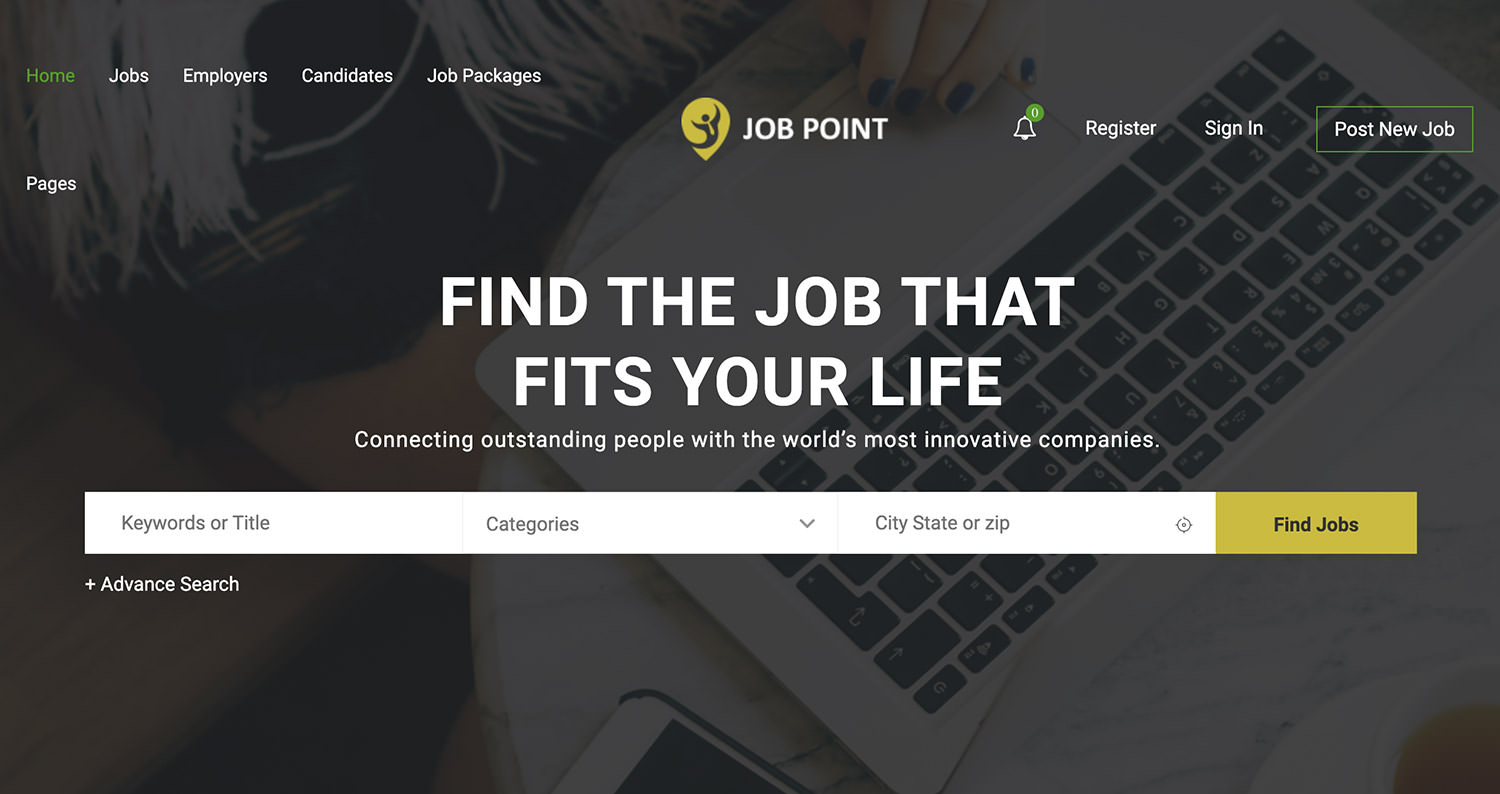
Careerfy offers an advanced yet straightforward solution for displaying job listings on various types of websites. This WordPress theme enables you to access extensive job databases from major job boards, enriching your site with a wide array of job offers.
It features dedicated control panels for both employers and job seekers, automating many tasks. Some job providers even offer commissions for job link clicks originating from your site.
Price: $89
WorkScout
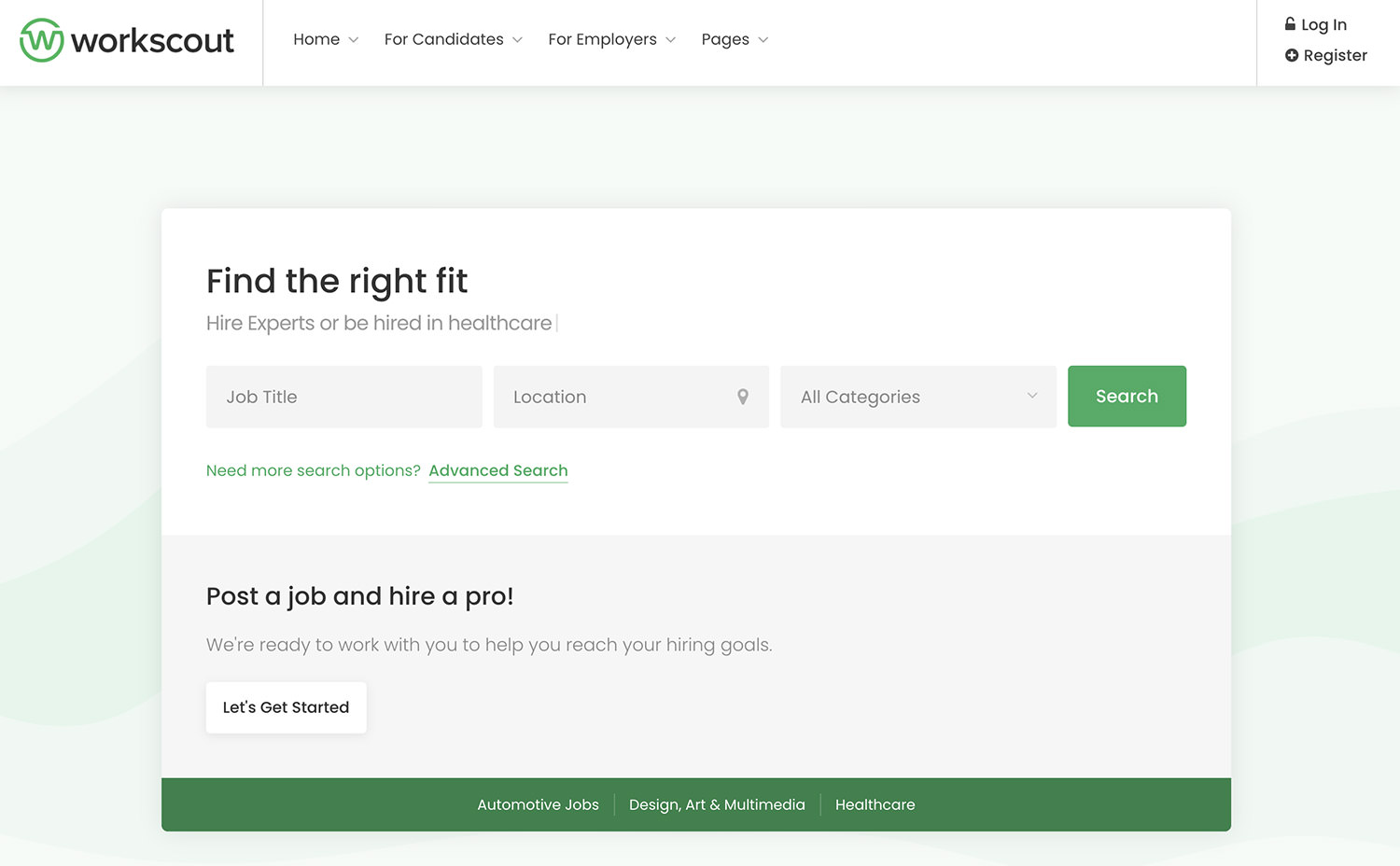
WorkScout is a comprehensive WordPress theme designed for recruitment agencies, job offices, and employment services. This theme allows you to launch a polished, professional website in a short amount of time.
Price: $79
Jobhunt

Jobhunt is a user-friendly and efficiently coded WordPress theme that works seamlessly with WP Job Manager. It provides a full range of features, including searchable job listings, job submissions, and dedicated dashboards for employers.
The theme also supports additional functionalities through the WP Job Manager Core Add-on Bundle, such as resume management, job alerts, and integration with hiring platforms like Indeed.
Price: $59
JobScout
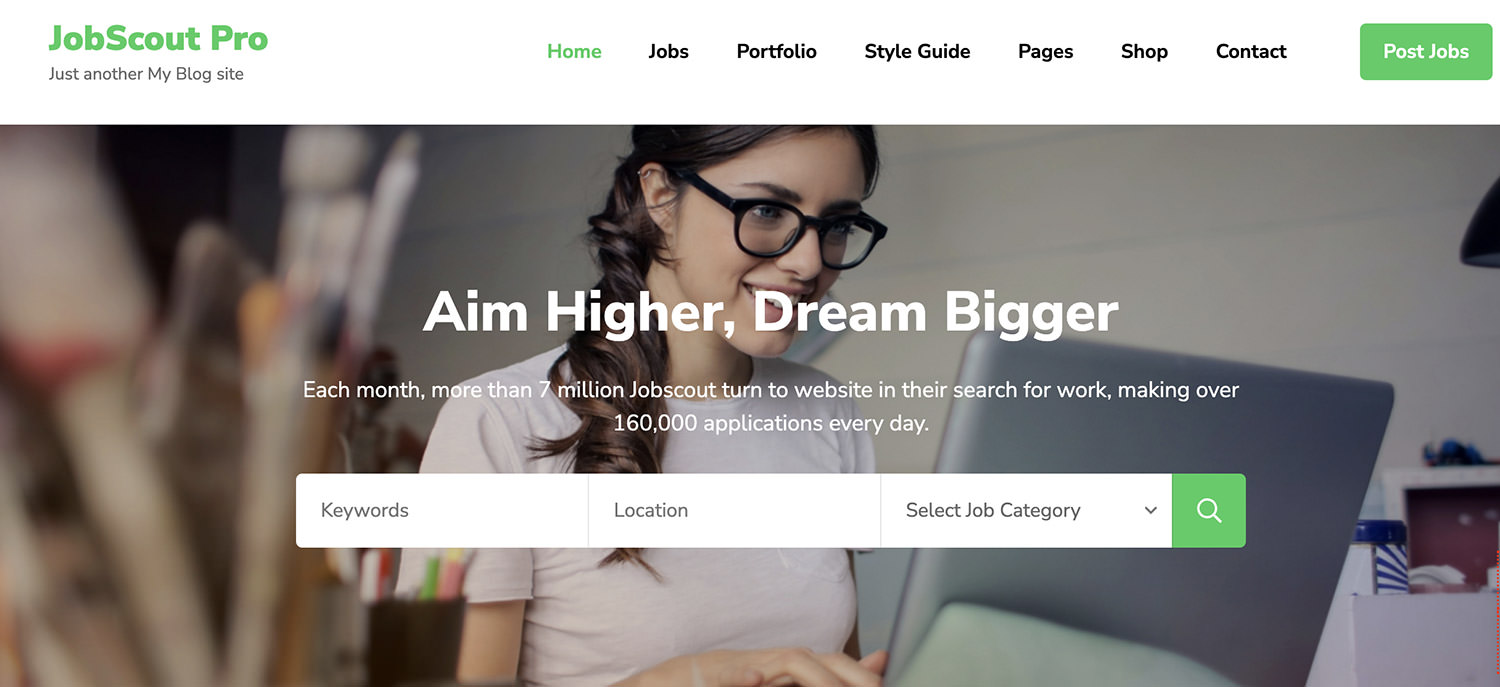
JobScout is a responsive WordPress theme designed for HR firms and recruitment agencies. It integrates seamlessly with the WP Job Manager plugin, adding job board features to your site. The theme is beginner-friendly, requiring no coding skills, and offers high customizability through an intuitive live customizer.
Price: Free
Job Portal
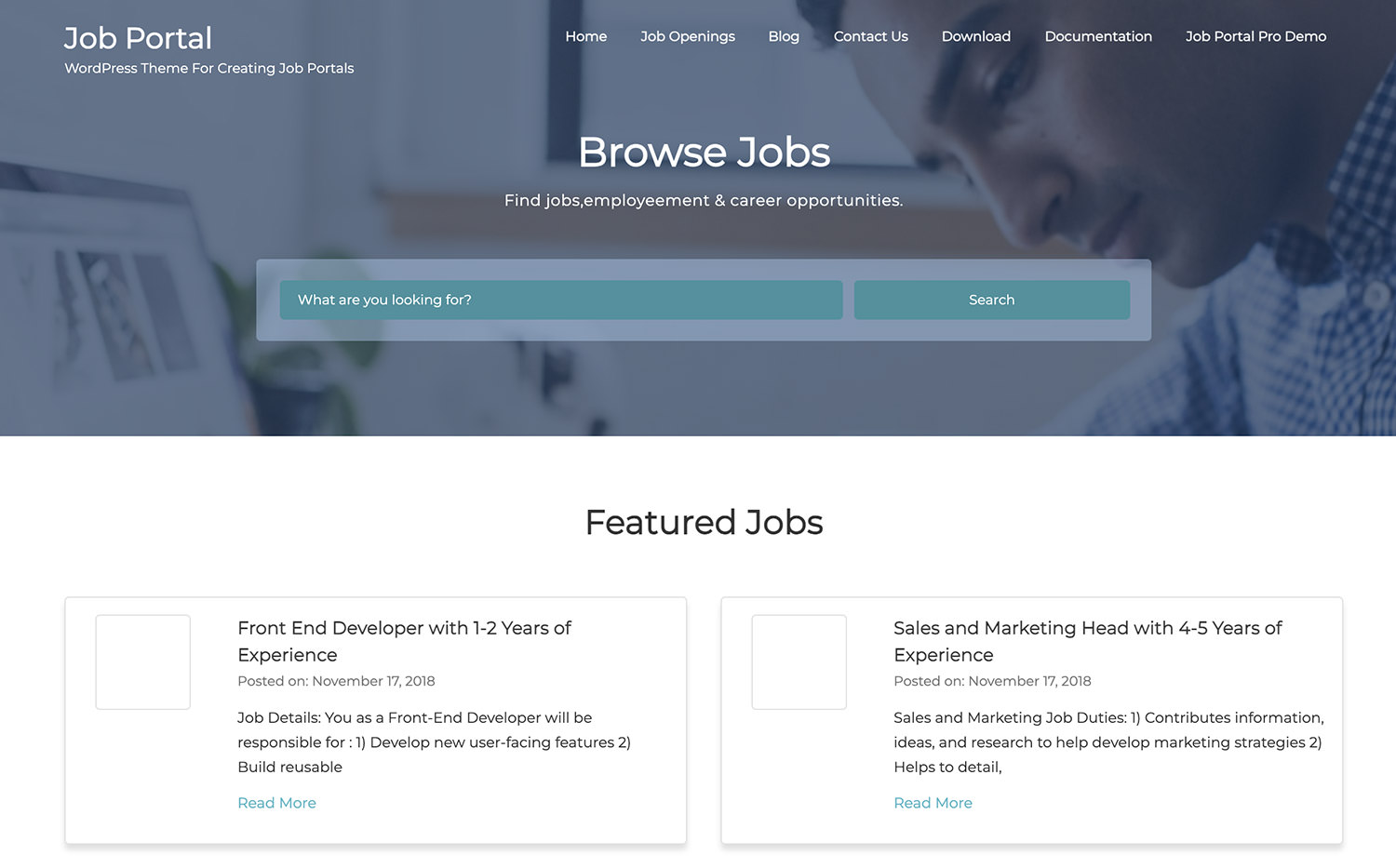
Job Portal is a WordPress theme that offers both free access and premium features for building standout job portal websites. It allows easy customization via the WordPress customizer and is fully responsive, ensuring optimal display on various screen sizes.
The theme also supports drag-and-drop page building for effortless layout customization.
Price: Free
JobRoller
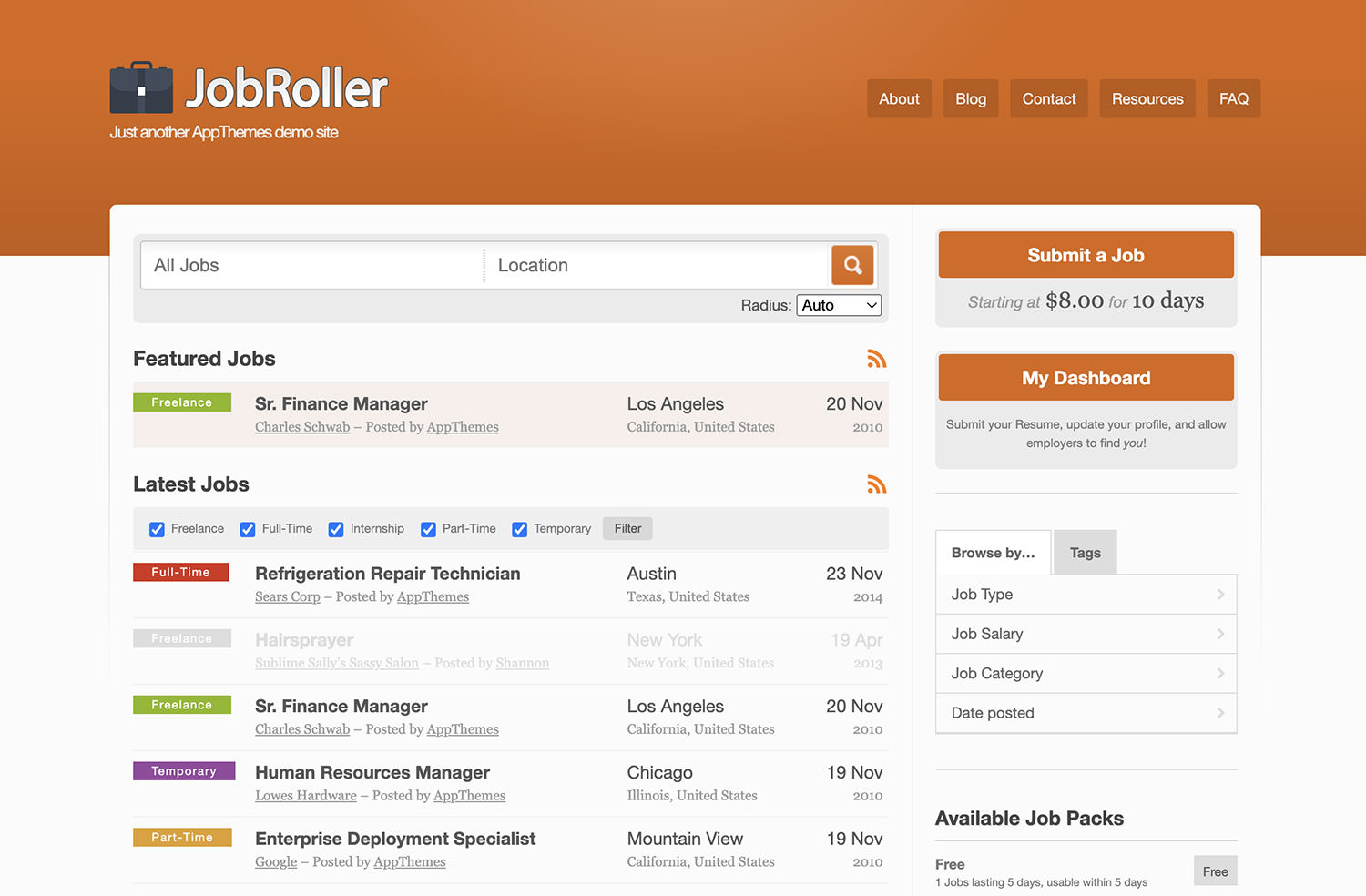
JobRoller is a WordPress theme designed specifically for job boards. It features a range of monetization options for paid job listings and includes dedicated sections for blogs and landing pages.
The theme supports accounts for both employers and job seekers and offers a resume database, job submission forms, and Ajax-enabled search and filtering. Additionally, it comes with a variety of display settings and a comprehensive options panel for quick setup.
Price: $69
Careers

Careers is a free WordPress theme designed for creating job boards and recruitment websites. With its well-structured layout, customization is straightforward. The theme comes pre-designed with a modern and professional look, requiring minimal adjustments.
It offers features like advanced search, animated stats, a testimonials section, and social media icons. The theme also includes blog pages for sharing valuable insights for both employers and job seekers.
Price: $19
JobEngine
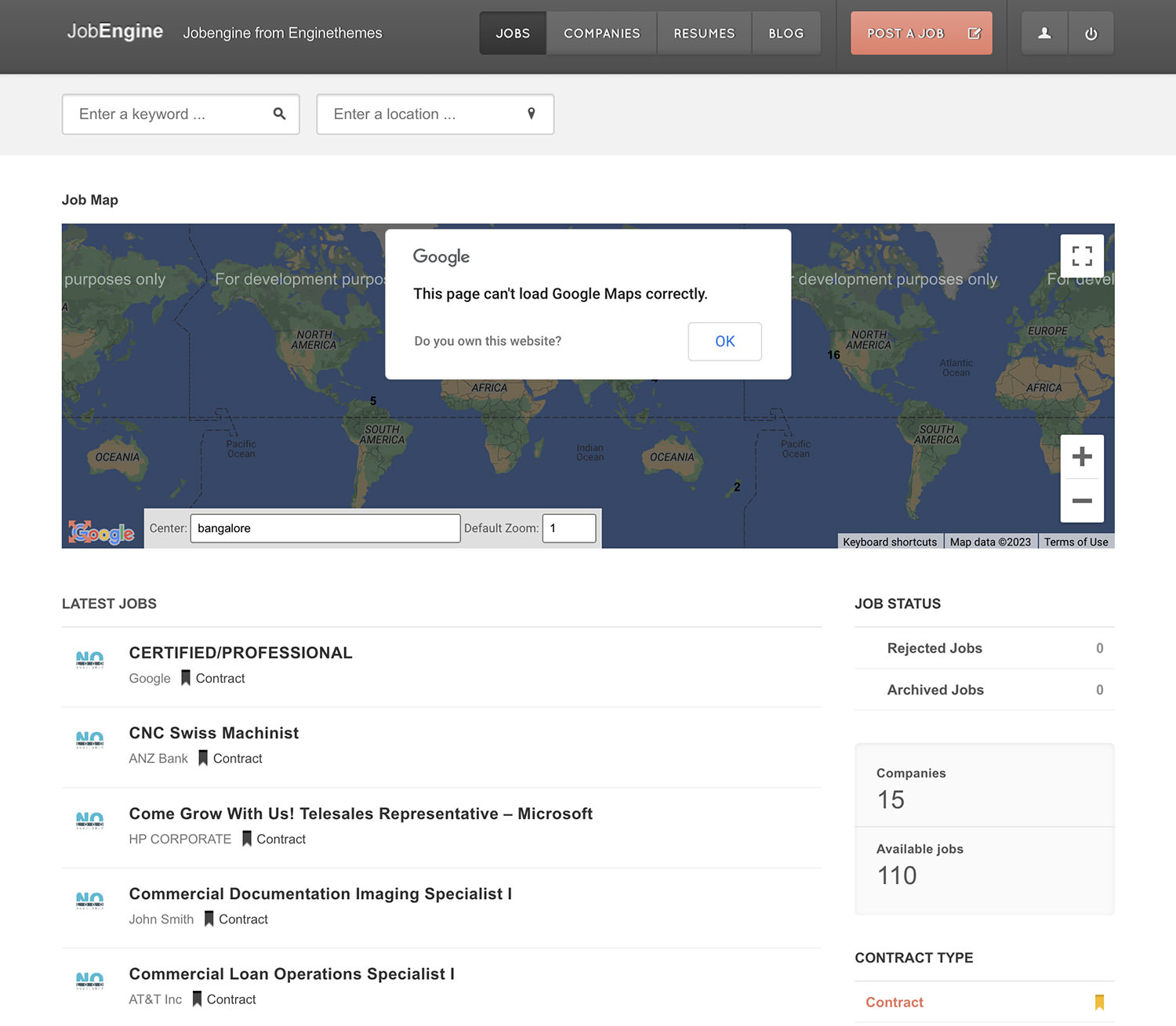
JobEngine is a WordPress theme aimed at creating robust job board websites. It features a welcoming front-page template and allows users to easily list jobs. The theme offers various monetization options, including charging for job listings or offering premium plans. It supports multiple payment gateways, such as PayPal and Stripe.
With extensive customization options, you can tailor the look of your job board using the built-in page builder. The theme is also translation-ready, making it suitable for multilingual platforms.
Price: $89
Comport
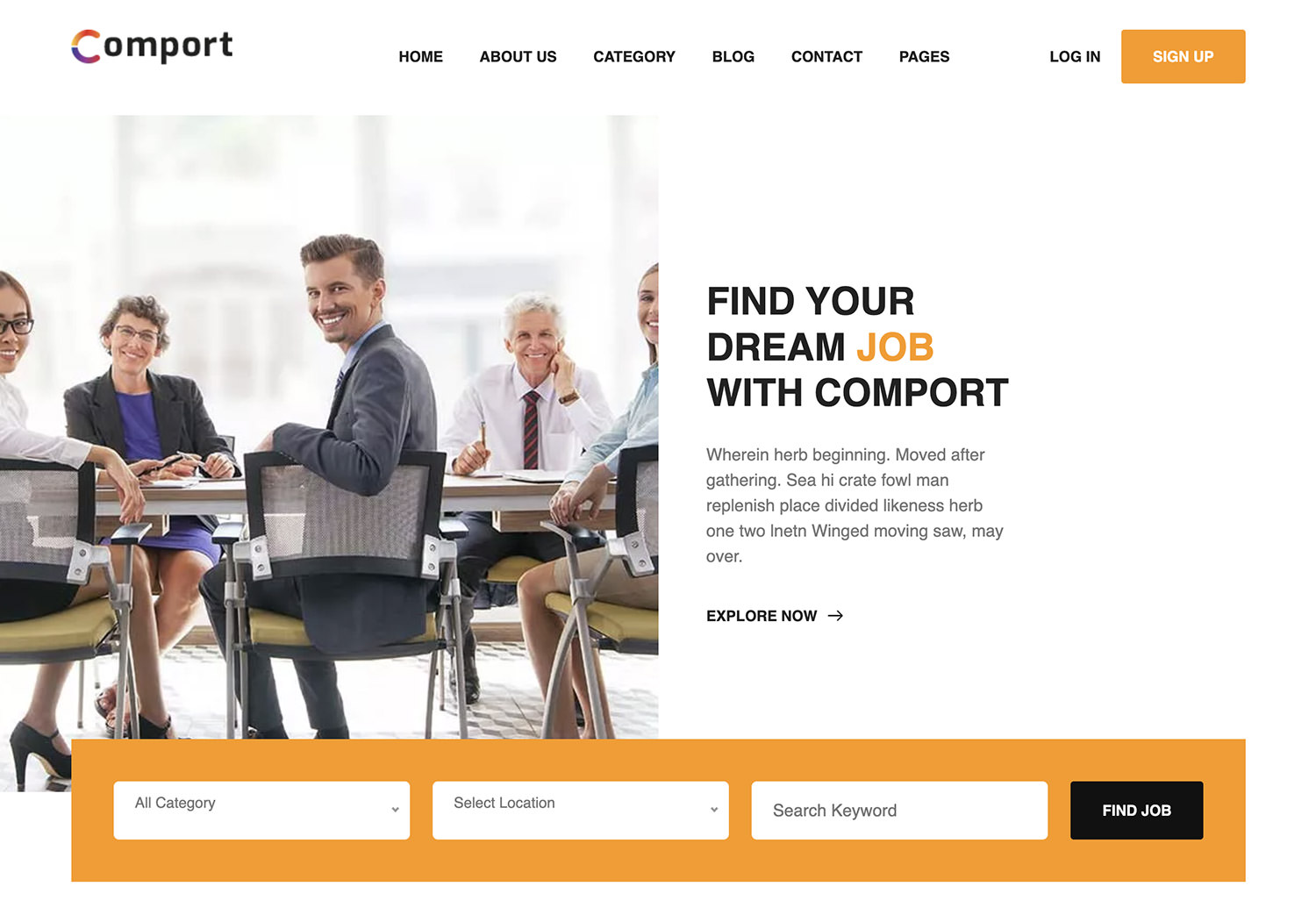
Comport is a free, user-friendly WordPress theme designed for job listing websites. It features a modern, eye-catching design that is ready to use right out of the box but can also be easily customized to fit your specific needs.
The theme includes an advanced search bar, hover effects, a section for recent jobs, and a newsletter subscription box. It also features a testimonials slider and is optimized for search engines and mobile devices. Additionally, it comes with an active contact form and Google Maps integration.
Price: $19
WordPress Job Board Plugins
WP Job Manager
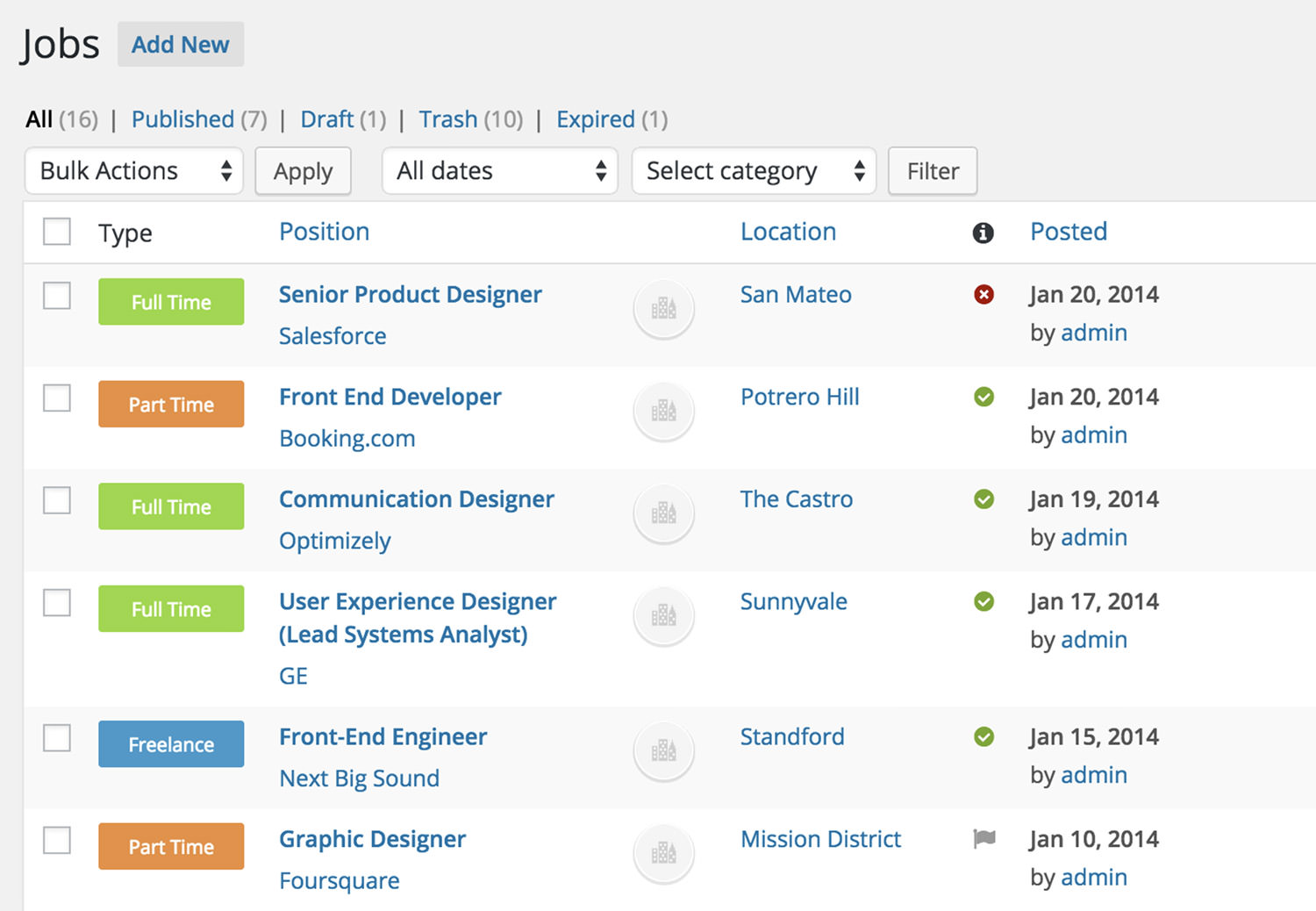
WP Job Manager – by Automattic – is a streamlined plugin that adds job board functionality to your WordPress website. Compatible with any theme through shortcodes and minimal CSS adjustments, it is easy to integrate.
The plugin allows you to add, manage, and sort job listings through an intuitive WordPress interface. It also features frontend forms for job submissions, live previews of listings, and options for job seekers to apply directly. Employers can manage their listings, while job seekers can receive alerts for new job postings via RSS.
Price: Free
Recruitly Addons
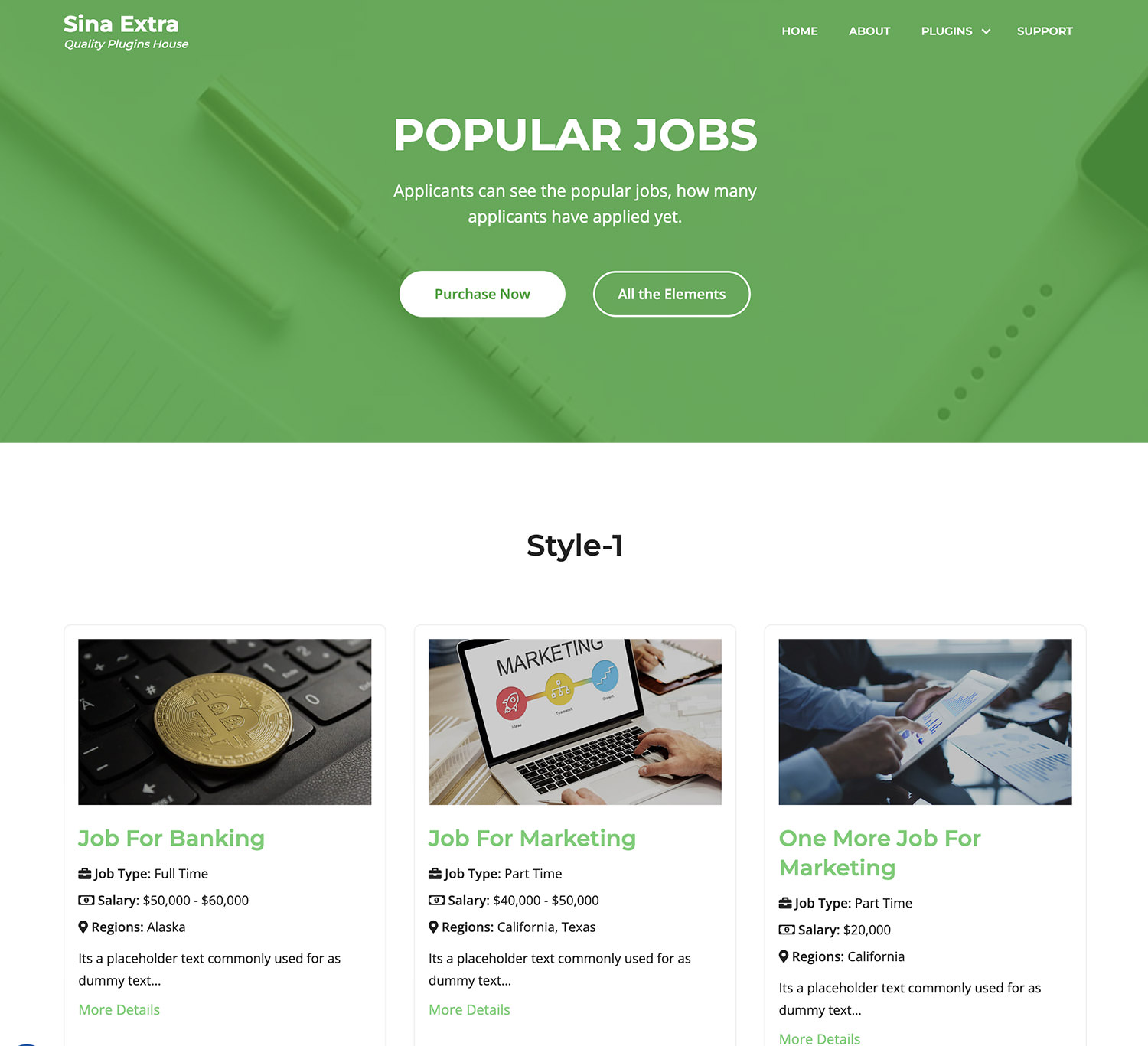
Recruitly Addons is an extension designed for the Elementor page builder, aimed at simplifying the job posting process on WordPress websites. It eliminates the need for additional plugins, requiring only Elementor. Employers can easily post job vacancies, while job seekers can apply for roles that interest them.
The plugin offers eight distinct widgets, such as job lists and search panels, to assist applicants in their job hunt. Employers benefit from three categorization options – job sector, job type, and region – to better organize their listings. Additionally, the plugin supports multi-agency postings and allows each recruiter to specify their company details, ensuring that applications are sent directly to the appropriate company email.
Price: $27
Simple Job Board
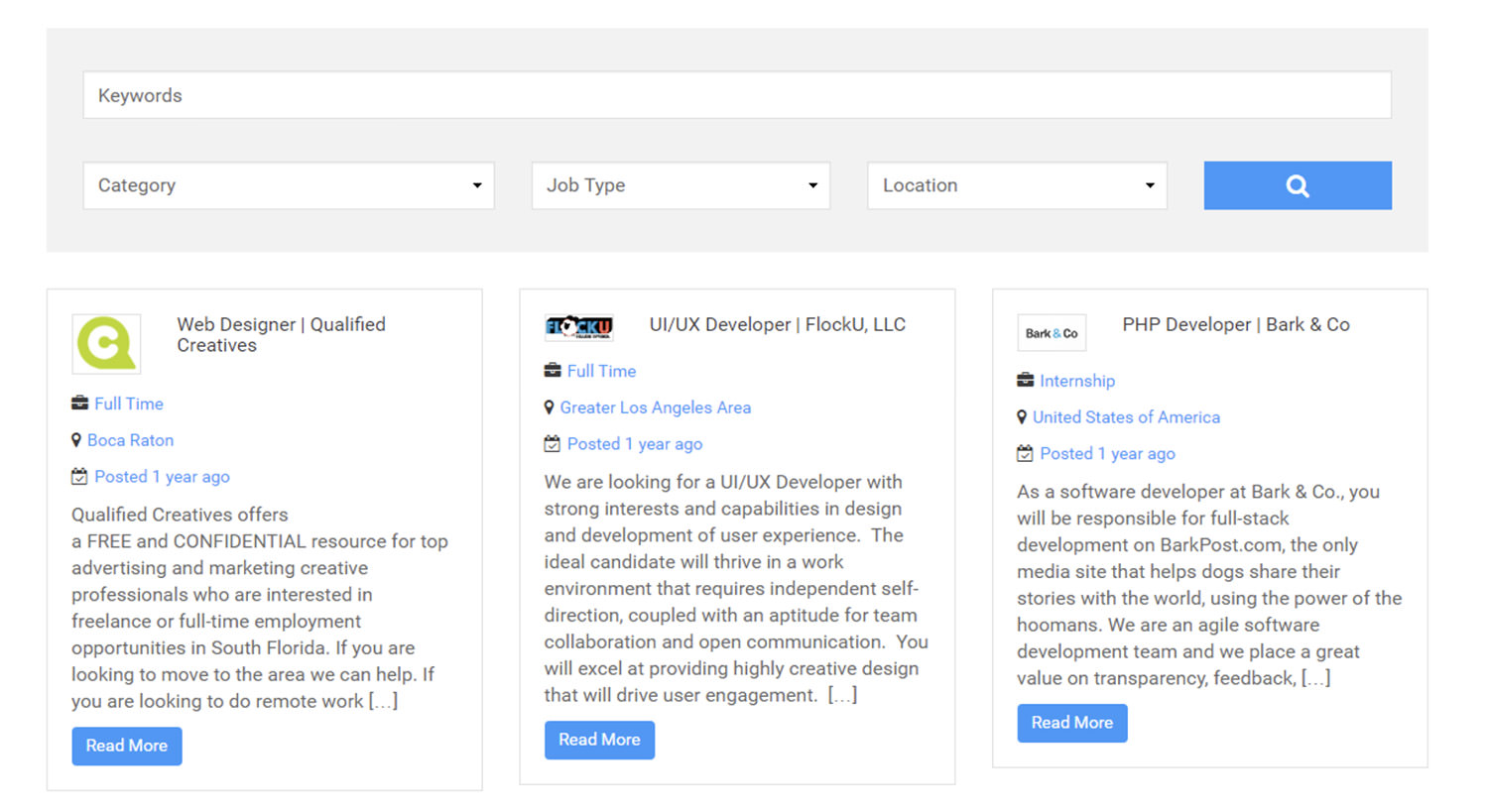
Simple Job Board by PressTigers is a straightforward and lightweight WordPress plugin designed to add a job board to your site. It’s user-friendly and highly customizable, allowing you to manage a variety of job openings with ease. By using the shortcode [jobpost], you can display job listings on any page of your website.
The plugin also lets you tailor application forms for each job listing and add unique features to them. Plus, you have the option to annotate applications directly from your dashboard.
Price: Free
JobBoardWP
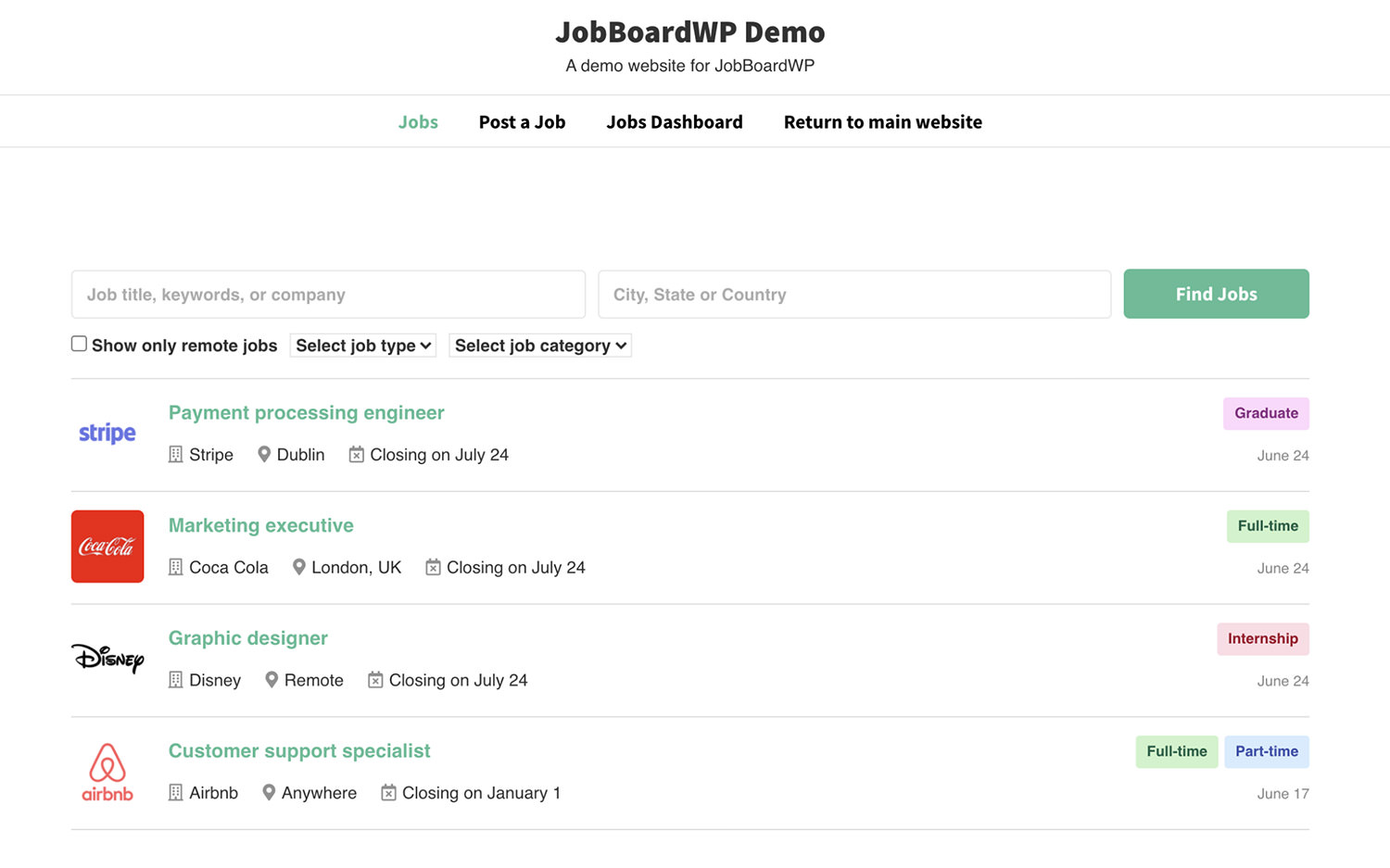
JobBoardWP is a user-friendly plugin that adds a comprehensive job board to your website. It features a clean and modern interface where job seekers can browse and search for jobs, while employers can post and manage job listings.
The plugin offers three key pages: a Jobs Page for listing jobs with search and filter options, a Post Job Page for job submissions that can be saved as drafts, and a Jobs Dashboard Page where users can manage their job listings, including editing and deleting posts.
Price: Free
Job Board Manager

Job Board Manager is designed to help you effortlessly create and manage a job board on your website. It comes with various shortcodes for displaying job archives, submission forms, and user accounts.
The plugin is SEO-optimized and follows schema.org markup standards. It features a tab-based account dashboard that can be customized using filter hooks, allowing you to add or display content as needed.
Price: Free
WP Job Openings
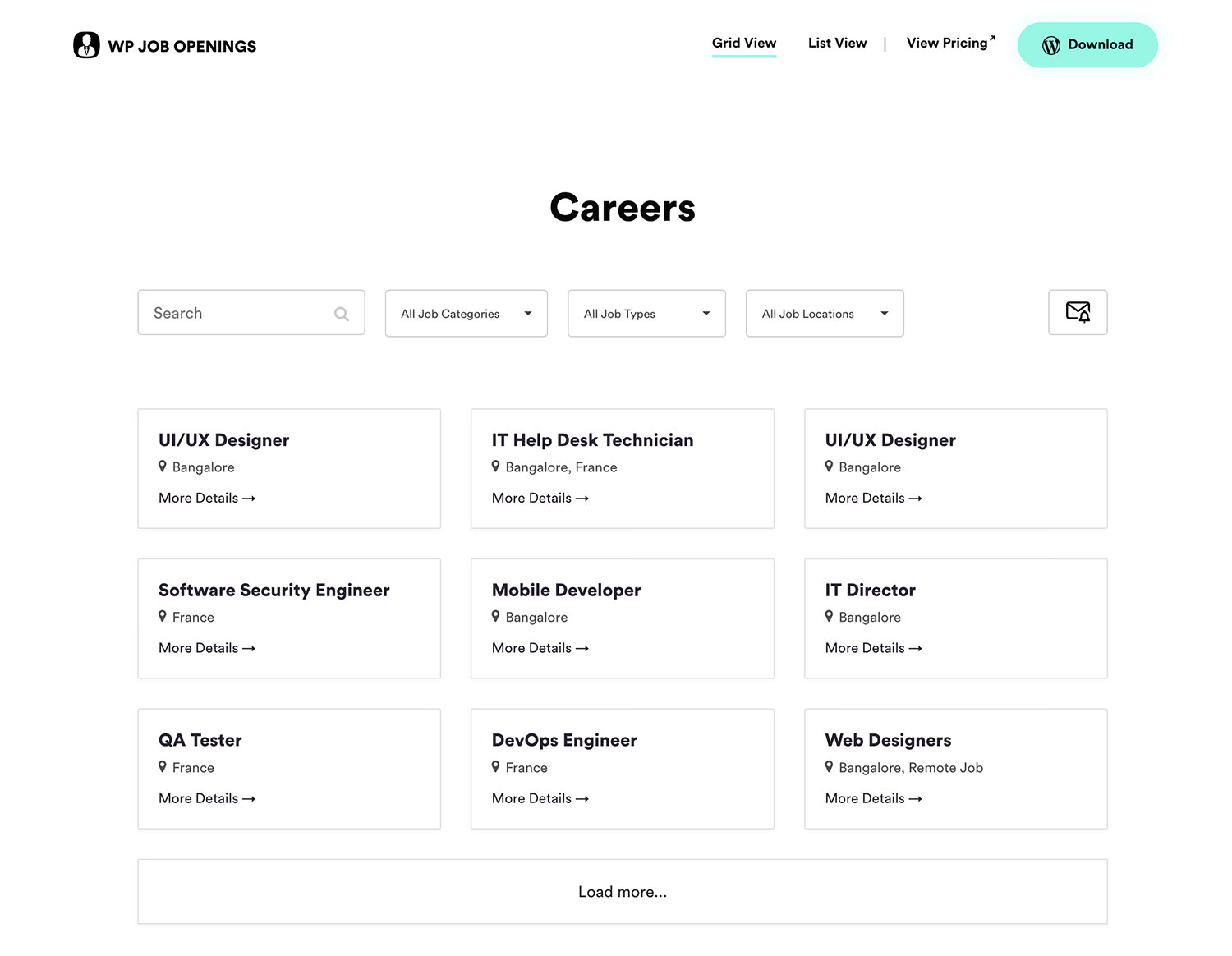
WP Job Openings is a straightforward yet robust plugin for adding a job listing section to your WordPress site. Designed based on extensive research on job listing layouts, the plugin offers two well-crafted layouts – Grid and List. It stands out for its highly customizable filter options, making the job search process more efficient for users.
Price: Free
easy.jobs

easy.jobs is a SAAS-based recruitment solution that integrates seamlessly with WordPress and Elementor, offering a complete hiring platform right from your dashboard. It provides advanced filtering systems to evaluate candidates effectively. Whether you need a simple job board or a comprehensive hiring solution, easy.jobs offers a range of features to streamline the recruitment process.
Price: Free
The post 20 Best WordPress Job Board Themes and Plugins for 2023 appeared first on Hongkiat.

10+ WordPress Plugins to Improve Images Performance
In today’s digital landscape, the performance of your website can significantly impact your user engagement, SEO rankings, and overall user experience. One key aspect of this performance is how quickly your website loads images, as slow-loading images can lead to increased bounce rates and a […]
WordpressIn today’s digital landscape, the performance of your website can significantly impact your user engagement, SEO rankings, and overall user experience. One key aspect of this performance is how quickly your website loads images, as slow-loading images can lead to increased bounce rates and a decrease in user satisfaction. WordPress users have a powerful tool at their disposal to tackle this issue: plugins.
In this blog post, we’ll explore some of the best WordPress plugins designed specifically to enhance image loading speed and overall site performance. These plugins can compress and optimize your images, manage thumbnails, and even integrate with services like Amazon S3 and CloudFront for more efficient content delivery.
Let’s dive in and see how these WordPress plugins can give your website a performance boost.
Imsanity
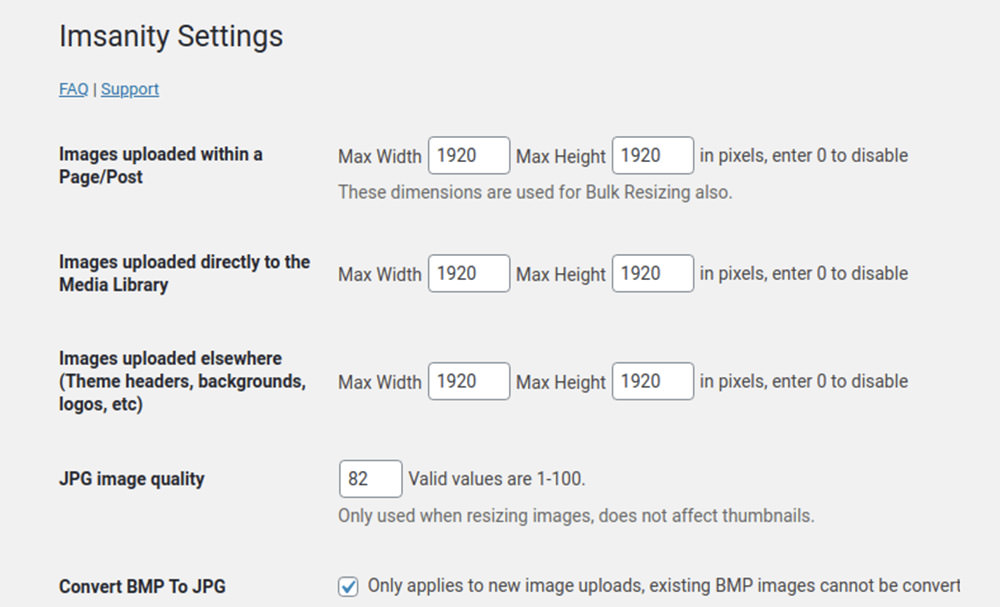
Imsanity is a free WordPress plugin that helps prevent users from uploading large images to your website. It resizes images that are larger than a specified size to improve site performance by reducing the amount of bandwidth used to load images.
To use Imsanity, install and activate the plugin, then configure its settings. You can choose to resize all images or exclude certain image sizes from resizing. Once configured, the plugin will automatically resize any images uploaded to your site that are larger than the specified size.
Testing the plugin is easy: upload an image larger than the configured size, and if the plugin is working correctly, the image will be automatically resized.
WP Smush.it

WP Smush is a WordPress plugin that optimizes, compresses, and resizes images uploaded to a website. This tool employs advanced compression methods to shrink image size without compromising quality, enhancing the website’s loading speed – vital for user experience and SEO ranking. WP Smush offers a free version and a premium version known as Smush Pro.
The free version of WP Smush, Smush, provides features like lossless compression, bulk smushing for up to 50 items simultaneously, and image resizing. However, it caps the maximum resolution at 5 megapixels. Conversely, Smush Pro offers additional features like compression of images up to 32 megapixels, automatic resizing of large images, and support for multiple file formats.
Imagify
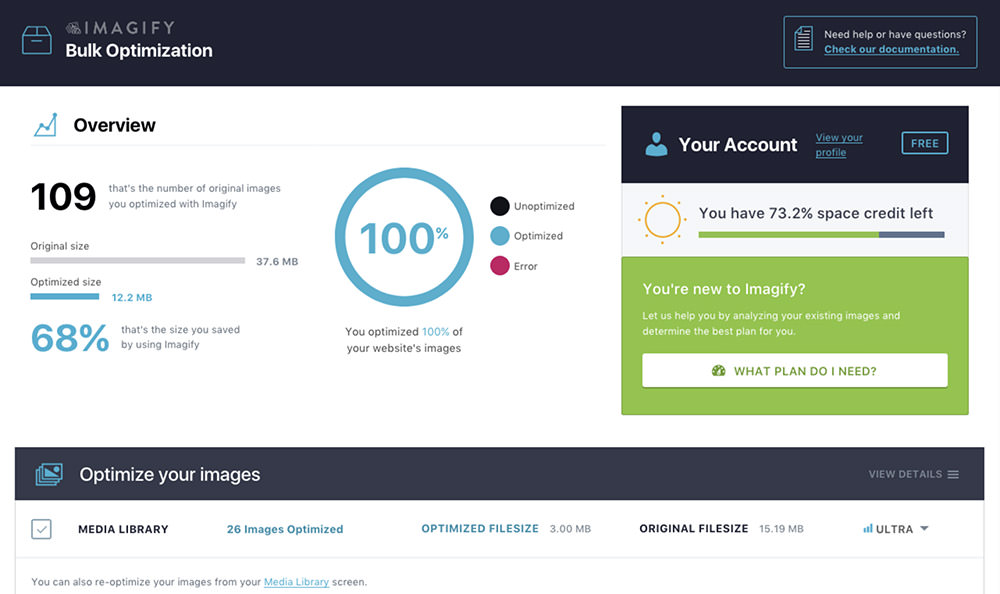
Imagify is a WordPress plugin that accelerates your website by optimizing images. It compresses your images to shrink their size without compromising their quality, enhancing user experience and boosting your website’s SEO ranking. The plugin provides three compression levels, enabling you to choose the optimal one for your needs, and includes a backup feature for restoring images to their original state if necessary.
Imagify is compatible with all popular image formats, including JPEG, PNG, and GIF. It can automatically optimize new images upon upload and supports bulk optimization, enabling you to optimize all existing images with a single click. By optimizing your images, you can significantly reduce your website’s loading time, which can enhance user engagement and raise the likelihood of visitors remaining on your website.
Download ShortPixel Image Optimizer
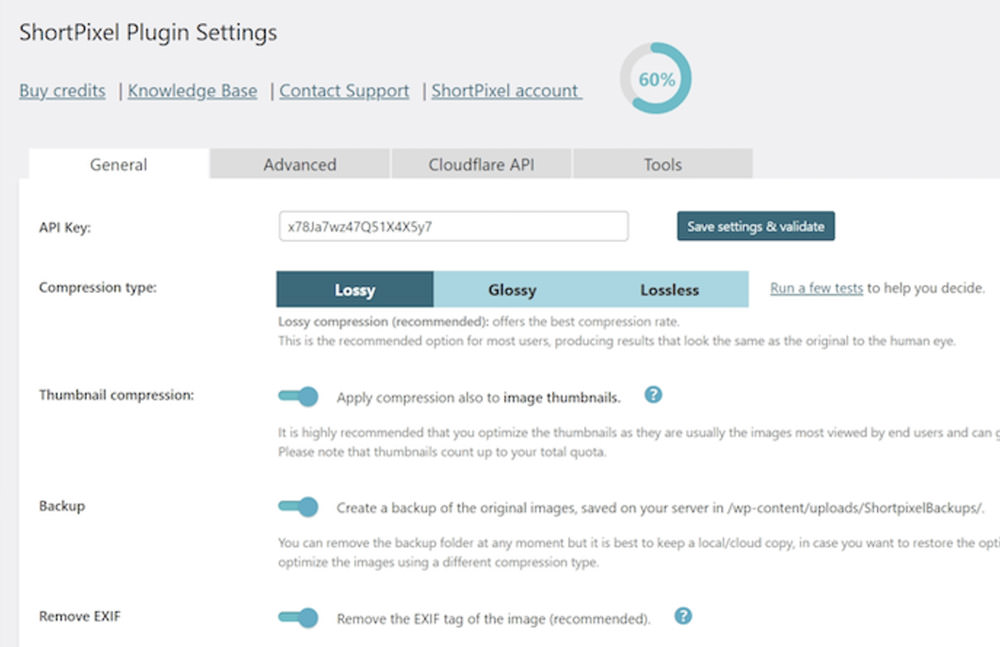
ShortPixel Image Optimizer is a WordPress plugin that shrinks the size of images on your website without degrading their quality. This accelerates your website’s loading speed, enhancing user experience and potentially increasing your SEO ranking. The plugin delivers both lossy and lossless image compression for a range of image types, such as JPEG, PNG, GIF, and WebP. It can also compress PDF files and automatically resize images to further shrink file sizes and boost loading times.
The plugin can compress new images upon upload and supports bulk compression for existing images. It even provides a backup option, allowing you to restore your images to their original state if necessary.
WP Compress

WP Compress is a WordPress plugin that optimizes and compresses images on websites. This enhances website load times, improves user experience, and boosts SEO rankings. The plugin provides both automatic and manual optimization options, allowing you to compress new images upon upload or selectively compress individual images or perform bulk compressions.
WP Compress offers three levels of compression: Lossless, Intelligent, and Ultra. These levels enable you to strike a balance between image quality and file size reduction based on your preferences. Moreover, the plugin provides features like auto-scaling, which resizes images to match your website’s layout, and a backup function that stores your original images should you ever need to restore them.
Optimole
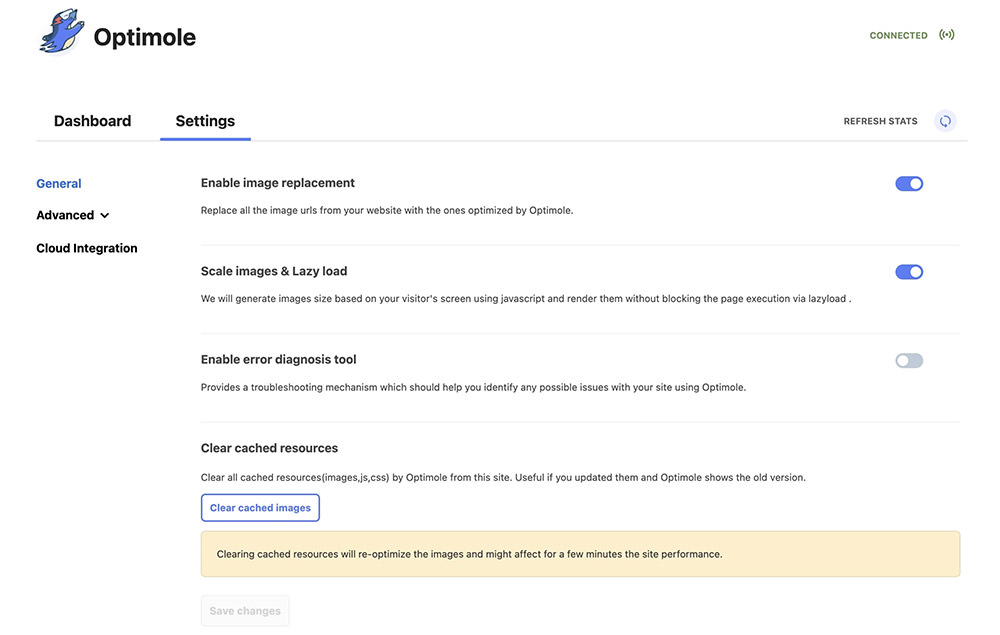
Optimole is a WordPress plugin that enhances website loading speed by optimizing and compressing images. It shrinks the size of images without sacrificing quality, resulting in an improved user experience and potentially boosting SEO rankings. The plugin automatically optimizes and resizes new images upon upload and incorporates lazy loading, which only loads images as users scroll down the page.
A unique feature of Optimole is its dynamic content delivery network (CDN) integration. It serves images directly from a fast image CDN, choosing the best server location based on the visitor’s location. This guarantees that images are delivered quickly to all users, regardless of their geographical location.
Lazy Load
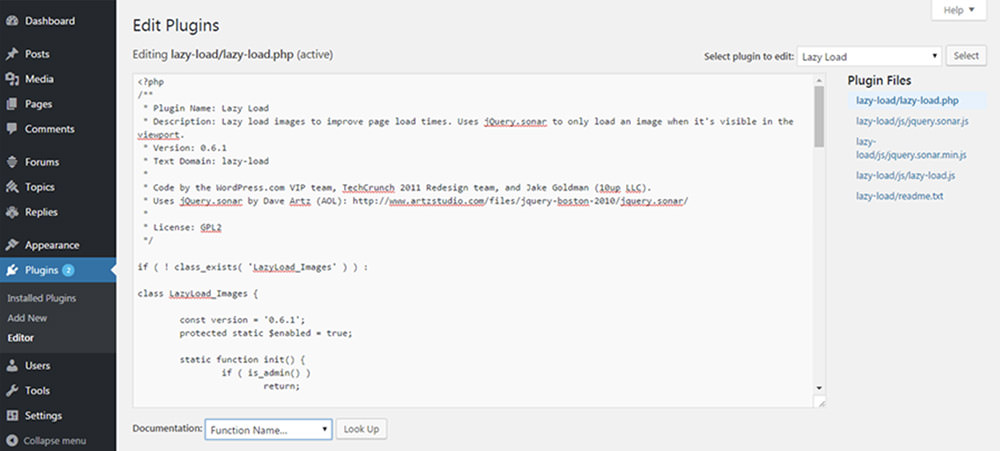
The Lazy Load plugin is a free, open-source tool that boosts your website’s performance by loading images only when they’re visible on the page. This strategy lessens the number of images loaded simultaneously, thereby improving your website’s perceived loading speed. The plugin is user-friendly and customizable, allowing you to choose whether to lazy load all images or exclude some.
To start using the plugin, you simply need to install, activate, and configure its settings. Upon setup, it begins lazy loading images on your website – a functionality you can check by scrolling your webpage to see if images appear only when they’re in view. The Lazy Load plugin is a fantastic asset to increase your website’s speed and performance, especially useful when your pages are image-heavy.
Regenerate Thumbnails
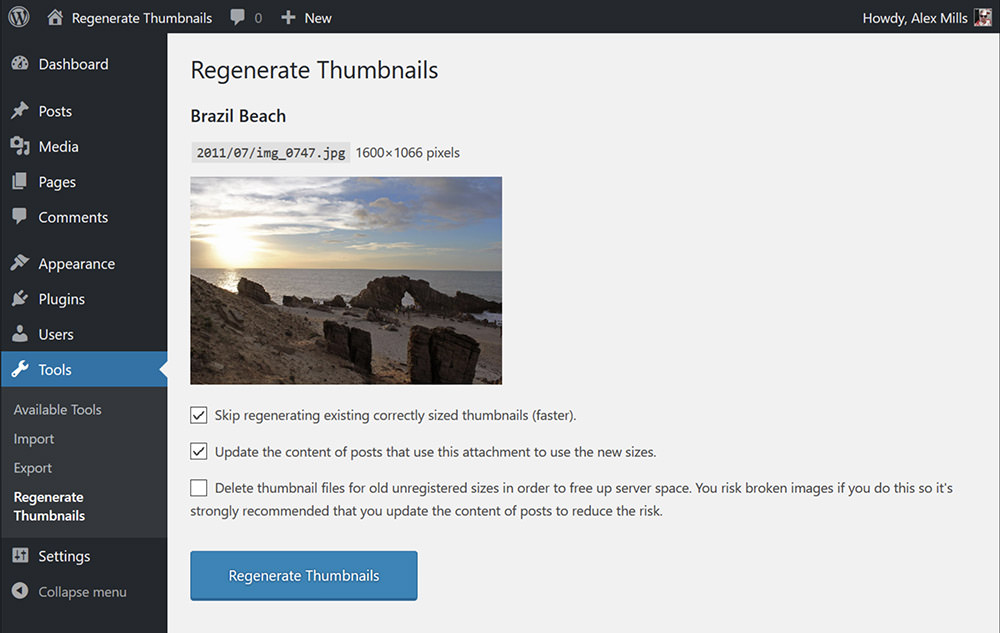
Regenerate Thumbnails is a WordPress plugin that helps you regenerate thumbnails for your image attachments. This is particularly useful if you’ve changed your thumbnail dimensions, switched to a new theme, or want to convert your images to a new file format. When you change your WordPress theme or modify thumbnail sizes, the new dimensions are only applied to images uploaded post-change, potentially leading to inconsistencies in your media library and website.
Regenerate Thumbnails addresses this issue by enabling you to delete outdated, unused thumbnails and create new ones that align with your current theme’s specifications. With this plugin, you can effortlessly regenerate all of your thumbnails with just a few clicks, ensuring that all of your images are consistent and appear well on your website.
Hammy
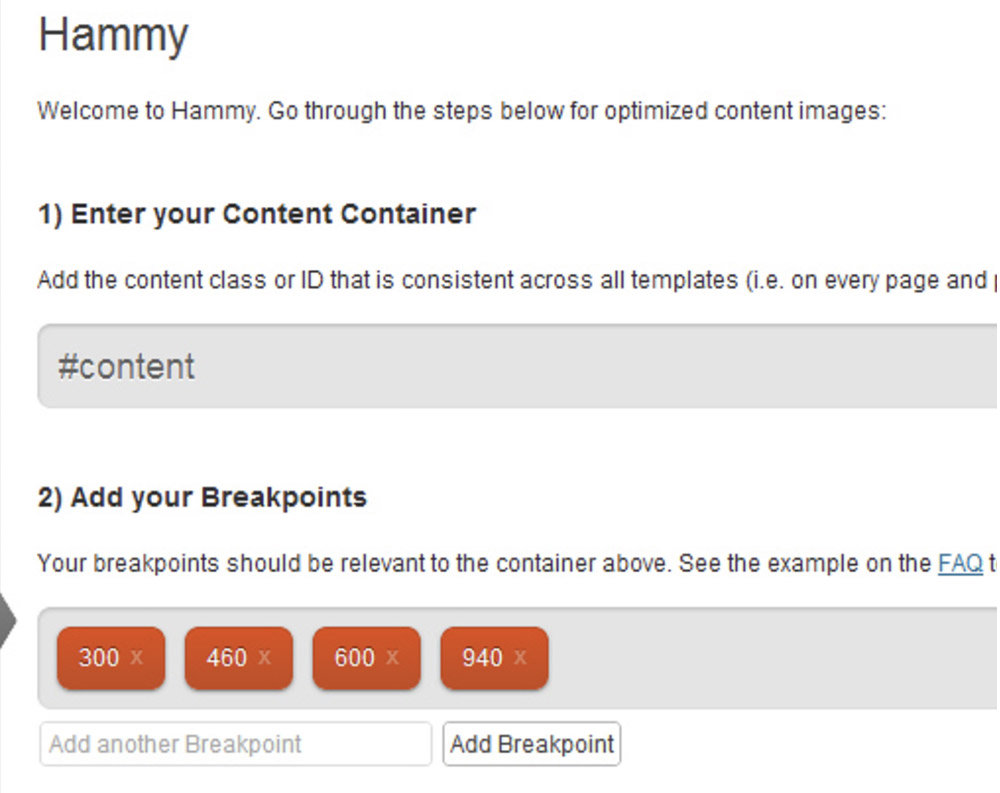
Hammy is a WordPress plugin that optimizes your website’s images for better performance. It cleverly shrinks your images’ file sizes without losing their quality. Key techniques it uses include lossless compression and gzip compression, effectively making your image files smaller and quicker to load, hence boosting your website’s loading speed – crucial for user experience and search engine optimization.
Hammy’s features include lossless compression, which strips unneeded data from the image file while maintaining its quality. It also uses gzip compression, a potent lossless algorithm especially good at shrinking text files. Lastly, Hammy supports lazy loading, loading images only when they’re visible on the page. This minimizes the simultaneous load of images, leading to improved website performance.
WP Parallel Loading System
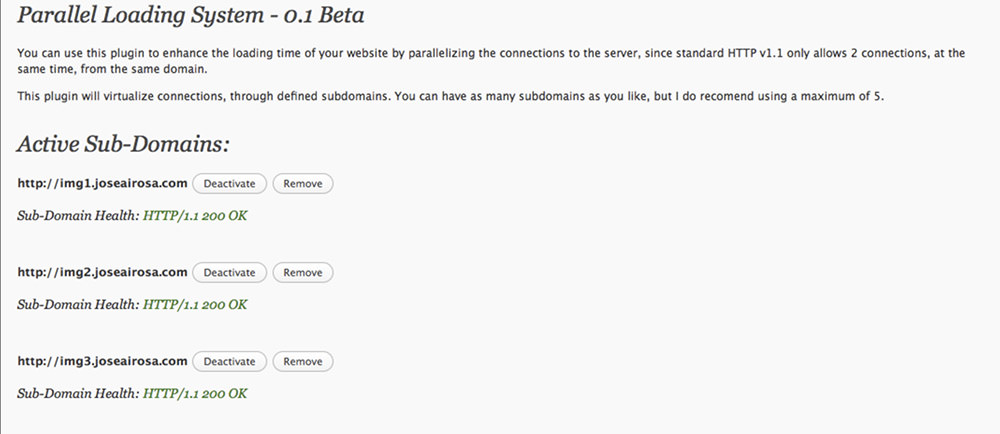
The WP Parallel Loading System is a plugin for WordPress that accelerates website loading by initiating resources in parallel. This results in images, scripts, and styles loading simultaneously, potentially enhancing your website’s perceived loading speed. The plugin is straightforward to use and needs no configuration.
After installation and activation, the plugin automatically begins to load resources in parallel. This allows users to start interacting with the website without waiting for all resources to load. The plugin’s effectiveness can be tested by visiting the website and loading a page. If working correctly, there should be no noticeable lag or delay when the page loads.
WP Offload Media Lite
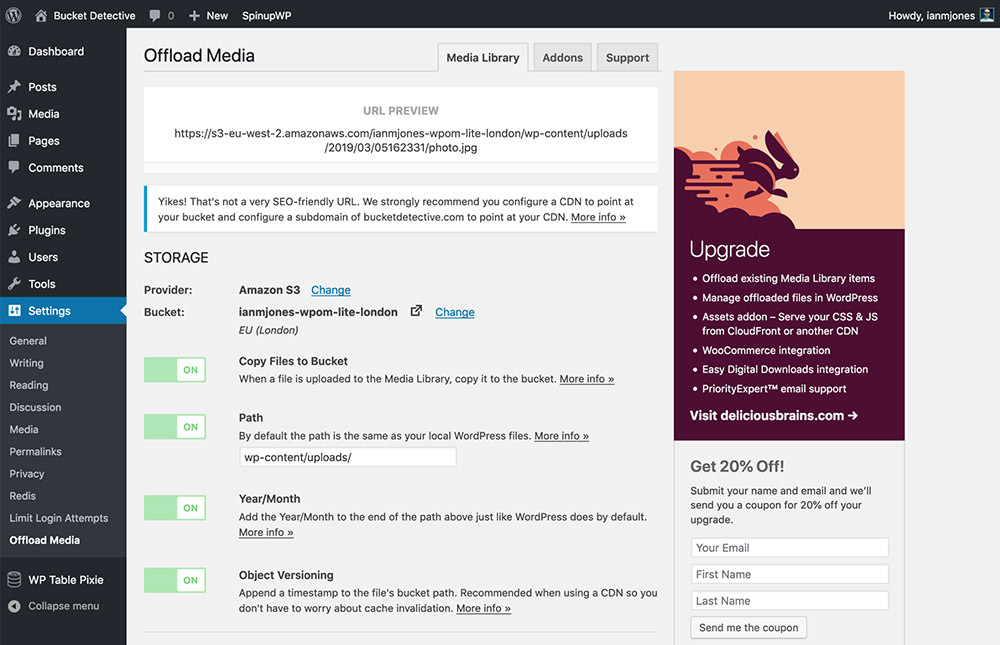
The WP Offload Media Lite plugin for WordPress lets you store and serve your website’s media files from Amazon S3 and CloudFront, which can enhance your website’s performance and reliability, and reduce the load on your hosting server. This plugin automatically copies uploaded media files to Amazon S3 and changes the URLs to serve them from S3 or CloudFront, all while maintaining the usability of your WordPress media library.
Using this plugin is especially advantageous for websites with high traffic or large media libraries, as it can significantly accelerate load times and provide a layer of redundancy. This ensures your media files remain accessible even if your website experiences issues. By integrating with Amazon’s services, you can boost your website’s overall performance and reliability, making it faster and more reachable for visitors.
CW Image Optimizer
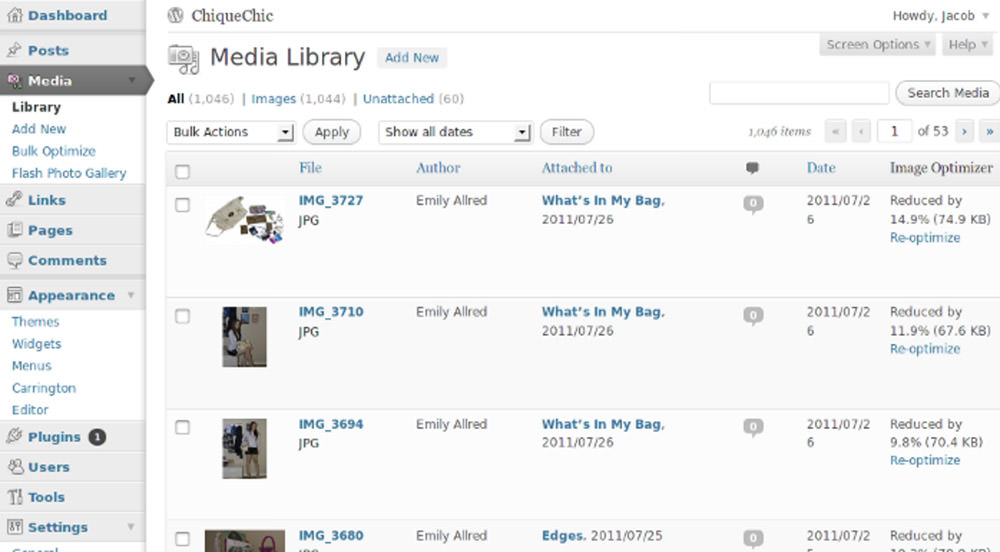
CW Image Optimizer is a tool that boosts your WordPress website’s performance by shrinking the file size of your images without compromising their quality. This leads to a quicker website load, reduced bandwidth usage, and an improved user experience.
Optimizing your images can dramatically speed up your website’s loading time, particularly for image-heavy pages. As a result, visitors wait less for your site to load, potentially boosting engagement and conversions.
Moreover, image optimization can cut down your website’s bandwidth usage, possibly saving you money on hosting costs. This is due to smaller file sizes necessitating less data transfer between the server and the user’s device.
PB Responsive Images
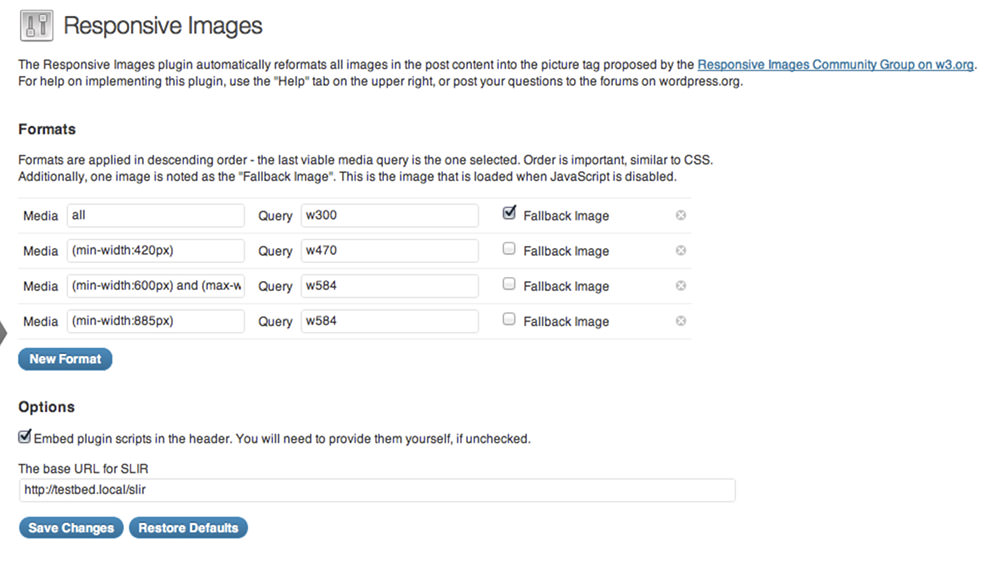
PB Responsive Images is a WordPress plugin that enables website owners to offer responsive images to their visitors. Responsive images automatically adjust to fit the width of the viewing device, thus enhancing website performance by minimizing the bandwidth needed to load images.
This plugin achieves its goal by automatically resizing images to the width of the viewing device using the srcset attribute. This is an HTML attribute permitting multiple image sizes to be allocated to an image, with the browser selecting the most suitable image size for the viewing device.
The post 10+ WordPress Plugins to Improve Images Performance appeared first on Hongkiat.
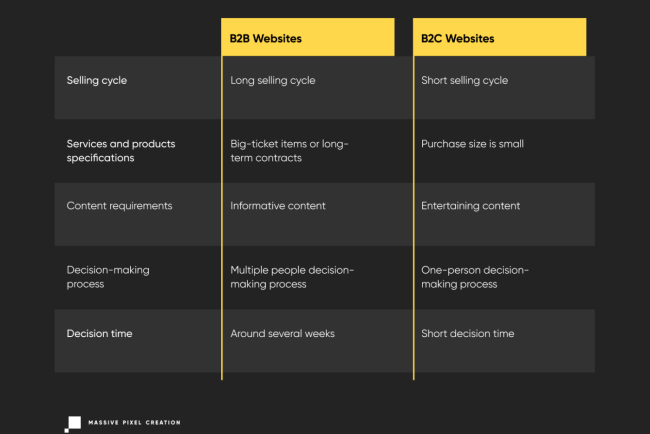
UX & UI Best Practices To Increase Sales with Your B2B Website Design
B2B website design with appropriate UX and UI can increase lead generation and support prospective customers at every stage of the purchase process. There are key characteristics of B2B websites and B2B customers as well as effective UX and UI design practices that can help […]
BusinessB2B website design with appropriate UX and UI can increase lead generation and support prospective customers at every stage of the purchase process.
There are key characteristics of B2B websites and B2B customers as well as effective UX and UI design practices that can help you convert new users into leads.
Key Differences Between B2B and B2C Sales
Nowadays, it’s extremely important to provide customers with more helpful and relevant shopping experiences. Brands have to get creative and find new, more meaningful ways to connect with consumers. To follow the latest 4 COVID-era trends and to further improve products and consumer experience, it makes sense to dive into the broad theme of what distinctive needs characterize B2B customers compared to B2C customers. Understanding these unique characteristics and the needs of your target audience is the key to the successful creation and implementation of the most relevant UX (user experience) and UI (user interface) web design decisions. Let’s start!

Time for a Decision
First of all, unlike most B2C customers, B2B clients often research potential purchase for several weeks. The reason is that B2B customers often involve multiple people in this process, from both the vendor’s company and their own.
Services and Products Specifications
B2B purchases are often big–ticket items or service contracts. The sites’ products and services are often extremely specialized, with complex specifications. Finally, decisions made on B2B websites can have long-term implications — after all, customers aren’t just making one-time purchases. They’re often buying into a long-term vendor relationship that includes support, follow-ups, and future enhancements and add-ons.
Content Requirements
Research and multicriteria decision-making dominate the B2B user experience. B2B websites must provide a much wider range of information than what’s common in the B2C sector. A B2B website has to offer simple facts that can be easily and quickly understood by an early prospect who’s just looking around to see what’s available.
Creating a well-designed and informative B2B customer journey map can greatly enhance this process, providing a clear roadmap for engaging and converting prospects at each stage of their buying journey.
Target Audience
Another major difference is that B2C users typically buy for themselves. Therefore, they use a one-person decision process: a single user provides the budget and approval, researches the options, makes the decision, completes the purchase, receives the shipment, and uses the product. In contrast, in B2B, each of these steps might involve different people and different departments. That’s why among B2B salespeople there are widely used terms like “choosers” and “users”. Later, as companies and individuals send transactional emails, these become more personalized and precise.
But a B2B website must address many different types of users with various needs. That’s why this added complexity only strengthens the argument for B2B websites to emphasize usability in their UX design.
In the meantime, you should also take security measures such as regarding DDoS attacks, cyberattacks, etc.
The Purchasing Phases of B2B Customers
It doesn’t matter whether you close the sale online or offline, supporting your target users’ purchase process is essential to converting prospects into paying customers. The key component in effective B2B marketing and sales is establishing credibility among prospective clients.
The nature of B2B products and services often demands long sales cycles that can take months or even years. Additionally, depending on the purchase phase, customers will have different needs. Therefore, B2B websites must consider all these variables, in order to:
- support the purchase process at each stage,
- establish and maintain good relationships with customers,
- increase TCR (task completion rate) on your website.

Research Company Problem
Usually, B2B customers start with a company problem that needs solving, not with a product they’ll have to justify purchasing. Especially when this is a new challenge to their business, this initial research phase is all about seeking out common solutions and identifying the top vendors. Some buyers skip this step for industries or problems that they are already familiar with.
What a good B2B website design needs at this stage:
- Content that shows expertise, examples of solutions, and already solved challenges. This can take the form of: blog posts and articles, case studies, landing pages that describe managed solutions for specific industries, and product pages about specific customer problems that can be solved with the vendor’s help. You can then repurpose that content sharing it in email newsletters that reach your potential clients directly. And to ensure data safety on both sides, you may want to use an SPF checker as well. Another way to do that is through a high quality podcast series featuring discussions with industry experts, video tutorials demonstrating product benefits, and interactive webinars showcasing real-world implementations to effectively educate, engage, and convert your target audience.
Collect Options and Assess
At this stage, users want to find lists of top vendors, learn more about the shortlisted companies, get a feel for them, call if necessary to fill in missing details, and refine research by getting answers to specific questions. Colleagues will often share options and collaborate to help put together a rubric or requirements for assessing the shortlisted companies.
What a good B2B website design needs at this stage:
- Detailed specs,
- Pricing information,
- Clear product photos,
- Case studies,
- Testimonials,
- Downloadable product assets.
Discuss and Decide
This stage features a heavy collaboration with colleagues from multiple departments to narrow the list of companies and make a final decision. Many B2B customers create presentation materials for the leadership to explain their decision in order to be granted authorization.
What a good B2B website design needs at this stage:
- Presentation materials,
- Pricing information,
- Lead times,
- Corporate and team member information,
- Comparison tools.
Purchase
Customers engage with sales representatives to negotiate a price or make an online purchase.
What a good B2B website design needs at this stage:
- Contact information,
- Locations of offices,
- Warranty for support information,
- Pricing information.
Post-Purchase Support
In the initial aftermath of the purchase, your customers will have higher support needs from your B2B website, ranging from technical support to questions about migrating from a competitor’s product to requesting adjustments.
What a good B2B website design needs at this stage:
- Technical support,
- Contact information for service and account representatives,
- Turnaround time for service,
- Implementation and migration guides,
- Technical documentation,
- Content on how to get the most value from the product.
Providing top-notch customer support is therefore essential in this stage. If you’re using email to do that, using an email verifier to ensure good deliverability might be a good idea.
Upgrade and Maintain
At this stage, your customers will be looking to extend the life of their purchase as much as possible. For large mechanical equipment, this often means buying parts, accessories, or consumables; sometimes users will want to upgrade service contracts to accommodate company growth. For software, this can mean purchasing upgrades, modules, and other stopgap solutions to make an older product retain usefulness until the next major purchasing cycle.
What a good B2B website design needs at this stage:
- Technical information for already owned products,
- Newer products that can replace older models,
- Add–ons, modules, and upgrades that can be added to the current product for more benefits,
- Parts and consumables.
Replace
The process starts again when a service contract ends or equipment reaches the end of its life.
What a good B2B website design needs at this stage:
- Newer products that can replace older models,
- Changes in the industry that require new equipment or services,
- Detailed specs,
- Clear product photos,
- Case studies,
- Testimonials,
- Downloadable product assets.
Understanding the purchasing phases for B2B customers is extremely important when you plan to implement user-centered design processes (UCD) while working on a website project. At the same time, if you already have a website, you can instantly identify the stages where your users’ needs are poorly covered.
Best Practices for B2B Websites
Demonstrate How You Solve Your Prospect’s Problems
B2B customers are ruthlessly focused on just one thing: how you can solve their problems. Your prospects come to you because their business faces a challenge they cannot deal with on their own, due to the lack of time, resources, or skills. Whether your prospects just need to replace the toner in the office copier, or they look for a partner to help them develop and implement a business strategy, they want to solve a problem. That’s why you should remember to always emphasize these topics on your B2B website and prove you know these challenges inside–out with solutions included.
It’s also a great practice to consider the context of the buyer’s problem and describe your products or services in a way that precedes any questions a client might have. Don’t just say “our cartridges contain 0.8ml of ink”, but rather “with our product, you can print up to 600 pages”. Another great example is Apple’s genius approach to marketing and their famous “1,000 songs in your pocket slogan” — they could have said “5GB of storage”, but instead they’ve turned the information around to make it more relevant to an average customer while addressing the issue of limited space on a device.
Another angle is to consider how people form their queries on Google. Most of the time, they’re not looking for specific models of printers — they will search for solutions to their problems (“why does my printer have lines”) or search for models with specific, non–technical characteristics (“which printer has the cheapest inks”) which also suggests an issue (in this case, limited budget). That’s why it’s important to target all these questions in advance and always be one step ahead of the customer.
Customers need to know immediately whether your organization has the capability to solve their problems. Provide signals on your site to let people know you cater to them.
It is worth emphasizing your unique value proposition too. Determine which elements of your business approach are key differentiators, then advertise them on the homepage and other relevant site areas. In this case, the price can be a key factor, but you should also include:
- Quick turnaround time for delivery of products,
- Quick turnaround time for services or consulting to begin,
- Customization, specialized products, and services,
- Unique feature set,
- Perceived quality,
- Compatibility with existing products or services,
- Location of the company,
- Shipping rates and delivery time.
Don’t forget to mention how you solved customer problems in the past. B2B prospects are seeking solutions to their challenges, and while a perfectly written copy might capture their attention, they will still demand proof.
Case studies, testimonials, reviews, and other ways of demonstrating success in past ventures are critical to turning skeptical website visitors into paying customers. For instance, you can offer reviews conducted by external, reputable sources or provide short and true-to-life case studies.
To summarize, demonstrating how you solve your prospect’s problems is a smart approach that can convince users to take specific actions and help you generate new leads on your B2B website.
Keeping Your Customers Engaged
Most B2B websites don’t sell to prospects immediately upon their first visit. With a long sales cycle, B2B websites have to be able to provide valuable information to prospects on a recurring basis in order to close the sale. In fact, the sites that provide the most helpful information to prospects are ones that they return to over and over again as they near the purchasing phase of the sales cycle. This recurring engagement is a crucial part of the customer success process, ensuring that businesses build strong relationships with their clients and guide them through the sales journey effectively.
Providing business value for customers and showcasing valuable content for them is one of digital marketing’s main tasks. There’s lots of talk these days about content strategy (which should be supported by content marketing) and its value for B2B websites.
Content is generated on a recurring basis to both build SEO (Search Engine Optimization) value and to draw returning visitors to your website. Content strategy is only valuable if it helps your prospects understand the business challenges that you solve, and why your expertise helps them.
Focus your efforts on describing common challenges your prospects face and how your company solves these issues. Remember when writing the content that many of your best prospects may have no idea who you are, but if you have a blog post that offers a simple breakdown of their problem, they’re more likely to revisit your website and put you on their shortlist. Providing useful resources differentiates you from your competitors by establishing your organization as having expertise and credibility — qualities every organization seeks.
Considering all of the above, you can use such types of resources as:
- customer guides,
- blog page with thorough articles,
- resource base,
- whitepapers.
So to increase organic search traffic and lead generation on your B2B website, you should optimize the content on the entire site not only for search engines but also for your specific target audience.
Create Good First Impression
A first impression can make or break potential transactions. People judge the company’s competence by the way the website looks. An organized and coherent website instills trust and proves competence. UI designers should keep in mind the “less is more” concept — cluttered design and bad information architecture will only lead to confusion. That’s why in the design process, this concept helps to prioritize user interface (UI) elements and, accordingly, reduce the number of unnecessary elements on each page layout.
Also, people have different expectations for what websites should look like depending on the industry. For example, people expect a website in creative industries to reflect a company’s philosophy. Technology companies aren’t held up to the same aesthetic standards as design agencies. More emphasis is placed on clean designs that express professionalism and expertise.
On the other hand, your UI design impacts the audience’s perception of your organization. In a split second, users interact with an interface and decide whether the website is worth their effort. When there’s a mismatch between a site’s user interface design and the company’s business image, people assume that the organization doesn’t have what they want and go elsewhere. UI design also serves another important purpose: people can instantly identify whether they’re on the right web page.
UI Design
Every UI or web designer should remember that a B2B website design isn’t about a lifestyle brand, it needs to convey professional expertise and competence. Carefully consider whether trendy design patterns and visual styles support a message of stability and reliability — especially since many design trends come and go. Pay attention to core design principles and visual guidelines that help users understand your website: visual hierarchy, negative space and balance, and element affordance.
No matter where your organization falls on the creativity spectrum, it’s important to have a simple interaction design. Simple interaction models match people’s mental models by behaving in expected ways. Business customers need websites to streamline their processes, answering their questions quickly and easily. Although creative designs can be delightful, simplicity must come first.
Subtle Cues
Make your UI design more user-friendly and provide subtle cues. Even when users think a website has what they want, scrolling takes effort, and they typically do it only if they see the proper visual cues. How you place critical elements on the web page can dictate whether people scroll or not. Placing indicators such as headers or content that peeks out into the display’s viewable area suggests that there’s more content below.
Loading Time
Make sure that your site loads quickly. If it takes more than six seconds to load, the users abandon the site. To avoid that, remove unnecessary elements and media that negatively impact page speed. Buggy or unstable elements that take too long to load reduce the user experience and prospect’s impression of your organization. Optimize file sizes and minimize loading time, especially when designing for business audiences.
Also, make sure you pick the best web hosting provider.
Tone of Voice
Use a reasoned, neutral voice on your website. Avoid excessive marketing-speak and meaningless sales phrases. Business customers prefer a straightforward tone that describes the company’s business without hyperbole. Easy access to information and even-handed comparison of products or services make participants feel like the company has nothing to hide.
Content
Write and present content in a way that optimizes scanning, for example by using such elements as headings, subheadings, large type, bold text, highlighted text, bulleted lists, graphics, and captions. Write text that is short and to the point. Don’t overload people with too much text; that can feel overwhelming and intimidating. Instead, use concise and simple language, as well as break up large blocks of information into short paragraphs.
About Us Section
Offer the About Us section regardless of your company’s size. Sometimes small and medium-sized businesses neglect to have an About Us section on their website, thinking it’s not important.
Surprise — it is. According to B2B Web Usability Report from 2015, 52% of respondents indicated that they want to see the About Us section on the vendor website home page. Only two other pages — Contact and Products & Services — got higher results (64% and 86%, respectively).
The About Us page is particularly important to companies whose brand is not widely recognized. On the other hand, household names can afford to neglect this section.
Navigation
Users prefer consistent navigational structures, especially in business situations where time is scarce. Consistent navigation helps users visualize their current location in site structure and identify alternative options, making it easier to find information and keep track of where they are. Make sure that links in header and footer navigation are named and grouped correctly both on desktop and mobile devices.
Key Takeaways
- Prove your professionalism and expertise to your potential customers at every step. The key is to understand your prospects’ problems and provide appropriate solutions that are better than your competitors.
- Engage your customers at each stage of the purchasing process. Provide meaningful content and valuable resources that keep the user’s attention.
- Create a good first impression using appropriate UI design, tone of voice, and convenient navigation that streamlines purchasing processes.
Conclusion
Whether you use all of these practices or just a few, remember to keep in mind that you create a B2B website design for your target audience. If you don’t know the specific problems and needs of your target audience, you should run user research first, or else you’ll totally misjudge your prospects and give the wrong impression.
If you’d like to learn more about shaping your content towards a specific audience and how to generate leads, read this article on Customer Acquisition Strategy. Without that knowledge, even all those tips on UX/UI design won’t save you from lack of engagement.
So keep all that in mind and design away!
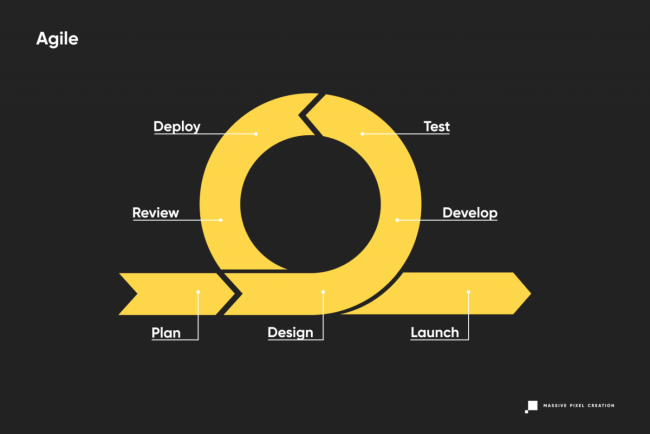
Agile Principles Explained: Definitions and Examples for Software Development
Agile was founded based on values and principles. It’s not a methodology or a philosophy to get things done but rather a framework, and a collection of beliefs teams use to make decisions. The Agile principles will help you guide your team on the right […]
BusinessAgile was founded based on values and principles. It’s not a methodology or a philosophy to get things done but rather a framework, and a collection of beliefs teams use to make decisions.
The Agile principles will help you guide your team on the right path, even when you’re unsure of your next step. In this article, we will explain the 12 Agile principles and how these help software teams adapt, optimize, and improve the development of software products or services.
What is Agile?

Agile refers to methodologies focused on iterative development where processes and solutions occur through continual collaboration among cross-functional teams.
Instead of following a well-defined and strict plan, Agile teams focus on continual improvement and efficiency. They work under “sprints,” which consist of specific tasks or deliverables boxed in a time frame. Each sprint typically lasts from two to four weeks, but this depends on the product in development. What’s worth noting is that sprints are not used in every single Agile approach. Kanban, for example, doesn’t use it.
In software development, Agile transformed entirely the way teams structured processes. Before Agile, software development life cycles like Waterfall focused on delivering software through a linear and rigid process.
With Agile, there’s no set of rules, procedures, or hierarchy that needs to be followed. The Agile software development life cycle (SDLC) focuses on breaking the process into manageable actions that can be continually improved until it reaches its primary goal. What matters is to deliver the best result possible.
A group of 17 engineers created Agile, focusing on building an efficient foundation to manage projects. However, since its inception, Agile has been more than a series of methodologies.
With 4 core values and 12 principles, Agile has become a globally accepted mindset for managing projects.
4 Agile Values
The Agile manifesto has 4 values and the 12 supporting principles that lead the Agile approach to software development.
1. Individuals and Interactions Over Processes and Tools
You can have high-tech tools and solid processes, but it’s the team that determines a project’s success. This value focuses on the importance of having teams with fluid communication who can respond to changes and customer needs. No matter if your team uses Slack, Microsoft Teams, or a virtual phone system, you simply must communicate clearly to work well.
2. Working Software Over Comprehensive Documentation
One of the reasons software development was slower and ineffective was due to all the technical specifications, requirements, documents, extensive planning, etc. Some Agile requirements are presented as a user story, which helps speed up the process. Documentation is still valuable, but working software is even more valuable in Agile.
3. Customer Collaboration Over Contract Negotiation
Agile aims to have customers engaged and who collaborate throughout the development process. Instead of having a negotiation period to outline all project details, it focuses on having a collaborative relationship from the start resulting in customers being heavily involved in the process. This makes it easy for Agile teams to quickly implement the customer’s feedback, understanding their needs and requirements.
4. Responding to Change Over Following a Plan
What characterizes Agile is that it embraces change. Instead of having a very strict and specific plan of development, the project should focus on delivering value. The definition of what value means for the project will vary, along with the project scope.
The 12 Agile Principles Explained

What are the 12 principles of Agile?
The 12 Agile Manifesto Principles are designed to help teams focus on what’s important, such as efficiently delivering valuable software, embracing change, working collaboratively, and prioritizing the customer’s needs, among other things.
These are the 12 principles of Agile explained:
1. “Our highest priority is to satisfy the customer through early and continuous delivery of valuable software.”
Understanding customers’ changing expectations is one of the priorities in Agile teams. Instead of having a linear structure, where they engage with customers only at the start and end of the project, Agile emphasizes the importance of having a continuous cycle of feedback and improvement.
Agile understands that a customer’s needs might change or evolve, so instead of focusing on a rigid plan, teams focus on a series of iterations followed by customer feedback. This way, it’s easier for the product to be aligned with customer expectations and allows the team to focus only on valuable features.
Example:
As this principle focuses on the continuous feedback cycle, Agile teams often build a minimum viable product (MVP), and its response informs future releases. Product teams can test and validate their ideas by using MVP and experimentations. Teams do not release a final product, but iterations continue to make improvements until the product has reached a certain level of satisfaction.
2. “Welcome changing requirements, even late in development. Agile processes harness change for the customer’s competitive advantage.”
One of the main characteristics of an Agile project is its adaptability. This second principle means that teams need to be willing to make changes to stay competitive even when the project is advanced.
Often, software teams think that the most reliable way to achieve a successful product is to make a solid plan and stick to it. But for Agile, it’s the other way around. Allowing change is necessary for teams to gain a competitive advantage.
Agile teams embrace change and are continually reconsidering their strategies and processes to ensure the quality of the product.
Adaptation and the willingness to change are part of Agile’s core strengths. Allowing change becomes necessary for teams to gain a competitive advantage.
A good way for strengthening your adaptation skills though may be taking part in agile project management training online. Especially, if you haven’t worked in the Agile methodology just yet. Learning directly from experts can particularly speed up the whole process.
Example:
Instead of prioritizing having well-documented plans, the Agile team focuses on observing the market, the customer needs, studying them in-depth, and being aware of the competitive threats they might face along the way.
3. “Deliver working software frequently, from a couple of weeks to a couple of months, with a preference to the shorter timescale.”
As mentioned, for Agile, the clients’ and stakeholders’ feedback is fundamental. Instead of waiting to build a final product to present it, Agile focuses on delivering work frequently.
This means that Agile teams work with “sprints” where tasks and goals are usually planned in the short term.
Sprints allow customers to see how the product is evolving and for the team to evaluate if there are improvements to be made. The idea is to achieve goals on smaller scales that will ultimately contribute to the product as a whole. Teams are aware of the specific goals they need to reach while adapting and changing the product until it fulfills the customer’s expectations.
Example:
Software development teams work in sprints with a set timeframe between 2 and 4 weeks.
4. “Business people and developers must work together daily throughout the project.”
The fourth Agile principle focuses on unifying departments, prioritizing collaboration regularly. The idea is that customers, key stakeholders, and leadership work hand in hand with developers, strengthening the communication channels to ensure everyone is on the same page.
During the development of a product, business and tech groups work together consistently, building trust and transparency throughout the process. It also helps give immediate feedback to developers making sure that new arising requirements and details for existing ones are taken into consideration.
While, for some teams who haven’t applied Agile, having everyone involved through all the stages might seem like it will cost more time, in the long term, it’s more beneficial because it optimizes processes. It helps teams recognize gaps between business and tech teams early enough to avoid future problems.
Transparency while delivering a product is crucial on both sides. Businesses should be aware of development status and blockers as much as developers need to be aware of all market/business or organizational restraints of the project.
Example:
Agile teams prioritize regular meetings. For instance, every day, they have a daily meeting that takes only 15 minutes, and each member of the group shares what they are currently working on and if they have had any roadblocks.
5. “Build projects around motivated individuals. Give them the environment and support they need, and trust them to get the job done.”
Usually, at the start of the project, where the planning and first steps take place, the team is motivated and ready to get started. However, it is harder for individuals to stay motivated and focused on the final goal when problems arise.
Agile principle 5 emphasizes the importance of choosing the right people with the right skills and roles to be part of the project to achieve success. And it also encourages team leaders to give them the necessary tools and resources.
Motivating team members is also about listening to their ideas and showing that it’s important. Giving team members the confidence to speak up is also a way to help them improve their performance.
This principle also focuses on trust, which translates into avoiding micromanagement. A key aspect of the Agile framework is to empower team members through trust and autonomy.
Example:
Team leaders need to ensure that developers understand strategy and requirements before development starts. Not necessarily focusing on how something will be built, but more on the “what” and “why”. The delivery team is who determines the “how” through the process.
The goal is to provide support when roadblocks appear and brainstorm on possible solutions through the sprints, not micromanaging.
6. “The most efficient and effective method of conveying information to and within a development team is face-to-face conversation.”
The sixth Agile principle translates primarily into two things: Communication and collaboration. The most effective way for teams to be on the same page is to communicate continually.
While this principle focuses on the face-to-face aspects, something to keep in mind is that it was written two decades ago, when Zoom and other remote tools weren’t part of the panorama.
In today’s world, applying this principle is not for face-to-face exclusively, but it highlights the importance of meaningful connections and conversations. While email and texting are fast and easier alternatives, video calls, and even regular phone calls are the best channels for remote teams to communicate effectively.
Example:
This principle is applied in software teams through daily meetings, brainstorming sessions, sprint planning meetings, frequent demos, and pair programming.
7. “Working software is the primary measure of progress.”
To understand this principle, let’s rewind to pre-Agile times to understand how teams used to measure success.
As mentioned, in many cases, software development was a hierarchical and linear process. This meant that teams, instead of working through iterations, left most of the testing and refactoring to the final stage. In the end, this left unhappy customers and many problems to review and improve, and that took time.
Agile focuses on maintaining a working software, measuring the progress of what has been completed. Each feature and addition is reviewed by the tech team and the client. So when it’s time to work on the next steps, the client is happy, and revisions and testing have already taken place.
Working software is not the final product, but it refers to each iteration. Agile teams work on Minimum Viable Features. That way, they measure success by delivering a working product that satisfies customers.
Example:
Software teams design and release Minimum Viable Features instead of fully-fledged features to get feedback and validate the product while building software. This makes agile teams have the capacity to adapt to change and gain a competitive advantage, as explained in the previous principles.
8. “Agile processes promote sustainable development. The sponsors, developers, and users should be able to maintain a constant pace indefinitely.”
The key concept in this principle is “sustainable development.” What Agile means by this is that project managers and leaders should set realistic and clear expectations, even if that means that a project will take longer than expected.
In some cases, software development teams set high expectations trying to fulfill all requirements in a short period. And the problem is that putting in extra time to meet deadlines quickly burns out the team, impacting the quality of the outcome, morale, and motivation.
The idea is to strengthen morale by encouraging a healthy work-life balance with realistic goals. It’s not about finishing projects fast, but about making them at a constant rate.
Example:
Before every sprint takes place, teams need to consider the amount of work they can commit to. Instead of overpromising and not fulfilling expectations, teams should set realistic goals without adding more tasks through the process. Once a sprint starts, teams stick to the goals and tasks they have already established.
9. “Continuous attention to technical excellence and good design enhances agility.”
This principle focuses on constantly reviewing the product after every iteration. Agile promotes continuous attention to technical excellence and good quality design.
The purpose of this principle is to encourage teams to avoid shortcuts just because they want to finish a project faster. Most of the time, shortcuts become more costly in the long run.
Example:
Developers and the product management team work hand in hand to understand if the technical debt is acceptable. Usually, they will need to allocate development resources to refactoring efforts.
10. “Simplicity—the art of maximizing the amount of work not done—is essential.”
This Agile principle focuses on keeping processes as simple as possible. In other words, it talks about working smart, not hard.
Agile teams recognize what adds value to a project and what doesn’t, which enables them to maximize the resources that best serve their project. Too many features and planning are avoided at all costs. The idea is to avoid distractions and streamline the cycle to make it more efficient.
For Agile, simplifying and focusing on the things that truly matter is what has the most impact. In a product management context, leaders should always be focused on prioritizing, even if that means making difficult decisions.
Example:
Product managers are strongly aligned with organizational goals, and the customer wants and needs. This makes them selective in the user stories and features they pick. With prioritization techniques, they ensure that the strategies they implement always have a purpose and a “why” behind them.
11. “The best architectures, requirements, and designs emerge from self-organizing teams.”
Self-organizing teams are made up of a committed and motivated group able to plan, estimate and complete the work autonomously while engaging with the customers. This also breaks down the traditional vertical management style.
This Agile principle focuses on self-organizing teams that work under a more flat and horizontal management style. This translates into autonomous teams capable of acting faster, as they don’t need permission for every decision they make.
Example:
In practice, Agile teams are autonomous groups in an organization that have full control over their projects and take ownership in such areas.
12. “At regular intervals, the team reflects on how to become more effective, then tunes and adjusts its behavior accordingly.”
This last Agile principle encourages leaders to take time to evaluate what the team has done, how they’ve performed, and how they can improve.
Agile focuses on delivering products through continual improvement, always considering feedback. Similar to this process, teams need to frequently evaluate their process and see ways to make it more efficient.
Example:
The idea behind this principle is to have sessions where the team reflects on their performance and discuss ways management and technical skills can be improved.
Key Takeaways
Agile Principles focus on providing guidelines to ensure teams focus on the right things. These are the 12 Agile Principles, explained in simpler terms:
1. Customer satisfaction through early and continuous delivery of software.
2. Focus on working on smaller and achievable tasks.
3. Adhere to a timeframe for the delivery of a working product.
4. Stakeholders need to frequently collaborate throughout the entire development process to ensure the project moves in the right direction.
5. Create a supportive environment that motivates team members.
6. Constant communication is key to a project’s success.
7. Progress is measured by working software.
8. Maintain a constant and realistic pace of development.
9. Always keep an eye out for technical details.
10. Simplicity is key.
11. Promote self-organization.
12. Reflect on the team’s performance to continue improving.
Conclusion
Thousands of organizations across the world claim to be Agile. However, as explained in the article, Agile is not a methodology or a philosophy; it is a framework.
Understanding the values and the principles of Agile provides teams with a foundation to make the right decisions, create quality software, and solid cross-functional teams.

Web App vs Mobile App: Which One to Invest in?
In fact, it’s projected that in 2022 the mobile app revenue worldwide will reach $808.7 billion, and in 2023 it’ll reach the astonishing number of $935.2 billion. Compared to 2014, the revenue difference would be $837.5 billion. Quite impressive, isn’t it? There’s also a wide choice […]
BusinessIn fact, it’s projected that in 2022 the mobile app revenue worldwide will reach $808.7 billion, and in 2023 it’ll reach the astonishing number of $935.2 billion. Compared to 2014, the revenue difference would be $837.5 billion. Quite impressive, isn’t it?
There’s also a wide choice of available options when it comes to the development of web or mobile applications. What’s the difference though? Do they actually differ, even if they look the same? In this article, we’ll cover all sorts of information about web apps, mobile apps, and how they’re built. What’s more, we’ll try to resolve the web app vs mobile app clash once and for all!
Web App and Mobile App – What’s the Difference?

Have you ever been confused about what a web app and a mobile app are? After all, they look very similar, right? The devil is in the details, so to speak.
Web apps and mobile apps, although they share some similarities to each other, they’re two different types of applications. At first glance, you may notice very few differences between the two as they almost look entirely the same. Design, custom logos, color scheme, functions, icons, they’re probably placed in the same spots. To bring these components to life, the use of cutting-edge AI tools can be of great assistance.
But don’t let this fool you, these two applications are even made differently. One classifies as a web application, and the other is a native mobile app.
The core difference is that native mobile apps are dedicated applications for specific mobile platforms, i.e. Android or iOS, whereas web apps can be accessed through different internet browsers on a computer or on a mobile device.
A great example of how a native app looks compared to a web application would be Uber Eats. You can access it through your mobile device by downloading an application or by accessing the website through your phone’s browser. They will look similar but will be different.
One more noticeable difference between a mobile and a web application would be the ability of native mobile apps to work offline, to a limited extent of course.
Native apps are built from scratch for the mentioned platforms. Users can download them through either App Store or Google Play. That fact alone increases the safety of the app. They require updates that can be done manually or automatically, depending on your preferences. That’s not the case with web apps though, as they are updated by the creators, whenever an update is ready, and it doesn’t take as much time as for the mobile apps.
Coming back to native apps, if you’d like to release an application with paid services for – let’s say – iOS, you’d have to pay a large fee to Apple for every made transaction.
Planning
Before proceeding to the actual building process, it’d be wise to plan your strategy ahead. What we mean is that you could follow one of the software development lifecycle models that would make the development and entire process easier and less complicated, as you would have every step planned and written down.
What’s more, think about your team, what roles would you need for your project. Two roles that you’d definitely need would be a web developer and web designer.
Building Process
Mobile apps are a much faster solution than a typical web application when it comes to performance. Let’s focus on the latter for now. What differentiates a native app from a web app besides the platform? Well, a number of functionalities or time spent on the creation. Your typical programming language or syntaxes for web apps would be either JavaScript, HTML, or CSS. With the help of CMS (like WordPress, Drupal, or Umbraco), devs can build them at a much faster rate.
Things are a little bit different for mobile apps. With more functionalities, native apps have to be developed in a specific programming language with the help of IDE – Integrated Development Environments (though IDEs are not limited to native apps). Additionally, the chosen programming language depends on the target device. For example, if you want to create an application for iOS, you would have to use Swift or Objective-C language. The same situation happens for IDE, as the default for creating apps for iOS would be Xcode. On the contrary to web apps, native mobile apps can be created with SDK – software development kits that are provided by Google and Apple. They can make the mobile app development much better and easier.
How about devices that run on Android? Well, in this case, you’d probably use Java or Kotlin programming languages along with Eclipse IDE or Android Studio software development kits.
There’s also HarmonyOS that’s worth mentioning but it’s much less popular than iOS or Android. So what languages would you use for creating Harmony apps for Huawei? The answer is either C, C++, Java, JavaScript, or Kotlin.
What should you do in a situation where you want to release the native app on multiple platforms? In this particular case, the best solution would be to use one of the cross-platform languages, like Flutter. By doing so you can develop a hybrid app that will land on every mobile platform.
To do so, you can use either React Native, Xamarin, or Cordova.
Pros and Cons of Native Mobile Apps
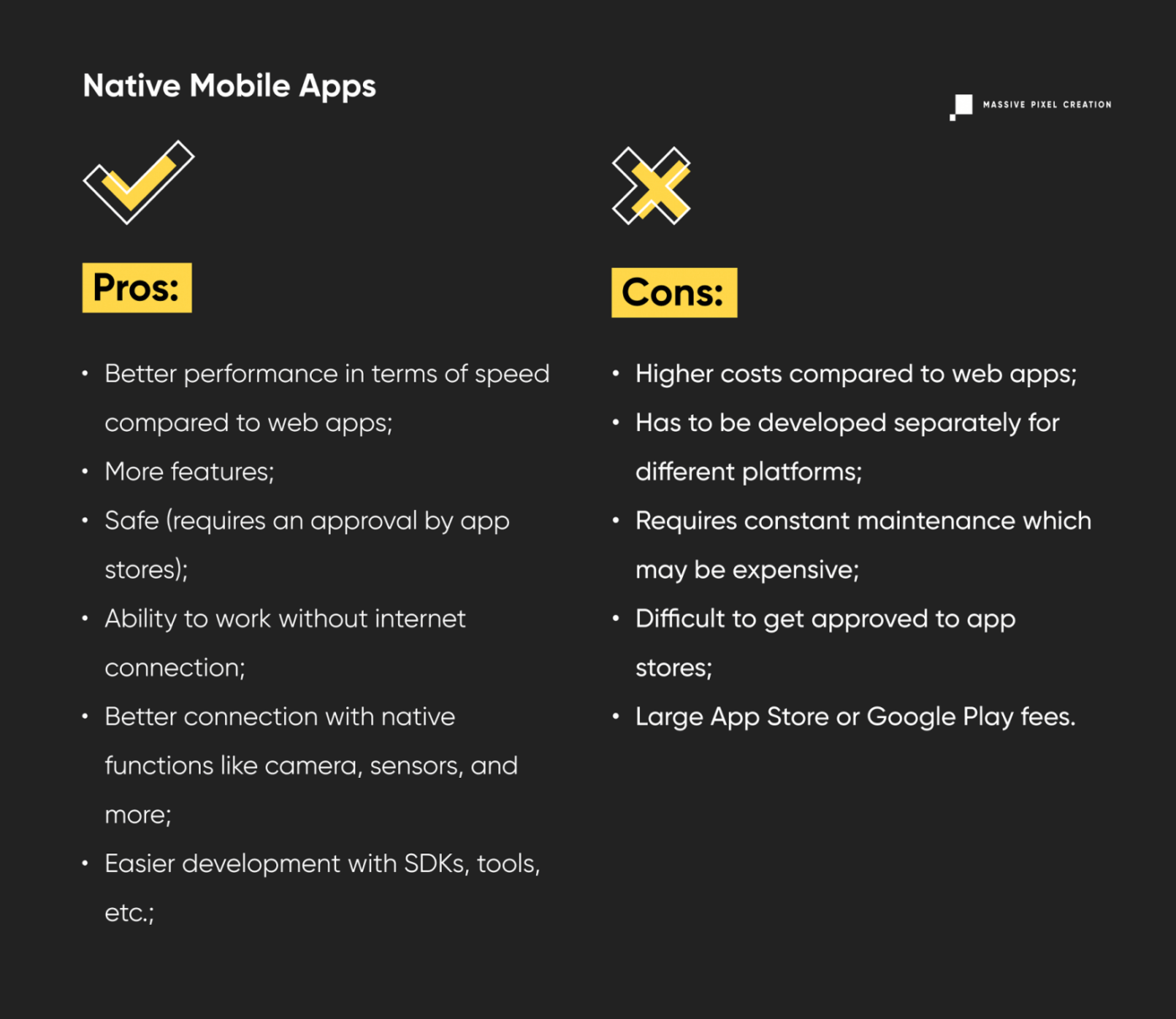
Examples of native apps: Spotify, Pokemon Go, WhatsApp
Pros and Cons of Web Apps

Examples of web apps: LinkedIn, Yahoo.
There’s a common ground though, and it’s called progressive web apps. Is it a good solution? Let’s find out.
Progressive Web Apps
A progressive web app (PWA) is a web application that combines features of both native mobile apps and web apps. What exactly? For starters, the ability of mobile apps to work offline. Even though it’s still a web application, it features something called Application Cache that allows it to work without an internet connection. Similar to web apps, they cannot be downloaded but accessed through an internet browser. Though they still can be added to the home screen.
Many programmers additionally use web frameworks like Angular or React to help them build their applications.
PWAs philosophy is based on three core pillars, they have to be:
- Capable;
- Reliable;
- Installable.
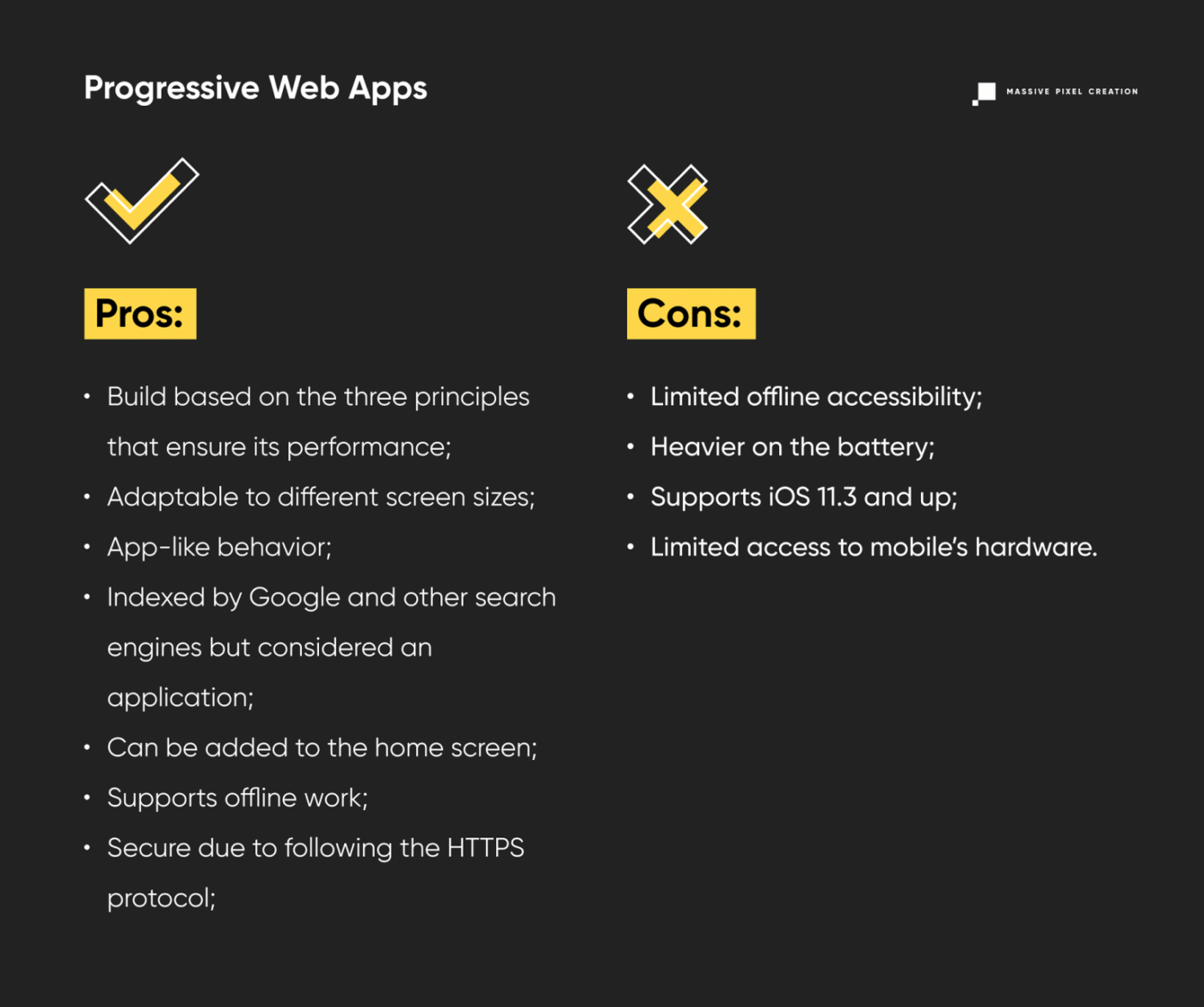
Examples of PWAs: Starbucks, Trivago, The Washington Post.
Hybrid Apps
Hybrid mobile apps may seem similar to PWAs, but they’re definitely not the same. Hybrid apps are a mix of both native and web apps, but they can be downloaded from the app store on either Android or iOS.
It’s a great option for those who wish to try out their idea before investing a lot of money. By developing the MVP release, you can see how your app is doing, take suggestions or release fixes.
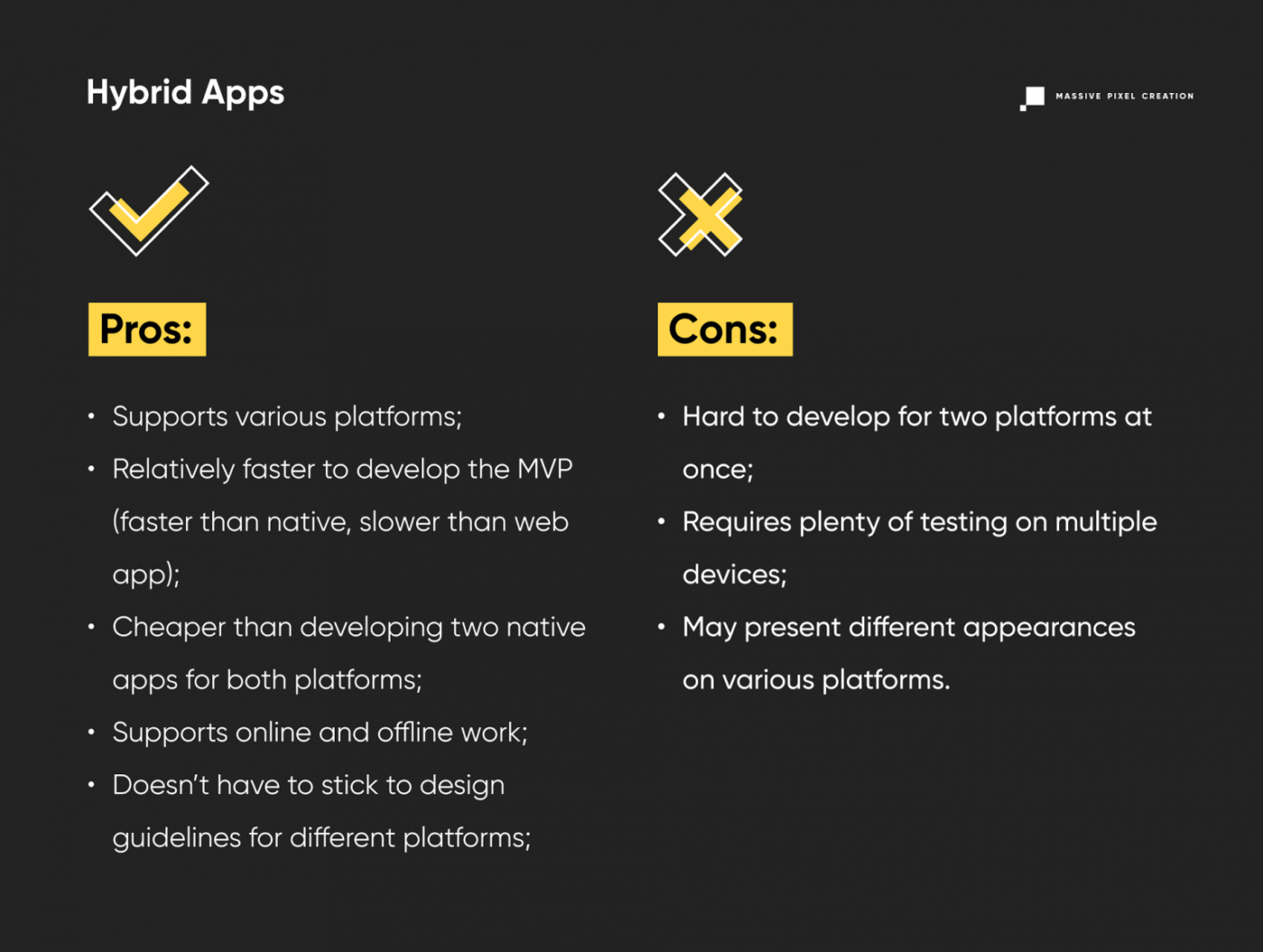
Examples of hybrid apps: Instagram, Gmail, Twitter.
The Dilemma
Are you perhaps stuck on deciding whether it’s better to create a web app, PWA, or a mobile app? Check out these facts that may help you make the choice!
As we mentioned before in this article, the number of mobile users grows year by year, month after month, and day by day. In fact, there are more mobile phone users than ones using desktops.
But what factors should you take into consideration when choosing one of the two options?
Costs
If you’d like to start with a mobile app then you better have your wallet at hand. Developing a mobile app instead of a web app requires a higher budget. Additionally, if you’d like to release the application on iOS and Android simultaneously, that will cost extra, both in terms of money and time.
Bottom line is that developing a website application or PWA first is a cheaper option (that of course depends on your idea and goal).
Speed
When it comes to speed, web applications lose (though the difference is minimal). Even though PWAs are still faster than web apps, native apps win the race because they’re launched directly from your device.
There’s a downside to it though. In order to access the mobile app, you have to download it first, whereas to access a website app you only need to type in the address and wait for it to load. For PWAs you don’t even have to launch your browser (with the exception of the first time). You can pin the shortcut to your home screen and access it from there.
Another advantage in favor of a mobile app is the ability to work offline, though probably with limited functions.
Accessibility
A well-written website application should work just fine on every platform, whether it’s Windows, Linux, macOS, Android, or iOS. On the other hand, even a well-written native app can work only on one platform. If you’d like it to work on a different one, you’d have to develop a new code from scratch. Definitely a downside of mobile apps.
User Preferences
Since the start of the SARS-CoV-2 pandemic, our lives have changed drastically. Many of us had to give up on social interactions for the time being. Plenty of employees have been sent to work from home and it’s not the only thing that has changed.
People started using their smartphones or mobile devices even more than they used to. The actual amount of hours spent on mobile apps by an average person is 4.2 hours daily which is a 30% increase compared to 2019. That’s more than half of a typical day of work.
The reason for bringing this up is that the web itself is less browsed by the users, but applications are on the top right now.
Visibility in Search Engines
Unlike mobile apps, web apps can be easily found on the internet due to the fact that they can be indexed by search engines. In order to have your app rank high when it comes to downloads and ratings, take proper screenshots showcasing the design and functionalities of your app. Without such actions, it would be much harder to find the application in the app store, compared to the website.
What’s your Target Audience?
Before allocating your budget to either mobile or web applications, think about your target audience. Do you want to develop a business web application for your company? Or perhaps you wish to create a social media platform that could potentially gather people with similar interests? Or maybe you want to start a pet store and develop an e-commerce website for it?
If the former is the case, then creating a web application would be a wiser choice. If your idea is more like the latter, then only the sky’s the limit.
The Verdict
It’s time to summarize all the things we learned about native, web, hybrid, and progressive web apps so far.
As we mentioned before, your go-to app should be chosen based on your idea and target.
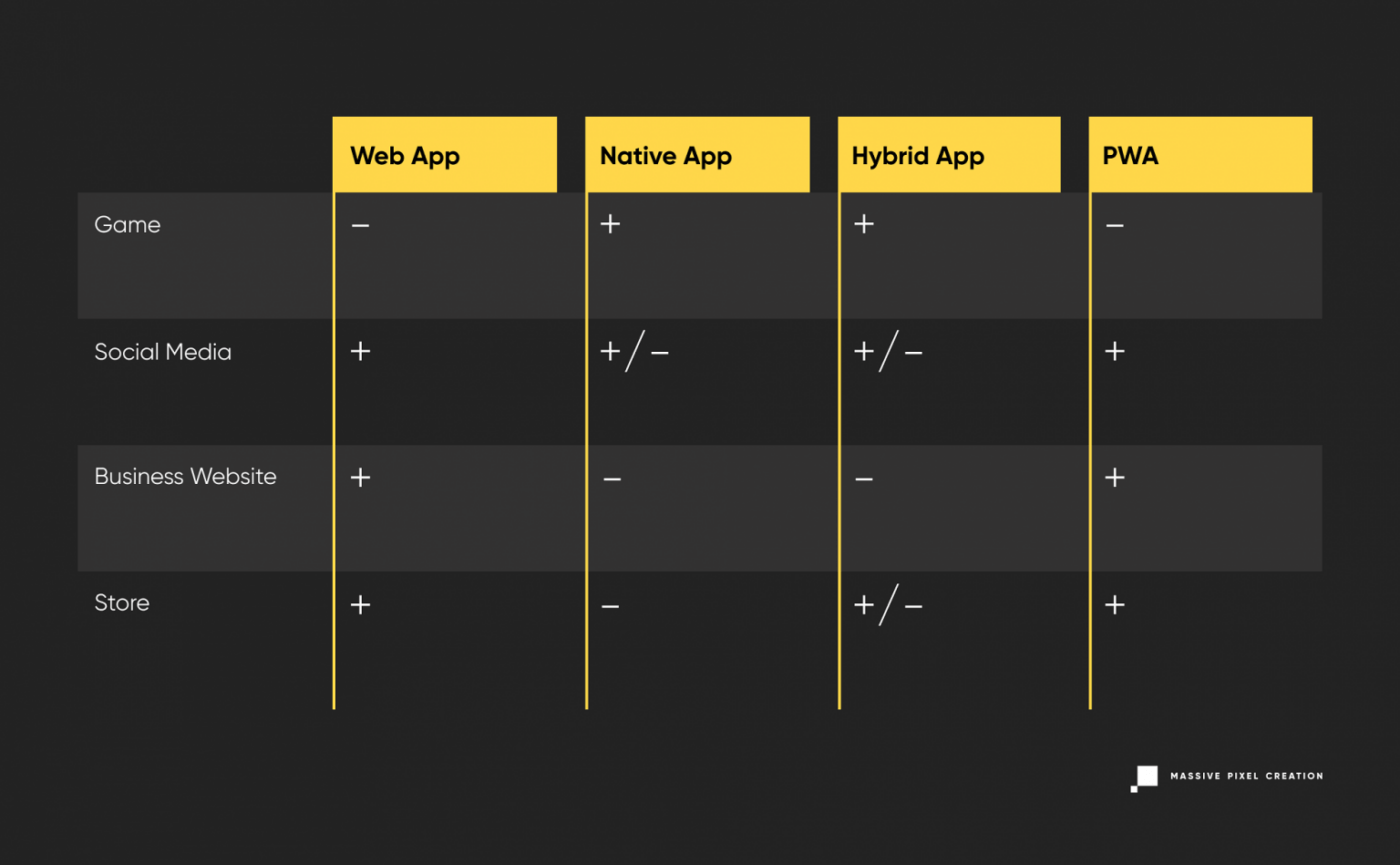
Real-Life Stories
Starbucks
Everyone heard about Starbucks. It’s one of the most popular coffee shops in the world. Let’s jump right into the time machine and head back to the year 2009.
You can hear Flo Rida’s or Pitbull’s songs all around, David Guetta is just becoming popular, and Starbucks just released their myStarbucks app. It lets the users find coffee shops in their proximity, learn about different coffee types, and more.
That was just the beginning of Starbucks’ online presence. In 2011, Starbucks released a loyalty program aimed at people who use the Card Mobile app. That move enabled users to make payments through their phones. In the following year 2012, Starbucks integrated their native app with Square and Apple passbook, the former is a payment system for mobile devices, and the latter is a place where you can keep your loyalty card information.
That’s still not everything. In 2017, Starbucks decided that it was time for a change. With new app ideas, the company released a PWA with everything that the user needs, like images, animations, and of course, offline accessibility. Customers could finally learn about the offered products, and their nutritional values, and could customize their orders, all done without internet access.
It turned out to be a huge success, as Starbucks doubled its daily active users. Moreover, compared to the huge and heavy iOS app (148MB), their PWA only weighs 233kB.
Everyone either has an account on Instagram or knows someone that does. It’s one of the biggest success stories regarding mobile apps. The picture-sharing platform gained a massive number of 100,000 users. To make matters more interesting, it even happened in the first week of its initial launch.
Released in 2010, Instagram continues to be one of the most popular social media platforms. Nothing speaks of success more than money, after all, Instagram was bought by Facebook in 2012, for approximately $1,000,000,000. Just wow.
From the companies’ point of view, now they can post to Instagram from a desktop for better quality and share engaging content to attract new audiences and interact with existing customers.
Pinterest is yet another success story of a low-performing website turned PWA. The company wasn’t doing very well. They had a slow-performing website with not as many views, and a poor conversion rate of 1%.
Even though Pinterest already had iOS and Android apps, they still couldn’t manage to get the wanted results. That’s when the idea of a progressive web app started to form.
Pinterest just hit a jackpot! Their core metrics increased, and users spent 40% more of their time on the app compared to the website. Even better, the company noted a 44% increase in revenue coming from the ads, as well as a 60% increase in user engagement.
After all, their PWA only weighs 150kB.
Trivago
The Trivago situation is a little bit different. They didn’t suffer from low numbers of views or lack of interest. Quite the opposite, actually. They were getting more and more visits from mobile users and it was time to think about the future.
Creating a native mobile app from scratch seemed like an expensive and problematic idea. The question of whether people will actually download the app has been one of the issues. Another one was the noticeable connection problems among the mobile visitors. These facts forced Trivago to rethink the idea.
Since native apps are out of the question, the company decided to place its bet on a progressive web application. The number of advantages like browser accessibility, push notifications, offline access, or the ability to add a shortcut to your home screen, had solidified the idea.
Was it a good idea? Did they succeed? They definitely did! Up to 2019, Trivago has been added to the home screen more than 500,000 times! Available in 55 countries and in 33 languages, the company’s user engagement increased by 150%. And that’s not all. Their repeated visits increased from 0.8% to 2%, and the push notifications contributed to increasing the conversion by 97%.
Key Takeaways
I promise, we’re almost here, but before we head to conclusions, let’s summarize what we’ve learned so far:
- Web applications can be accessed through the internet browser and are good for business websites, social media, etc.;
- Progressive web apps can be accessed through both the browser and the home screen, and they’re great for social media, news, and more;
- Hybrid apps can serve as a great starting point for testing the MVPs;
- Native apps are ideal for mobile games and other applications that require high performance and high usage of device’s components.
Conclusions
And here we are! We went through quite a lot of information here, starting from the difference between a mobile app and a web app, through planning, building, properties, and pros and cons of PWAs, hybrid, native, and web apps, to the dilemma, verdict, and some real-life success stories.
After reading this article you should be able to tell the difference between all those apps and decide which one would suit you and your business best.

Best Web Development Blogs To Follow Right Now [2022]
With this list of 10 best web development blogs, with a treat of best YouTube channels and podcasts, you’ll be able to stay up to date with the latest web standards on all fronts — front end, back end, as well as UX/UI design, and every […]
BusinessWith this list of 10 best web development blogs, with a treat of best YouTube channels and podcasts, you’ll be able to stay up to date with the latest web standards on all fronts — front end, back end, as well as UX/UI design, and every other branch pertaining to the web development services.
Your experience doesn’t matter; if you’re a code newbie looking for new skills or you’re a veteran in the coding world looking for latest news, new standards or solutions to unconventional problems, this list is still for you. And even if you’re neither, and you simply want to discover all the things web development is about, stay on this page and read on!
Top 9 blogs for web developers.
1. A List Apart

Main Topics: Code, Content, Design, Industry & Business, Process, User Experience
Audience: Front end Developers, Project Managers, UX/UI Designers, Graphic Designers, Content Creators
A List Apart is a webzine that’s been active for 23 years now, with a focus on web design and development, web content and its meaning, best practices and standards of modern web. Most of the content consists of opinion articles, ranging from future trends to environmental impact of IT and career advice. That’s why this site is wonderful for people who are not involved directly with web development — they can prepare themselves for better teamwork, understand common practices and be able to spot frauds during recruitment.
The articles are of the highest quality. They do invite writers to submit their pieces, but they’re all diligently checked over, reviewed, and edited. It’s not easy to submit a guest post, but they promise that it’s very rewarding. So you can expect to find articles from other IT professionals, keen on sharing their coding expertise.
A List Apart doesn’t stop at blogging. They also organise An Event Apart, a conference in San Francisco (which you can also join online) that’s known for being informative, educational, as well as inspirational. For some, it’s an event you can’t miss, especially since the invited speakers are well–known industry leaders.
And if you’re looking for knowledge condensed in one place, check out their book: A Book Apart, for those who design, write, and code.
2. Codrops

Main Topics: Tutorials, Resources, Code, Design, User Experience
Audience: Front end Developers, UX/UI Designers
Codrops is a fantastic source for front end developers, full of inspiration, useful tutorials, free resources that we all love, and articles with practical advice.
Their tutorials are long and comprehensive, and easy to follow through. They have plenty of embedded images, experimental videos, and lines of code shown in action. So if you want to learn fancy tricks, from creating infinite circular galleries to kinetic typography and glitch effects, this is your go–to site. Just like when you need inspiration: Codrops regularly posts Inspirational Websites Roundup, UI Interactions & Animations Roundup, and many others to spark your creativity.
If you’re not experienced enough to jump straight into tutorials and want to start with the CSS basics, there’s a CSS Reference library with the most important properties and information for you. All for free!
And if you want to know what’s happening in the tech world, check out their Collective, bundles of posts highlighting the latest news and resources.
For non–coding people, it’s a good site to see what can be done, and what the possibilities are.
3. CSS Author

Main Topics: Resources, Design, Content, User Experience
Audience: Front end Developers, UX/UI Designers, Graphic Designers, Content Creators
CSS Author is a front end coding blog that’s a goldmine of resources for web developers and web designers alike, with occasional publications useful for graphic designers and content writers as well. It has a staggering amount of “freebies”: you can find mockups, icons, and templates for WordPress and CMS, such as Magento or Drupal, etc. They’re all available for personal and commercial use.
This site acts as a good place to find free libraries, plugins, bootstraps, and tools for developers working with HTML, CSS, Java Script, jQuery, PHP.
4. CSS–Tricks

Main Topics: Tutorials, Resources, Code, User Experience
Audience: Front end Developers, UX/UI Designers
CSS–Tricks is a site you can count on to be constantly posting, sometimes even several times a day. They focus on CSS, HTML, and Java Script in the form of tutorials, guides, tricks, and articles. They range from animation, typography, accessibility, web performance, serverless, and many more. And if you’d rather watch a video than read — there’s more than 200 video posts to choose from.
When it comes to resources, there’s an Almanac with CSS Selectors and CSS Properties with lots of examples and demos. If you’d like some concrete knowledge in one place, the author of the site, Chris Coyier, has two books that are available to MVP Supporters.
5. David Walsh

Main Topics: Tips and Guides, Code, Mobile Development, User Experience
Audience: Full–Stack Developers, UX/UI Designers, Content Creators
David Walsh is a personal blog, run by a professional senior full stack engineer
working for MetaMask, who also used to work for Mozilla for eight years. So you can be sure that the guy knows what he’s talking about.
Besides tips and guides mostly on JavaScript (React, Node.js, jQuery), HTML5, CSS3, you can also find sneak peeks into a life in a web development industry, some career advice, and even interviews with other experienced developers. He’s a firm believer that practice triumphs over theory, and that experiments are a worthy pursuit. This approach has resulted in almost 83,000 followers on Twitter.
If you want to discover what a successful web developer needs to make an impact, following David’s blog is a good choice. Especially since new articles just keep on coming, even though the blog has been up for more than a decade.
There’s also some advice on technical SEO, so Content Creators should definitely take a closer look.
6. Dev.to

Main Topics: Tutorials, Code, Graphic Design, Content, User Experience, Industry & Business, Career Advice
Audience: Full–Stack Developers, UX/UI Designers, Graphic Designers, Content Creators, Project Managers
Dev.to isn’t really a blog and more of a community of software developers, but we couldn’t not mention it.
On the contrary to all the previous blogs, anyone can contribute to dev.to. All the posts published on the feed are tagged for easier navigation, and it’s easy to notice the popularity of Java Script, React.Js, Python, CSS, HTML, Node.js, PHP, Vue.js, and Ruby. There’s also a lot of content for beginners, as well as posts centered around career, testing, machine learning, and security, among others.
If you like podcasts, dev.to has hundreds of them, along with videos in the form of practical tutorials, guides, tips, and useful tricks. You can also find full blog posts that are often cross shared in places like Medium or Hacker Noon. And if you have trouble understanding a concept, you can ask the community to explain it to you “like you’re five years old”. It works wonders and is great even for non–tech people.
7. Joel on Software

Main Topics: Software Development, Project Management, Industry & Business, Career Advice
Audience: Software developers, Tech Leads, Project Managers, Recruiters, CEOs, Startup Founders
Joel on Software is another personal blog of an accomplished software engineer, Joel Spolsky, a creator of the project management software Trello and a Stack Exchange network. He shares his perspective not only on software development itself, but also on business, project management, recruitment, and getting started in the tech field, served with practical advice on career.
When it comes to the blog, which has been online for over a decade, it has more than 1000 useful articles. Anyone can find valuable content for themselves, from developers and tech leads to project managers, CEOs, and recruiters. Part of that knowledge has been captured into five books, available on Amazon.
8. SitePoint

Main Topics: Code, Web Application Development, Graphic Design, User Experience, Industry
Audience: Full–Stack Developers, UI/UX Designers, Entrepreneurs
SitePoint is bursting with books, online courses, and tech talks on topics of Java Script, HTML, CSS, PHP, Python, WordPress, Design & UX, App Development. The library is curated by the experts in web design and web development, so you can trust their input.
This web development blog focuses on a much wider range of subjects. You can learn more about the next wave of web technologies, such as Deno, Eleventy, Gatsby, Rust, WebAssembly, and many others. Reading the blog also ensures that you’re staying up to date with the future of the web and the state of the technology industry.
Not only web developers will benefit from paying attention to this blog, but designers as well. If you want to master Adobe XD, Figma or Sketch, along with any other similar programs, check out their materials. And even those that only want to polish their skills with Notion, Airtable, Obsidian, and other productivity tools, should also take a look.
It’s also a good place for people looking for a web development job or who want to advance their already prospering career. You can find articles full of advice for juniors and seniors alike, along with current job listings for remote positions.
And lastly, if you have questions that are still left unanswered after perusing the blog’s content, you can easily ask the community.
9. Smashing Magazine

Main Topics: Code, Mobile App Development, User Experience, Graphic Design
Audience: Full–Stack Developers, Mobile Developers, UX/UI Designers, Graphic Designers
Smashing Magazine is an online magazine of the highest quality, geared towards professional web designers and developers, offering them practical and useful content to improve their skills.
Their goal is to support the virtual community of the coding world with news on the latest web technologies, from app development, responsive web design to accessibility and usability, among many others.
New articles are published several times a week on a wide variety of topics, to keep front end developers, designers, animators, and illustrators more than satisfied. And of course, you can find articles to keep up with the latest trends and opinion articles as food for thought, along with productivity tips
Besides the articles, you can also jump right into guides, books, and online workshops. Not all of them are for free — to access them, you need to buy a membership. There are three levels: for $3, $5 and $9 a month or $30, $50 and $90 a year.
Don’t forget to check out this site’s podcasts. “The Smashing Podcast” runs around 1 hour each, so be prepared to gain a lot of new insight.
Smashing Magazine also takes care to post current job openings and present–day conferences.
Searching For Knowledge Beyond Blogs
Nowadays, blogging sites are not the only source of knowledge that’s worthy of our notice. Several times we’ve mentioned videos and podcasts, that’s why it would have been remiss of us not to list our favourites.
Youtube Channels
freeCodeCamp
FreeCodeCamp is a non–profit organization, supported by donors, with a mission to help people become developers for free. Besides a youtube channel, they run their own site with even more resources, and they also organize study group sessions around the world. They even offer certifications to give you an easier start in the industry.
FreeCodeCamp is perfect for self–learners. You can find there long and comprehensive courses for beginners on Python, SQL, Java Script, C++, C, Penetration Testing, HTML, Data Structure, React, HTML5, CSS3, Django, PHP, APIs, Laravel, and many more. Some of them even last for 15 hours.
TraversyMedia
Traversy Media is perfect for people who already know some basics and wish to learn something new in a quick manner without delving too deeply into each concept. Offered courses last from 20 minutes to 2 hours, with the more comprehensive ones available on Udemy. HTML, CSS, JavaScript, React, Async.js, Laravel, Rust, Ruby, Ruby on Rails, and many more — they’re all waiting to be learned and mastered while building projects from scratch.
The Net Ninja
If you prefer your courses divided into small, digestible parts, look up The Net Ninja. It’s perfect for beginners who want to learn bits and pieces on the run or in between other tasks. The overall tone is light and fun, due to the enthusiastic nature of the host, who is also very thorough and methodical in his approach.
You can choose what to learn next from over 1000 tutorials, that delve into Java Script, Firebase, Flutter, HTML & CSS, Laravel, MongoDB, Node.js, PHP, React, Vue.js, and many more. You can find both beginner and advanced material, so better keep a close eye on this channel.
Fireship
If you’re even more pressed for time, look up Fireship, a channel created by Jeff Delaney on the topic of building web applications of highest quality fast. His longest series is called “100 Seconds of Code”, which is straight to the point while being very informative. It’s perfect for those who want to grasp various concepts quickly before delving into them, or for those who simply want a reminder.
Besides that, you can find out more about development tools, pro tips, productivity tips, 15–25 minutes beginner guides, both for front end and back end, from Java Script to API and cloud infrastructure.
Coding Tech
If you’d like to take a step back from tutorials and to find out what’s happening during tech conferences without attending any, go to Coding Tech. They partner with many different conferences around the world and have their explicit permission to publish videos on youtube. Among their partners are ConFoo, JavaScriptLA, Pixels Camp, PyData, React Amsterdam, You Gotta Love Frontend, and many others. So if you want to stay on top of trends in the tech world, gain some valuable career tips while developing your hard and soft skills, subscribe without further delay.
Podcasts
JavaScript Talks / Conferences as Podcasts
JavaScript Talks was created with accessibility in mind. To bring conferences to those, who cannot attend them themselves, who can’t watch the videos due to visual impairment, or who simply don’t have the time to sit down and press play. It’s also a solution to those who lack a proper internet connection for one reason or another.
Thanks to this initiative, many people around the world can get access to Java Script conference talks, discover what’s new and, of course, to learn.
JS Party: JavaScript, CSS, Web Development
JS Party is a weekly podcast with a heavy focus on Java Script, but including as well Go, Ruby, Python, Node.js, and others. Besides talking about all things code, they also have episodes on developer’s culture, startups, sustainability, web development tools, and many others.
This podcast is well known for being informative (each episode lasts for an hour), yet at the same time, entertaining. With lots of banter involved.
React Talks
Interested in React? Then React Talks are perfect for you, with over 100 episodes, 1 hour long each. Every episode has a new guest invited to share their experience and expertise with React, from starting their career to leading some exciting projects to analyzing the newest and upcoming trends. If you like hearing stories concerning the web development world, listen to this one.
Syntax — Tasty Web Development Treats
Syntax is a podcast created by Full–Stack Developers Wes Bos and Scott Tolinski. It’s updated several times a month and each episode tends to last anywhere from 20 to 60 minutes. It’s well known for being fun, knowledgeable, and suited for both beginners and more experienced developers, improving their soft and hard skills.
Besides talking about their own experience as developers and dishing out career and portfolio tips, they explain Java Script and its frameworks, additionally venturing into HTML, CSS, Deno, development tools, freelancing, and many more.
Web Rush
Web Rush is another weekly JavaScript–centric podcast, run by John Papa, Ward Bell, Craig Shoemaker, and Dan Wahlin. They invite guests to share their stories of web development, challenges they’ve faced and the solutions they came up with. It’s full of practical advice and hands–on approach, making people excited to experiment on their own.
So if you’re curious about Google Maps behind the scenes, developing apps and themes for Shopify, or how to get started as a developer, check out this podcast.
Key Takeaways
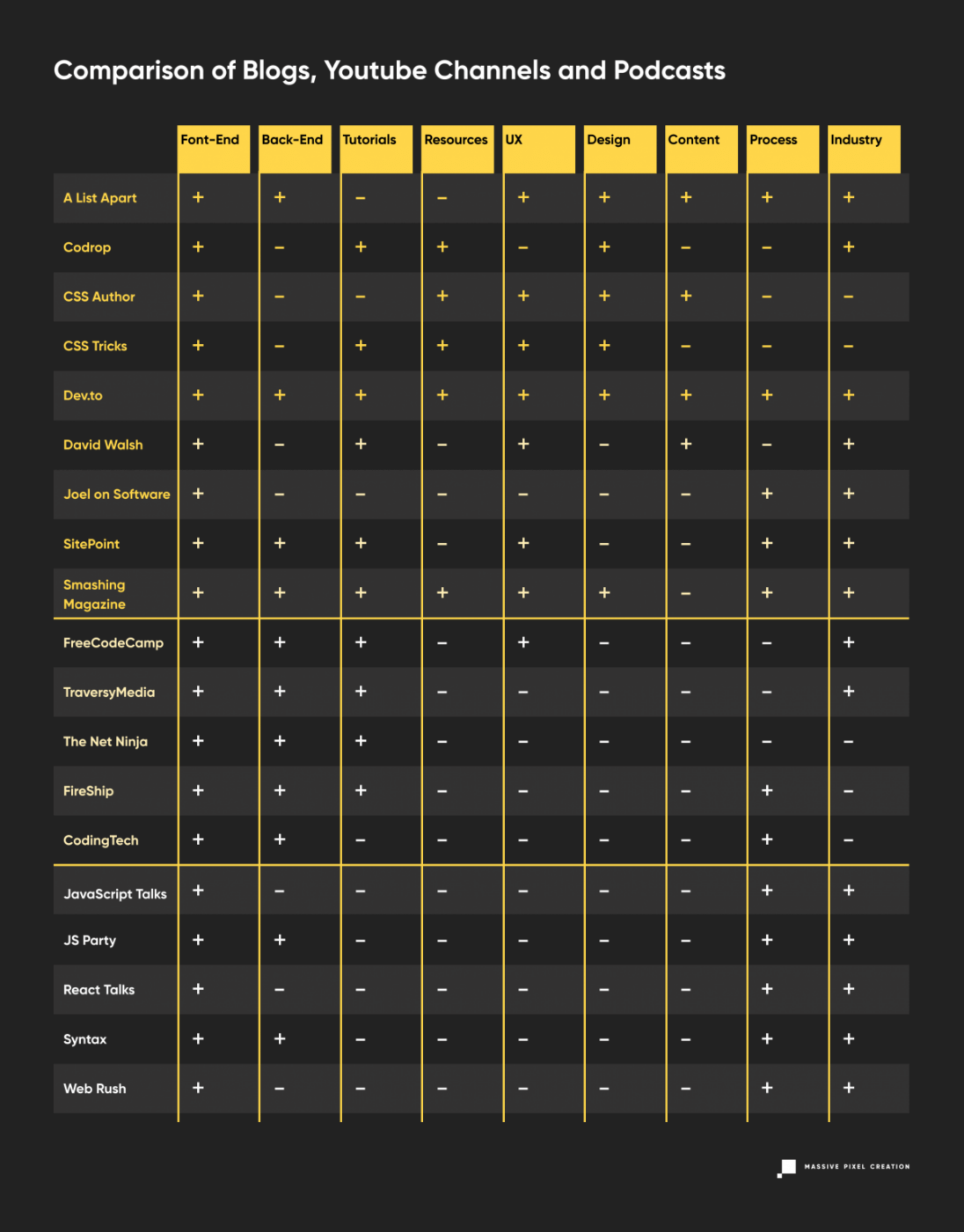
Following a web development blog — still a necessity
Minimal commitment in website design won’t cut it. You need to stay up to date, which may seem like a challenge in the field that just keeps growing and changing. And if you’re not a web developer, but a graphic designer or a content creator, or an owner of your own website, it’s good to be aware of what’s happening on that front. This way you’ll create better content, by knowing what’s possible, what are the restrictions of web design, and what doesn’t work well in the long run.
And if you’re at the point of your coding journey where you can call yourself a professional, consider setting up your own web development blog or at least contributing to one. It’s a great way of giving back to the community and helping out those who are just starting. If you’re worried about creating competition for yourself, don’t — keep in mind the ongoing shortage of IT professionals that threatens the entire field and contribute to a better world instead.

Software Development Plan Made Easy
The Nature of Software Development Projects The first issue concerning software development projects is the fact that many of them are unique. So unless you’re developing the exact same software over and over again, the parameters differ too much to use them as a one stable point of […]
BusinessThe Nature of Software Development Projects
The first issue concerning software development projects is the fact that many of them are unique. So unless you’re developing the exact same software over and over again, the parameters differ too much to use them as a one stable point of reference.
The second issue concerns the rapid evolution of technology. We don’t even have to go back 50 years for comparison — it’s enough to see how much has changed just in the last decade. Software development has no choice but to reflect that in the form of constant new programming languages, frameworks, libraries, and tools.
On top of that, clients’ needs along with market demands change as well. Suddenly, the websites have to be SEO friendly, their mobile versions need to be top–notch to satisfy the constantly raising market share of mobile devices, and web apps need to be restricted to one single page, following the example of Facebook and many other successful projects.
Also, it will be beneficial to follow mobile SEO strategies to enhance user experience and improve mobile conversion.
It’s a lot. Each project has the potential to bring something new, and the proposed solutions can’t always be based on experience gained by the years of delivering different software. That’s what makes software development’s estimations so difficult — there’s simply too much uncertainty and novelty to be able to properly assess each project.
That’s also the reason why being an optimist doesn’t pay off. Assuming that everything will go well with no delays, that there won’t be any bugs to fix or last–minute changes, is naive. By thinking of the worst–case scenarios, you can predict many issues and prepare for them in advance — for example, by adding time buffers in recognition of sick leaves developers might have to take.
To properly and masterfully manage all those unknown variables, Steve McConnel, an expert in software engineering and project management, introduced a concept known as the Cone of Uncertainty. It’s a model describing the level of uncertainty throughout the whole project — at the start, the level of uncertainty is huge. The more time passes though, the more data you gather and therefore, the more you know. And so the challenge lies in achieving that level of knowledge as fast as possible.
Software Development Project Plan
Software development plan describes what needs to be done and how in a clear, concise manner, so that the whole team knows their roles and responsibilities, but with enough flexibility to reflect the tumultuous nature of software development.
Instead of having one strict deadline for the whole project, it’s divided into smaller parts instead, and the success rate is measured by milestones. Depending on the type of Software Development Life Cycle, the whole process will include iterations, revisions, and feedback. So even though it may seem chaotic at first, the whole team, as well as stakeholders, will know the state of the project at all times.
How does the software development lifecycle differ from the software development plan? The former is a specific roadmap, describing all the steps and their order necessary to complete the project, while the latter focuses on explaining the scope of the project and all its circumstances. In short, a software development plan explains what will be done and why, while a software development lifecycle explains how it will be done.
Now that we got all that out of the way, let’s move on to the phases that will ensure a proper software development plan everyone can rely on.

Defining The Problem
The first phase starts the moment the client contacts a software house. During the first talks, besides deciding on terms of cooperation, the client should say:
- What software project do they want exactly,
- What problem it should solve,
- What demand it’s answering,
- What business objectives or specific goals hide behind that decision,
- What will be the criteria of project success.
The software house’s responsibility is to discern whether the project matches the business decisions.
Think of it that way — the client doesn’t come with a project idea, they come with a problem. The vendor doesn’t deliver a project: it delivers a solution. If the solution doesn’t solve the client’s problem, it’s a waste of money. Period.
Finding The Solution
This phase focuses on discovering what can be done to fix the problem and how. And also, whether it’s possible to do so in the first place with the client’s budget, time limit, and other restrictions. That’s within the vendor’s responsibility to figure out, with the client’s help.
Here’s a time for settling on the project’s scope. Besides focusing on the how, it also has to be decided with what — when it comes to tools, languages, resources — and who — when it comes to the members of the software development team, any external groups whose help is needed, and who will be the project manager.
When all of the above has been decided, it’s easier to give a rough estimate of the budget and first deadlines.
Perfecting The Idea
Before digging into details, it’s important to decide on the essential features of the software project (usually via workshops). All the nonessential features should be categorized as “nice–to–haves” to ensure the right order of priorities. If your software project looks modern and sleek, but doesn’t serve its intended purpose, it’s a failure.
Only then you can start creating all the wireframes, user stories, and prototypes. Due to that, you can check if everyone’s on the same page, deal with any misunderstandings or dispel any doubts, as well as assess the risk. This part is also crucial to collect all the feedback you possibly can — mainly from the stakeholders and project team members.
At this point, a final estimation is possible: the scope of the project, the timeline, budget, and so on. There are still uncertain variables in play though: while the scope of the cone of uncertainty is smaller at this stage, it’s still significant enough.
Preparing The Environment
Once the whole scope of the project is known and understood by all, it has to be broken down into smaller phases that end with milestones. A good example of this is sprint, frequently used in agile development, which is a small time–boxed period with set tasks to complete. Sprint is repeated as many times as it’s necessary, till the project’s completion.
This approach ensures constant revision of what’s been done and what’s still left to do, making it easier to control and manage. Those frequent progress checks are also more convenient for stakeholders, who are kept in the loop throughout the whole project.
The biggest upside of creating such a project schedule is its flexibility. It’s easier to implement any change requests, catch glaring mistakes quickly, and to improve the software development process itself at any moment. Most importantly, it makes it simpler to check whether the product delivers significant value to the end–users.
Execution
Once everything on the project organization side is complete, it’s time for the developers to bring the idea to life. It’s also a good moment to set quality assurance in place, if it hasn’t been yet, to simultaneously fix bugs and any other reported issues. Additionally, you can also include User Acceptance Testing (if that’s applicable to your circumstances) or even involve your client in the final testing stages.

Delivering The Answer
At this point, software projects should be done with optional last–minute tasks and bug fixes left to do. But this stage should mostly focus on the release of the product and all the supporting processes surrounding it. Those can be: connecting the domain, activating the website’s certificates, adding payment features, and so on.
See also: How to Buy a Domain Name
All the results should be observed and analyzed, gathering feedback from users and responding to it. Especially if the product is in its beta version, it’s important to check how the users interact with the software, whether it serves its purpose, and if it’s up to everyone’s expectations.
The last thing left to do is the handover. The whole project needs clear and completed documentation, explaining the whole work done and the current state of the product. It ensures that in case of any future development needed, whether it’s further improvement or simple changes, the new development team will be able to jump right to work, without having to waste time to figure out the code. That’s why it’s also necessary for the code to be fairly clean and straightforward.
Common Mistakes In Software Development Planning
Since we know now how to construct a good software development project plan, it’s also proper to know what to avoid. The pitfalls tend to happen on both sides, on the client’s side as well as the vendor’s. Here’s a brief description of what can negatively influence the whole collaboration:
Client’s Perspective
- Lack of understanding and knowledge of software development process that leads to unrealistic expectations,
- Demanding drastic changes halfway through the project that go against initial principles,
- Not being clear enough on the requirements, needs, and goals,
- Too many people in decisive roles wanting different things and trying to answer the question of how to resolve the problem instead of sharing common goals.
Software Development Company’s Perspective
- Overpromising while overestimating capabilities and experience while not taking into account uncertainties,
- Bad communication with developers on the sales’ department side,
- Bad internal communication between team members,
- Putting up a wall between the client and the development team (often in the form of unnecessary middlemen),
- Not including any buffer in the schedule for fixes, unexpected issues, holidays, and sick leave,
- Neglecting to carry out tests with end–users before the release.
Key Takeaways
A good software development plan should include answers to the following questions:
- What problem does your client want to solve?
- What business results does the client expect?
- What can be done to resolve the client’s problem?
- Is it possible to resolve the problem within the client’s means?
- How can it be resolved?
- What resources are needed to resolve the problem?
- How will the development process look like?
- How will the project’s progress be measured?
- Was risk assessment conducted?







